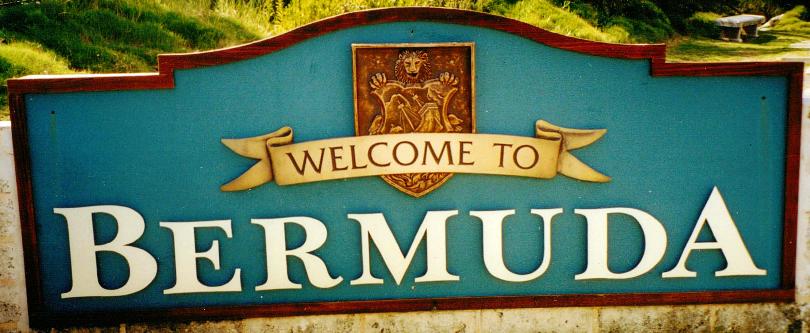
![]()
By Keith Archibald Forbes (see About Us).
|
See end of this file for all of our many History files1939. June.1939. June. |
1939. May. An Examination Service was established for merchant ships to enter Bermuda's ports, staffed by locally entered Reserve Officers. Its purpose was to stop and investigate the papers of all merchant shipping and other non-local vessels not equipped with proper recognition signals that had been issued. Once vetted they were given a two-flag clearance signal for the day and allowed to proceed. If any vessel failed to comply the officer commanding the Bermuda Militia Artillery (BMA) unit based at Fort St. Catherine that manned the guns that were aimed out to sea was empowered to open fire, not to warn but to destroy the vessel concerned. A trail run using Royal Navy ships based in Bermuda as "blockade runners. Bermuda's Governor participated. He was in the Pilot Boat to witness the exercise. It was a foul day weather-wise, He was recorded as having left in a hurry after experiencing seasickness.
1939. June. Construction of brand-new Royal Naval Air Station on Boaz Island. As part of the preparations for World War 2, the increased workload at HMS Malabar caused problems due to the limited space available. With so many of the locally-based or in-transit Royal Navy warships carrying catapult-launched seaplanes such as the Hawker Osprey, Fairey Seafox and Supermarine Walrus seaplanes, the need for prompt, efficient and spacious aircraft maintenance was a high priority. Thus, the new station was built. Its primary role was the servicing, repair and replacement of spotter floatplanes and flying boats belonging to naval vessels. Early in the Second World War, with no other units to fill the role, aeroplanes from Boaz Island were used to maintain anti-submarine air patrols, using whatever aircrew were on hand, including from 1940 pilots from the Bermuda Flying School on Darrell's Island. It had two good-size hangers and launching ramps on either side of the island and they allowed continuous operation in any wind direction. With the Battle of the Atlantic over, the station was reduced to care and maintenance status in 1944. Some remnants still survive but all that remains of the Fleet Air Arm facility today is a hangar on runway road, and two slips.
1939. August 1. A new battery of two 6" guns was constructed at Warwick Camp. Despite this, the manpower requirements of the BMA simply did not make full use of the number of black males available for military service with war imminent.
1939. August, Rather than integrate the Bermuda Volunteer Rifle Corps (BVRC) or the Bermuda Volunteer Engineers into a single unit it was decided to raise a second infantry unit, the Bermuda Militia Infantry (BMI), to recruit blacks, and this was grouped administratively with the BMA.
1939. August 23. HMS Evadne, an armed yacht, became the new name of what was earlier the Evadne prominent in Bermuda waters before and at the outset of the war. She the pre-war pleasure palace of Sir Charles Richard Fairey, MBE, FRAeS, the famous British aircraft designer and founder of the Fairey Aviation Company who owned a home in Bermuda. She was custom-built in 1931.
1939. August 24. A formal State of Emergency was declared in Bermuda, a week before World War 2 began. The Emergency Powers Act was enacted by the House of Assembly to counter espionage and subversion. Major Eric A. T. Dutton, then Colonial Secretary, ordered the embodiment of the Bermuda Militia Artillery including to man the gun battery at St. David's, then Bermuda's only coastal defense area, and to implement and if necessary enforce by firepower from September 1, 1939, the nautical Ship's Examination Service. Bermuda Volunteer Engineers and Special Constabulary (later, the Bermuda Reserve Police). Guards were placed at all key buildings including the House of Assembly. The Bermuda office of telegraph and cable company Cable & Wireless (West Indies) Ltd was ordered to operate 24 hours a day to keep Bermuda, with its key Royal Navy Dockyard and other British military units then based in Bermuda, in touch with the rest of the free world and particularly with London. The State of Emergency also required all persons traveling to Bermuda to have a passport and if they were Americans or other non-British citizens, to have a visa issued by British Consular authorities in New York or elsewhere. (But see October 1939).
1939. With World War 2 imminent for Britain, a 99 year lease was granted by the UK to the USA for land bases at St David's Island and Morgan and Tucker's Islands.
1939. Warwick Camp in Warwick Parish was fortified, to help defend the Dockyard against potential German raiders.
1939. August 25. An announcement was made that the Furness Bermuda Line's lovely cruise ship Queen of Bermuda would be withdrawn from civilian service and put into military use within the week.
1939. August 28. The Queen of Bermuda left Hamilton for New York at her usual time but almost 10 years would pass (until February 1949) before she carried another passenger to Bermuda.
1939. August 30. On arrival in New York on the morning, 700 passengers from the Queen of Bermuda were disembarked as usual, but the usual bustle of preparing the ship for another batch of holiday-makers was missing.
1939. August 31. The Queen of Bermuda ocean liner sailed from New York under sealed orders received by her captain from the British Admiralty. As the liner sailed down the Hudson River, every Allied vessel in port gave her the traditional three blasts as she passed by on her way to war. She was en route to a shipyard in Belfast, Northern Ireland, where she would be stripped of her opulence and fine furnishings and many special timbers and re-emerge as a utility auxiliary requisitioned British warship.
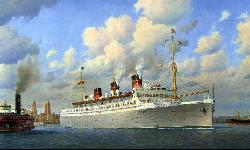
1939. September 1. World War II was announced. With it, the United States and Great Britain curtailed or abandoned their submarine commerce raider programs, partly out of fear that Japan, the rising sea power in the Pacific, might emulate the weapon if it proved successful.
1939. September 1. Protected by the guns of Bermuda Militia Artillery (BMA) based at and manning the gun battery at St. David's, the nautical Examination Service began, two days before the declaration of war. Its mission was to ascertain the identity and propriety of all vessels seeking to enter any port or any other part of Bermuda. The BMA, Bermuda's only gunners, operated the only operational guns in the whole of the island. It was a single battery of three officers and 103 other ranks, with a commandant and adjutant from the Royal Artillery (RA) and with 11 other ranks from the RA as instructors and equipment maintenance personnel.
1939. September 2. Sinking by the German Navy of the British ship SS Athenia while en route from Glasgow to Canada, before WW2 started and what happened as a result in Washington DC and Glasgow because of a number of Americans on the ship, some of whom died.. See https://www.bbc.co.uk/news/uk-scotland-glasgow-west-49557543.
1939. Sunday, September 3. At 07.52hrs local time the Signals Duty Officer on the British Cruiser HMS York, then serving with the 8th Cruiser Squadron on the Royal Navy’s America and West Indies Station, received a coded message on the ship’s W/T set from HM Dockyard in Bermuda; ‘COMMENCE HOSTILITIES AT ONCE WITH GERMANY’. After an interlude of just 21 short years Great Britain, His Majesty’s possessions overseas and thus Bermuda were once again at war. This new conflict would last almost six years and would see Britain brought to the very brink of defeat before she and her allies eventually triumphed over the fascist menace. It would bring enormous geo-political changes and, perhaps of more importance to the millions of ordinary people who would be called to arms, colossal socio-economic changes. At 9 am Bermuda time, a telegram received by the Bermuda Governor and then the Bermuda Government from the UK's Secretary of State from the Colonies confirmed that Great Britain and therefore all members of the British Commonwealth of Nations including Bermuda were at war with Germany.
The pre-planned War Boards ordered by the Bermuda Government were immediately activated. Members of the then-white Bermuda Volunteer Rifle Corps (BVRC) were summoned to report by 1130 hours to the Armoury on Reid Street, Hamilton. There, Royal Army Service Corps trucks delivered equipment from the British Army's Bermuda headquarters at Prospect. Tucker's Town was garrisoned, as the Bermuda site at Cable Hut of the transatlantic telegraph cable. Darrell's Island was taken over as a Royal Air Force station, with two RAF commands, RAF Transport Command and RAF Ferry Command, operating on and from it.
Men of the then-resident King's Shropshire Light Infantry then posted to Bermuda under the command of Major Hughes-Hallet, dug entrenchments and other defensive works including a gun emplacement site facing the sea at their Warwick Camp, until relieved on September 4 by the BVRC. RAF Air Transport Command operated large, multi-engine flying boats, carrying freight and passengers between Europe and the Americas. RAF Ferry Command was responsible for delivering airplanes from manufacturers to operational units. One of the first to enlist in the Bermuda Militia and Bermuda Contingent of the Caribbean Regiment was William Edwin Smith, nephew of the man by the same name who was the first black Bermudian killed in action in the Great War 1914-1918. As the requirements of the RAF and Fleet Air Arm could not be filled by the output of British factories, the Air Ministry in London placed orders with manufacturers in the neutral USA for all manner of aircraft. These included flying boats, like the PBY Catalina, which, designed for long-range maritime patrols, were capable of being flown across the Atlantic, albeit in stages. Imperial Airways, which had become the British Overseas Airways Corporation (BOAC), continued to operate in Bermuda throughout the War, as well, though in a war-role, with its new Boeing flying boats painted in camouflage. A Bermuda Government station began operating from a studio in the Walker Arcade in Hamilton. (It finally went off the air in 1944).
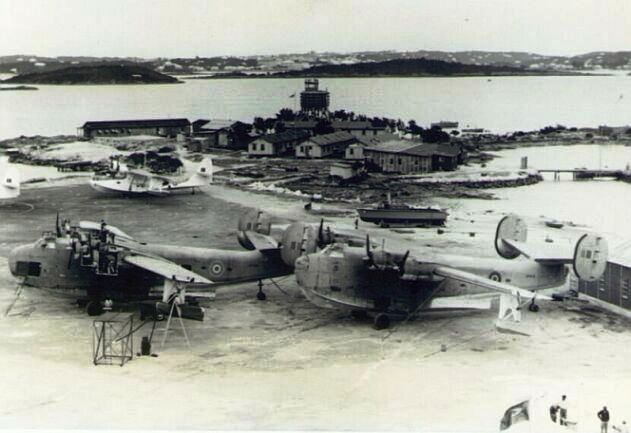
Royal Air Force at Darrell's Island
1939. September 3. Forces throughout the Empire were mobilized, in anticipation of the declaration of war. Unlike in the Great War, when the two local units relied entirely on volunteers, conscription was introduced soon after the outbreak of hostilities, with blacks directed into the BMA or BMI, and whites into the BVRC. Volunteers and conscripts served full-time for the duration of the War.
1939. There were two air stations operating in Bermuda at the start of the Second World War, the civil airport on Darrell's Island which was taken over by the Royal Air Force for the duration of World War 2, and the Royal Naval Air Station on Boaz Island. Both were limited to operating flying boats as Bermuda's limited and hilly landmass offered no obvious site for an airfield.
1939. September 4. The British and local colonial governments published strict currency control edicts and mandated that the new Food and Supplies Control Board would have oversight of all food and supplies, local and imported.
1939. September 8. Bermuda's Executive Council rejected a proposal to beef up the strength of the still-under-strength all-white BVRC, then with 450 men, to add a black company.
1939. September 13. The Furness Bermuda Line's cruise ship Monarch of Bermuda left Bermuda for the last time, never to be seen there again. She was taken over for wartime merchant ship duties and later used as a troopship, but in any event, since the outbreak of the war, with both the UK and Bermuda at war, was then useless as a Bermuda cruise ship. It was because of then-existing US legislation that barred American citizens from traveling in British-flagged or other warring countries ships.
1939. September 14. Two information officers, William E. S. Zuill and Canon Thomas, were appointed by the Bermuda Government. Their job was to explain to the public the policies of the newly-formed Nautical Examination Service and to deal with news releases from the UK's Ministry of Information.
1939. September. Bermudian John Brewer died after crashing in German enemy territory while fighting for Britain. He was a flier in the Royal Air Force.
1939. October 6. Establishment of Bermuda Militia Infantry (BMI) as a direct result of the war then in progress. It was created at St. David's Battery under Lieutenant J. T. O Redmond, Bermuda Volunteer Rifle Corps (BVRC), assisted by newly commissioned 2nd Lieutenants J E. R King and W. W. Fuller.
1939. October. Because stringent British War Office requirements in this regard had such a negative impact on their economics and tourism, both the Bermuda and the Bahamas legislatures jointly asked for and were granted by the UK's Foreign Office exemption from the requirement that Americans too needed passports to enter their islands. But this proved to be both temporary and not successful in reducing unemployment. (The decline in tourism continued until the late 1940s. The only good effect it continued to have was that for over 50 more years, bona fide American visitors were not required to have passports).
1939. Bermuda, already an important British naval base, became a a key Royal Navy Atlantic port. (Later, countless thousands of seamen and civilians were rescued at sea from vessels torpedoed by the German Navy). The anomaly in the command structure referred to in 1933 was rectified when this part of the Royal Navy Dockyard was transferred to the FAA and given the name of HMS Malabar.
1940. January. 112 bags of mail were taken by Bermuda-based censors sent out from England from a Pan American Airways flying boat. They included securities and large money transfers and even packages of diamonds.
1940. January 27. With guns installed, HMS Queen of Bermuda set sail for the River Plate of Graf Spee fame and the South Atlantic Command. Thereafter she spent 1940 patrolling the cold and turbulent waters of the South Atlantic visiting the isolated Tristan da Cunha and Falkland Islands.
1940. March 4. The New York newspapers announced that its two cruise ships in the Caribbean service would add Bermuda as a port of call. It was to apply to all voyages beginning with the departure of the Santa Paula that Friday 1940. March 31. An organization of patriotic British Bermudian ladies formalized their operation begun at the outbreak of the war of their Ladies’ Hospitality Organization (LHO) at the Bermudian hotel. Their first formal action was the creation of the Naval Recreation Rooms at the hotel, as a place of relaxation and recreation for naval ratings and other non-commissioned ranks of the Royal Navy. The ladies received the active support of the Furness Withy Line which then owned the hotel and its subsidiary Bermudiana Hotel Company. The LHO was constantly active with all sorts of events including beach parties. Afternoon and evening groups were organized to prepare food for the visitors and a library, canteen and a Sunday Evening Sing Song were common. Founding members of the group included Mrs Appleby, Mrs Blee, Mrs J. R. Bridge, Mrs Alice Britton, Mrs Butterfield, Mrs Christiansen, Mrs Ruth Fountain, Mrs Edmund Gibbons, Mrs Harnett, Mrs Gosling, Mrs Harvey, Lady Kennedy Purvis, the Admiral’s wife at Bermuda, Mrs. Parker, Mrs A. B. Smith, Mrs Talbot and others. They often worked in association with the Sailors’ Home.
1940. March 31. Opening at the Bermudiana Hotel of the Ladies’ Hospitality Organization (LHO) Naval Recreation Rooms. By then the LHO, formed in September 1939, included a number of illustrious older and spirited younger women then living in Bermuda. The idea of a centre for recreation originally started with a group including Mrs J. R. Bridge, Mrs Alice Britton and Mrs Ruth Fountain, Mrs Edmund Gibbons. The Naval Recreation Rooms were for the men of the lower decks of His Majesty’s Ships and other Allied vessels of war visiting the island. One such lady was Blanche (Dimpy) Ingham, the daughter of Willie and Bess Ingham, then 19. Along with her older sister, later Ruth Redfern, she made sandwiches, checked hats and did other necessary administration matters and then came from behind the counter to dance, where one evening she met her future husband, stationed at Bermuda with the Royal Canadian Navy. Beach parties were also organised, as well as visits to houses of Bermuda families, for one of the main reasons for establishing the LHO was to give the lower ranks on the ships a bit of a sense of home life and to provide entertainment and interests for those who had little money to sit at the main bars of the Bermudiana or other hotels and clubs. By this date the LHO included Lady Kennedy Purvis, the Admiral’s wife at Bermuda, and a Mrs Blee and other goods and greats, including a Mrs Blee. For a period, Mrs Gibbons served as Chairman, wives whose married names came from prominent local families such as Appleby, Butterfield, Christiansen, Gosling, Harnett, Harvey, Parker, Talbot and more. The LHO often operated with the Sailors Home. Afternoon and evening groups were organised to prepare food for the visitors and a library, canteen and a Sunday Evening Sing Song was instituted.
1940. April 14. the pre-war Bermuda liner Monarch of Bermuda delivered Scots and Irish Guards detachments to Narvik in Norway.
1940. The Hamilton Princess Hotel was closed for the duration of Word War 2 by order of the British Government. American residents and visitors left the Island in droves. (The hotel, for its exploits after June 1940 with the censors, was re-opened after 1945 by the British Government with the nickname, "Bletchley in the Tropics" after Bletchley Park, the name of the English country house where Britain's spymasters had their HQ and where the "Enigma" code was broken. )
1940. May. Bermuda became a Convoy Assembly Port, with the result that The Naval Control Service was established which incorporated the Naval Examination service established in May 1939. Sailing day for the convoys that began in Bermuda, involving vessels carrying food and other goods for the UK were usually about every fourth day. Outgoing convoys were given priority over incoming convoys. The latter had to heave-to off Five Fathom Hole under the eye of one Examination vessel while the other vessel ferried pilots to and from the ships leaving, as there were seldom enough pilots to go around.
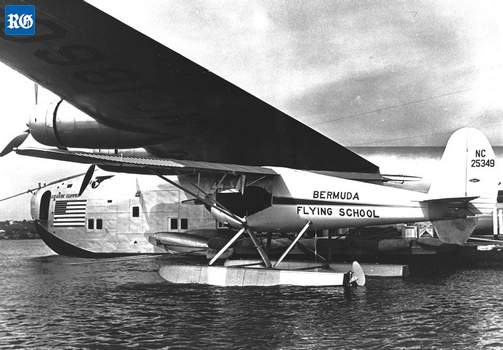 1940. May. The Bermuda Flying
School (BFS) was officially established on Darrell's Island with the goal of training
pilots for the Royal Air Force (RAF) or the Royal Navy's (RN) Fleet Air Arm
(FAA). The school trained
volunteers from the local territorial units using Luscombe seaplanes (see
photo) paid
for by an American resident of Bermuda, Mr Bertram Work, and a Canadian, Mr
Duncan MacMartin. Those
who passed their training were sent to the UK's Air Ministry to be assigned, as
promised, to
the Royal Air Force (RAF) or the Royal Navy's Fleet Air Arm (FAA).
1940. May. The Bermuda Flying
School (BFS) was officially established on Darrell's Island with the goal of training
pilots for the Royal Air Force (RAF) or the Royal Navy's (RN) Fleet Air Arm
(FAA). The school trained
volunteers from the local territorial units using Luscombe seaplanes (see
photo) paid
for by an American resident of Bermuda, Mr Bertram Work, and a Canadian, Mr
Duncan MacMartin. Those
who passed their training were sent to the UK's Air Ministry to be assigned, as
promised, to
the Royal Air Force (RAF) or the Royal Navy's Fleet Air Arm (FAA).
The Commanding Officer of the school was Major Cecil Montgomery Moore, DFC, earlier the senior officer of the Bermuda Volunteer Rifle Corps, who had gone to the UK to serve as a fighter pilot during the First World War and who was also the commander of the Bermuda Volunteer Engineers. The chief flying instructor was an American, Captain Ed Stafford. The first class, of eighteen students, was in training by May 1940. On 4 June, Fenton Trimingham became the first student to solo. Ten Bermudian companies agreed in June 1940, to defray the expenses of ten of the students. They were the Bank of Bermuda, the Bank of N.T. Butterfield, Trimingham Bros., H.A. & E. Smith, Gosling Bros., Pearman Watlington & Company, the Bermuda Electric Light Company (BELCO), Bermuda Fire & Marine Insurance Company, the Bermuda Telephone Company (TELCO), and Edmund Gibbons.
The school trained eighty pilots before an excess of trained pilots led to its closure in 1942. The body administrating it was adapted to become a recruiting organisation for the Royal Canadian Air Force (RCAF), sending two-hundred aircrew candidates to that service before the war's end. The BFS only accepted applicants who were already serving in one of the part-time units, which had been mobilized for the duration of the war. Successful students were released from their units and allowed to proceed overseas. With the moratorium against sending drafts overseas, this meant local soldiers came to see the BFS as the easiest way of reaching sharper ends of the war. The BFS was included in the Empire Air Training Scheme for British Commonwealth pilots. Its graduates included eight Americans, who had volunteered for the RAF in the USA, and had then been sent to the BFS for training. Photo above right: Bermuda Flying School Luscombe parked next to a PAA aircraft.
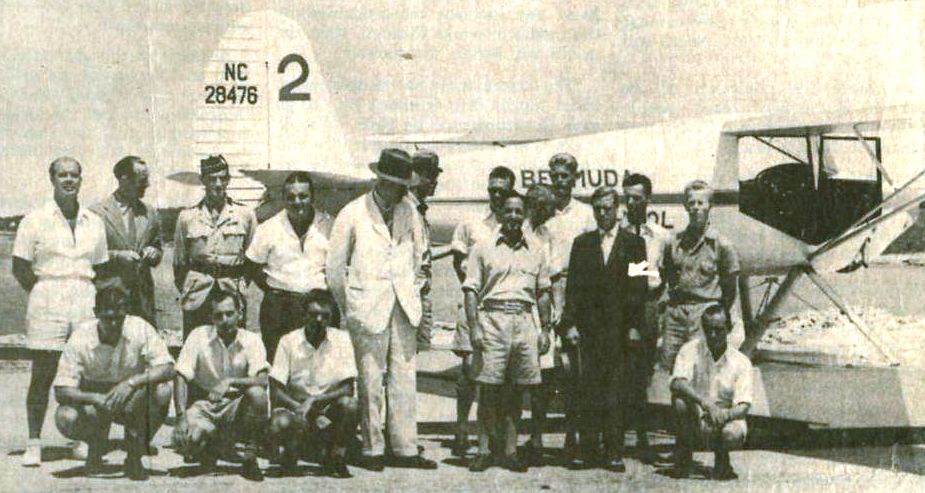
Photo above shows then-Duke of Windsor, third from right, in dark suit, formerly King Edward VIII, in Bermuda before he was sent as Governor of the Bahamas, inspecting the new Bermuda Flying School.
1940. May. Newly installed British Prime Minister Winston Churchill personally dispatched Canadian-born William Stephenson, then working in London and by then a close confidante and one of his most reliable private sources of information on secret German rearmament programmes, to New York with the cover title of British passports control officer. Working out of offices in Rockefeller Centre, the original mandate of Sir William’s covert British Security Coordination organisation was to facilitate co-operation and the exchange of information between the various British intelligence agencies operating in the Western Hemisphere and authorities in the still-neutral United States. The role quickly expanded under the pressure of wartime conditions, with Sir William soon overseeing British efforts to blunt Nazi espionage, sabotage and propaganda activities in the United States during the early years of the conflict. One of his key weapons in this regard was to be the work of the Bermuda censorship station. This became hugely significant because since before the start of WW2 and also during it at that time and until the end of the war in 1945, Bermuda was a staging point for regular US-European flying boat services operated by Pan American World Airways and Britain’s Imperial Airways, with the bulk of transatlantic air mail passing through the island. Bermuda was a geographically convenient location for the scrutiny of mail exchanged between North America and Europe. All correspondence sent to or from Europe was destined to be examined by Imperial Censorship staff based at the Hamilton Princess Hotel, and suspect items were intercepted and photographed. This led to the identification of several important German spies and spy rings operating in North America. Ultimately, some 1,500 British intelligence officers and code breakers descended on Bermuda to staff the Imperial Censorship station, many of them women — and jokingly dubbed “Censorettes” after the high-kicking Radio City Music Hall precision dancers, the Rockettes. Sir William, knighted in 1946 by the British, in addition to investigating enemy activities and mobilizing pro-British opinion in the US, served as an unofficial liaison between Churchill and President Franklin D Roosevelt, supervised training of Americans for intelligence work, operated spy networks which uncovered Axis activities in South America and provided valuable information to Washington and London on the movements of pro-Nazi Vichy French operatives.
1940. May 23. US Secretary of State Cordell Hull implored Canadian Prime Minister MacKenzie King to act as an intermediary on America’s behalf and persuade King George VI to evacuate from a beleaguered Britain — then vulnerable to a Nazi invasion — and relocate to Bermuda for the duration of World War Two. It was less than two weeks after Winston Churchill had succeeded Neville Chamberlain as Britain’s wartime leader. At that time, while Britain and her Commonwealth Allies were at war, Both President Roosevelt and Mr. Hull privately believed America could not maintain its neutrality indefinitely in the face of widespread Nazi aggression. Hull had stated in an address to Harvard University that there was no more dangerous folly than to think that America’s achievements can be preserved by isolation. But he and the President were then hesitant to openly side with Britain in the early years of World War Two given the strength of the isolationist lobby — born in the aftermath of the First World War [1914-1918] when the failure of Washington’s allies to pay their war debts resulted in many Americans turning their backs on the rest of the world. Hull made the plea when Franco-British forces were falling back on the French port city of Dunkirk in the face of the invading German army’s relentless Blitzkrieg strategy and had already started to plan to evacuate across the English Channel. Joseph Kennedy — the US Ambassador to Great Britain and father of future President John F. Kennedy – was reporting back to the State Department that the United Kingdom was unlikely to be able to continue the fight against Nazi dictator Adolf Hitler’s tyrannical regime for more than a few weeks once France fell. King was telephoned by Cordell Hull, who expressed concern at the gravity of the present situation and requested that someone be sent from Ottawa to Washington for a discussion with him and someone higher up. That person higher up was President Franklin Roosevelt. Hugh Keenleyside, of Canada's Department of External Affairs, was sent. He reported back on May 26. King recorded in his diary his abhorrence at the position put forward by the Americans. They had decided that the French would not be able to hold out, and that Britain would not be able to bear up against the stronger German air force. Their information was that Hitler might make an offer of settlement, which would be based on Britain turning over of the whole of its empire and fleet to the Germans. The Germany navy, combined with the British navy and the French fleet, would then be much superior to the US navy. The Americans requested that King line up the [British] Dominions [in 1940 they were Canada, Australia, New Zealand, Newfoundland and South Africa] to bring concerted pressure to bear on Britain to not make a soft peace with Germany, even though it might mean destruction of the country. The American proposal, which they wished King to claim as coming from Canada, and not the United States, was that if it seemed likely that Britain was going to be defeated, then its fleet should retreat, so that it could still operate from a base away from Britain, and King George should go to Bermuda. The United States would open her ports to repairs for the British fleet, and in this way, a cordon, from Greenland to Africa, could be thrown around Germany. Though it might take a couple of years, Germany would be defeated in the end.
1940. May 30. Canadian Prime Minister MacKenzie King sent Mr. Churchill a “Most Secret” message by cipher in which he assured him of Canada’s ongoing support despite the serious reversals in France. He also gingerly raised the American suggestions about relocating both the British fleet and the King, his wife Queen Elizabeth and daughters Elizabeth — the current Queen — and Margaret Rose to Bermuda in the event of a Nazi invasion. This message came as the German juggernaut continued to thunder across France and Churchill had just began the withdrawal of the British Expeditionary Force along with French soldiers across the Channel from Dunkirk. Aided by the Royal Air Force, and with fog hampering German aircraft, a flotilla of some 900 ships — including some sailboats — evacuated 338,000 Allied troops in the period from May 27 to June 4. Thus occurred what subsequently became known as the “Miracle of Dunkirk.” France surrendered to the Germans on June 10.
1940. June 8. Flying Officer Herman Francis Ede DFC, Royal Air Force, of Bermuda, was killed in action. He was the first Bermudian killed in action during World War 2. Following the German invasion of Norway in April 1940, Ede was flying Gloster Gladiators with the RAF's 263 Squadron in Norway protecting the fleet anchorage at Skånland. On 2 June 1940, the squadron was ordered to prepare for evacuation. Along with the remaining members of his squadron and 10 aircraft, Ede embarked on HMS Glorious on 7 June. The next day, Glorious, along her escorts Ardent and Acasta, were sunk by the German battleships Scharnhorst and Gneisenau. Ede was just 23 years old, the son of the late Lieutenant Commander Ernest Grant Ede (killed in action during World War 1) and Winifred Louise Ede, of Pembroke, Bermuda. His name is inscribed on the 5th Panel at the Runnymede Memorial, Berkshire, England.
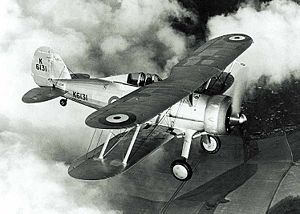
Gloster Gladiator biplane, of the type flown by Ede.
1940. June. The BVRC sent a small contingent of volunteers to the Lincolnshire Regiment depot in England. A handful of volunteers from the BMA and the BVE travelled with them, separating in England to join the regular artillery or engineers. The BMA contribution to that contingent consisted of a single officer, Lieutenant Patrick Lynn Purcell, who, like most of the BMA's white officers, had begun his service in the ranks of the BVRC. (Purcell would serve with the a coastal artillery detachment of the Royal Artillery in Sierra Leone, due to his similar experience with the BMA. He eventually transferred to the Lincolnshire Regiment, serving in North West Europe, and, having reached the rank of Major, being appointed Press Officer of the British Area of Occupation in Germany, following victory in Europe). The 1940 contingent was to be the last from Bermuda for nearly four years.
1940. July 1. The Naval Examination's Service's old and faithful vessel from then on was commissioned as HMS Castle Harbour and from then on flew the White Ensign, commanded by an officer in the Royal Naval Reserve. She was also armed with an old 3-pounder gun, depth charges to enable her to operate as an ant-submarine vessel and fitted with Asdic. From this time on, the role of Examination vessels and Anti-Submarine vessels were combined and HMS Castle Harbour began a continuous patrol during daylight hours.
1940. July. Bermudian Lieutenant Montgomery-Moore was promoted to Major, and Bayard Dill to Captain. In addition to his role with the Bermuda Volunteer Engineers (BVE), Montgomery-Moore also headed the Bermuda Flying School, which trained 80 local volunteers as pilots for the RAF and the Fleet Air Arm. Volunteers were only accepted from those already serving in the local forces, some of whom came from the BVE.
1940. July. Censors arrived from England and via them Bermuda played a unique role in World War 2. They came because Bermuda lay at the crossroads of the Atlantic. Flying boats or clippers flying back and forth across the Atlantic, had to stop in Bermuda to refuel or wait out the weather, particularly during the winter months when the gales blew across the ocean. Censors also helped plug a big hole in Bermuda’s tourism income when the British decided to upgrade the tiny mail censorship department in Bermuda consisting of a few local postmen, to a force to be reckoned with. Also, Bermuda was an important rendezvous for wartime convoys. Another important advantage was it was safe from the chaos and danger of air raids. For these reasons the hub of the British Censorship Department was moved from Liverpool to Bermuda. Hundreds of British censors and examiners began to move into the Princess Hotel (and the Bermudiana Hotel which was used purely for housing). At one point, there was talk of bringing as many as 3,000 censors to Bermuda. There was a protest from Bermuda, because that many censors would put a tremendous burden on the Island’s food and water supply, so the plan was abandoned and there were probably never more than 700 here at one time. At any rate, the Hamilton Princess became the HQ of British Atlantic and North American postal censorship activity, intense intelligence operations for the British Government in Bermuda, much to the annoyance of some anti-British, pro-German Americans whose ships and aircraft were subject to scrutiny. The censors used basement rooms in the hotel and depended greatly on British Intelligence reports. It led to the post-war publication of The Princess Spies by CIA Officer Thomas F. Troy who died in 2008. It was an article, not book. (It's possible, perhaps even likely, the Hamilton Princess Hotel has a copy, given its involvement. If so, it might be available there for inspection). The operation at the Princess Hotel, near Hamilton, Bermuda was essentially the filter through which all correspondence in the Western hemisphere was inspected. To the average person during World War Two, censorship during times of war was a routine activity. It didn't generate much interest. And that's exactly how British Intelligence authorities wanted it to look because behind the walls of 13 rooms within the hotel, top secret sleuthing, a la James Bond, was taking place. Even the majority of the "examiners" didn't know what went on behind closed doors.
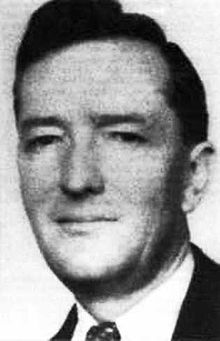 Under the leadership of British
Intelligence officer William Samuel Stephenson, (see
photo right) a Canadian some say was one of the
real-life inspirations for the literary and movie super-spy James Bond, the
co-ordination of the secret "offensive" censorship took place. Senior
Representative of British Intelligence, Sir William Stephenson, code name
"Intrepid," also helped to trap German spies and agents in the US. Stephenson reported directly to
Bletchley Park. The British-Canadian and his team thus helped uniquely to frustrate the operations
of Hitler. Espionage experts used technologically-advanced
techniques to break into letters and packages in order to produce and plant forgeries useful in propaganda and blackmail operations.
The technique of prying open sealed envelopes without leaving a trace required a
mastery of the process. The
group of experts were then able to obtain the contents of any package leaving no trace
of their tampering. Using innovative techniques for the time they could even
extract a letter from an envelope without cutting, steaming or replacing it
with a forged replica. "Duff" was the name used for enemy agents
to use a microdot method of slipping information through the mail. It involved
photographically shrinking a typed page to the size of an ordinary typewritten
punctuation mark. A German Professor Zapp was the inventor of the simplified
process of micro-photography, a process commandeered by the German government.
Huge quantities of classified and/or highly secret both technical and
militarily-sensitive information were sent by airmail. In Latin America alone,
trade and technical journals were smuggled into Mexico and sent to European
cover addresses in the form of dots. Diagrams and chemical formulas were changed
to dots, twenty of more to each letter.
Under the leadership of British
Intelligence officer William Samuel Stephenson, (see
photo right) a Canadian some say was one of the
real-life inspirations for the literary and movie super-spy James Bond, the
co-ordination of the secret "offensive" censorship took place. Senior
Representative of British Intelligence, Sir William Stephenson, code name
"Intrepid," also helped to trap German spies and agents in the US. Stephenson reported directly to
Bletchley Park. The British-Canadian and his team thus helped uniquely to frustrate the operations
of Hitler. Espionage experts used technologically-advanced
techniques to break into letters and packages in order to produce and plant forgeries useful in propaganda and blackmail operations.
The technique of prying open sealed envelopes without leaving a trace required a
mastery of the process. The
group of experts were then able to obtain the contents of any package leaving no trace
of their tampering. Using innovative techniques for the time they could even
extract a letter from an envelope without cutting, steaming or replacing it
with a forged replica. "Duff" was the name used for enemy agents
to use a microdot method of slipping information through the mail. It involved
photographically shrinking a typed page to the size of an ordinary typewritten
punctuation mark. A German Professor Zapp was the inventor of the simplified
process of micro-photography, a process commandeered by the German government.
Huge quantities of classified and/or highly secret both technical and
militarily-sensitive information were sent by airmail. In Latin America alone,
trade and technical journals were smuggled into Mexico and sent to European
cover addresses in the form of dots. Diagrams and chemical formulas were changed
to dots, twenty of more to each letter.
To discover the message, which had punctuation dots scattered throughout the letter, a 200-power microscope was required. (The microdot was described later by Hoover and others as the enemy's masterpiece of espionage). From the efforts of those based in Bermuda, the Federal Bureau of Information (FBI) were informed of the hyper-micro-photographic dots and the method of their preparation by non-portable apparatus. The FBI, to protect their Bermuda resources, quoted false other sources of their information. The Bermuda "trappers" were not able to find microdots in pieces of mail by random searches. They needed a constant supply of information about possible or likely suspects, their letters that needed to be inspected, addresses that both the BSC and FBI felt uneasy about, and the types or categories of correspondence that appeared likely for destination to German Intelligence fronts or units. This was the function of the FBI. It produced startling results. From information that arrived at the FBI from Bermuda, the FBI were unable to discover clandestine German activities in many places including Latin America where British agents could then generate even more knowledge of German espionage activities and feed them back to both Bermuda and the FBI for special intelligence operations.
The most skillful trappers were women. It was said at the time that they also had the physical features that the men lacked, such as lovely legs, but they more than proved their worth in war-important ways. Women outnumbered the men. Most of the men were married, middle-aged or engrossed with their work. The women were mostly single, young and attractive. some of the women came from Britain's military intelligence operation, MI5. Their work proved to be so useful to the combined efforts of the war that Sir William called the censorship initiative "a political weapon of very special importance . . . credit to all concerned." The hotel has many other fascinating connections to the legacy of James Bond and to victory of the Allied Forces in World War two. It housed twelve hundred secret agents, experts, scientists and linguist in the former Adam Lounge, dubbed Room 99, from 1940 to 1945. It was chosen because of because of its strategic geographic location. Working out of a two-storey wooden building plus what became the Gazebo Lounge and the Adam Lounge, (the Gold Lounge today), the men intercepted all postal, telegraph and radio traffic between the Western Hemisphere and Europe. Flying boats to Darrell's island would drop off packages which were delivered by launch to the Princess dock. The mail was sorted in the present-day Gazebo Lounge area before being sent over to the Adam Lounge to check all the details. The parcels were then searched by the Imperial Censorship staff for microdot messages that could have been sent by German spies.
The men would decode the secret correspondence, extract the letters from the tightly sealed envelopes and put them back without anyone knowing. Sir William retired in 1964 and moved into a suite at The Princess with his wife. They eventually moved into a home in Paget were he lived until he died at the age of 93 in 1989. The department was actually used as a training ground with censors learning their craft and then being moved off to places like Trinidad or Jamaica. So in total, probably 1,100 censors worked here at different times. They were hugely beneficial to the Island, and helped to save its economy. Many censorship staff members rented houses, ate in local restaurants, and spent their money in shops. The censors were trained in every language imaginable. Head of uncommon languages Robert Bigwood spoke over 30 different languages. They worked at trestle tables in the wooden portion of the hotel which is no longer there. Former censor, the late Margaret Mair Cooper, remembered the hotel to be a bit shabby back then, and the wooden part hot and stuffy. There were some advantages to staying at the hotel though. In their leisure time censors could swim in the pool, and there were also endless and very intense games of tennis. One of the last remaining censors, Sheila Reddicliffe Lightbody, who in 2012 was in her 90s and living in the United Kingdom, described the Princess at that time as “a gaunt unattractive building but its rooms were spacious and well designed. There were good bathrooms and views over the fifth floor windows of gardens and cottages and a glimpse along the northern shore to the Dockyard. My roommate and I would often take a quick dip in the harbour during their coffee breaks. We got into the habit of lunching on fruit and Ryvita (crackers) to make the most of the sticky summer heat when the tide was in. Otherwise there was also a good swimming pool right there at the cliff top.” Another censor (or censorette) was Beryl Cozens-Hardy (later, the Hon) who was born in 1911 in Liverpool. She was 27-years-old when war was declared in 1939. During the early war years she worked for the BBC, the Civil Service and the Foreign Office, stating that her work included intercepting contraband and counter espionage. She eventually joined the British censorship department in Liverpool.
The censorship department was responsible for checking the mail to make sure letter writers weren’t inadvertently revealing some crucial bit of war information to people in other parts of the world. They also tried to stop goods and commodities, such as diamonds and money, from getting to the enemy and they also gathered information on enemy spies. When war started, censorship departments were set up all across the British Empire from Britain to the Caribbean to the Middle East but early on in the war, the main headquarters was in Liverpool. This was partly because of Liverpool’s importance as a convoy port, and partly because it was thought that any bombing would probably be on London. Unfortunately, this later proved to be grossly untrue. Liverpool was very badly blitzed during the war. When she was asked if she would like to move to Bermuda it was an invitation she readily accepted. Two shiploads of personnel traveled to Bermuda where their role was to intercept mail from the United States and bound for Germany. Liverpool was still in good shape at that time. Later, it was bombed severely. Miss Cozens-Hardy arrived before the Duke and Duchess of Windsor did on their way to the Bahamas, where the Duke of Windsor took up a position as Governor. She recalled the Duke of Windsor coming to visit and going for a swim. He put his signet ring in a nook and it nearly got left behind. She appeared to have a role in looking after it. In Bermuda, Miss Cozens-Hardy became personal assistant to controller Charles Watkins-Mence. Nobody got to see him without going through her first. Her office in the Hamilton Princess was on the first floor. It had a lovely view and was next to Mr Watkins-Mence’s office. Before September 1940, the censorship staff in Bermuda was fairly small and mostly billeted at the Inverurie Hotel. After September, it was decided to ramp the department up. Waves of censors were moved from Liverpool. Air raids there became very disruptive and there were fears that Britain was about to be invaded by Germany. The Bermuda department eventually became one of the main departments, essentially the headquarters.
It made an excellent listening post because all mail flown on flying boats between North America and Europe stopped in Bermuda. Liners also stopped off in Bermuda. To accommodate the larger numbers, the censorship department took over not only the Hamilton Princess Hotel but also the Bermudiana Hotel. The Bermudiana was mainly used for residential quarters; the Hamilton Princess provided work space and residential accommodation. The workforce included sorters, who fed the censors mail for the correct departments, and mail from addressees on blacklists. It was the censors’ job to work out who was collaborating with the Nazis. There were dozens of censors seated at tables and reading the mail. There were two very good cryptographers. One special examiner was Nadya Gardner. Miss Gardner was part of a small team of examiners who secretly went through mail that came in diplomatic pouches. The team were experts at what they termed ‘chamfering’. They could steam open letters, usually with a little kettle, and reseal them. They could also unwrap packages encased in a web of twine, examine the contents, and then put everything back as though the contents were never disturbed. Miss Gardner, who was reputed to have been a ballet dancer, was instrumental in bringing down the Joe K spy ring in New York in 1941. She liked to dance in her bare feet, which shocked everyone, for some reason. Bermuda developed the top scientific testing laboratory out of all British censorship departments. It was headed by Charles Dent, an up-and-coming young doctor. Letters were tested here for secret inks. Dr Dent and his future wife Margaret Coed, a censor, bought a sail boat together. For the censors, in Bermuda, life was idyllic. There were no air raids.
Food was more plentiful than in England, although there were some concerns that the 800 or so extra censorship staff members would deplete the food resources. Days could be quite busy with flying boats sometimes coming in from Lisbon and New York early in the morning and late at night. Thousands of pounds of mail had to be removed from them, sorted, read, in some cases tested for secret writing and returned for the next flight. Only on Saturday afternoons was there any appreciable spare time. But there was plenty to do when the censors had the time. They swam in the hotel pool during their time off. There were endless, furiously competitive, games of tennis, and there were also theatrical and singing groups to take part in. There were several semi-well known artists, actors, magicians and opera singers within the censorship staff and they sometimes gave performances for the general public. When the United States came into the war after Pearl Harbor, censorship of the mail passing through Bermuda was eventually taken over by them.
Miss Cozens-Hardy, along with the majority of censors in Bermuda, returned to England on May 1, 1944. She was put forward for the Foreign Office, passed a board exam and was given a job which included ongoing responsibility for censorship matters. Her main job was the restoration of British postal services throughout the world in the post war era. London was never her cup of tea but when she left the Foreign Office, she still returned to her place of work in the capital every three weeks to tie up any unresolved issues. She said that restoring the post after the war was not difficult. She was associated with the Girl Guides Association for 85 years, attaining the top ranking position in the world as Chairman of the World Committee between 1972 and 1975. Between 1961 and 1970 she was Chief Commissioner of the Girl Guides in England and in 1971 she was awarded an OBE for her services to the Girl Guides’ Association in the Queen’s New Year Honours. She also received a silver fish award from the Girl Guides, one of their highest honours. Miss Cozens-Hardy also held many public offices, as a Justice of the Peace, a rural district councillor and as a co-opted member of Norfolk’s Education Committee. She was admired and respected in Norfolk and much loved in the village of Letheringsett which was her home for the last 50 years of her life. She died at Letheringsett Hall, formerly the seat of the Cozens-Hardy family her brother Peter was the fourth and last Baron Cozens-Hardy. It is now a care home.
Another censor was Victor Haag, who spent more than three years in Bermuda - one of the longest deployments - unmarried while his fiance lived in the UK. Before his Bermuda assignment he had been at the Liverpool, England censorship facility. In Bermuda his mission was to work in the scientific and testing department and only left when the operation was shut down in late 1944. His specialty was photography, secret ink writing and microdots. When not on duty he was active in local field and sports including billiards and snooker and also was one of a musical duo. He was believed to have occupied houses Upper Deck on Harbour Road and later Glenross in Paget.
1940. August 1. The Naval Examination Service, began in May 1939, was strengthened with the acquisition of the civilian tug "Castle Harbour" for war service. She became the Examination Vessel. Her crew was made responsible for carrying out the requirements of what were then three Examination officers, two naval signalmen and eleven pilots. A 14-foot dinghy was all they then had to make their way from the "Castle Harbour" to the ships being inspected. By then, the Chief Examination Officer's HQ had moved to the St. David's Battery.
1940. August 8. A shipment of some 500 “Old Masters” was discovered on the SS Excalibur of the American Export Line which had docked in Bermuda. The items seized by British censors resident in Bermuda at the Princess Hotel Pembroke and elsewhere were priceless artwork by Renoir, Cezanne, Manet, Picasso, etc. These significant artworks had been confiscated by the Gestapo and other German authorities from Jewish individuals and families. Instead of remaining in Bermuda they were conveyed by air to Montreal, to avoid problems with Bermuda’s humidity.
1940. August 8. Former King Edward VIII (who abdicated in December 1936 and was replaced by his brother, George VI), re-titled the Duke of Windsor, arrived in Bermuda with his wife, the Duchess of Windsor. They arrived on the American Export Line ship "Excalibur." It had been a previously unscheduled trip hastily arranged by British Prime Minister Winston Churchill who was determined to get them away from Britain at all costs and also keep them away from the USA. The Duke was greeted on arrival by a guard of honour of 100 men from the Royal Navy and Bermuda Volunteer Rifle Corps (see photo below). He was en route - via a Canadian Ladyboat from Bermuda to the Bahamas, to take up his post as Governor, a position he had accepted reluctantly after referring to it as a third-rate colony. He made it clear to those few in whom he confided that in contrast to the Bahamas Bermuda was much more to his taste and if a Governorship of Bermuda was offered he would accept it. But no such offer was made. The Bermuda Government blanched at the prospect of having the Duchess and vetoed the request. He and his wife spent a week in Bermuda at Government House where they created some problems there for staff, and played golf. They were pursued everywhere by American reporters. Having fallen hugely from grace from Britain's Royal Family as the result of his marriage, the Duke was intensely annoyed when official protocol received from London dictated that the Duchess could be called Her Grace but not Her Royal Highness, was not to be curtsied to by ladies and that he was only to receive a half-curtsey from ladies. Men could bow. At a Government House dinner he infamously declared publicly that if he had remained King there would have been no war, but it is doubtful he would have been allowed to dictate that.
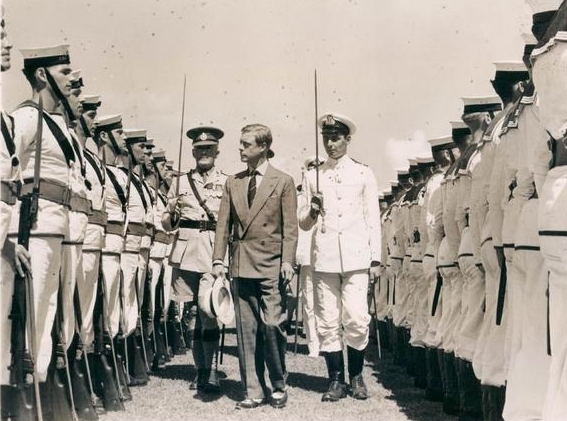
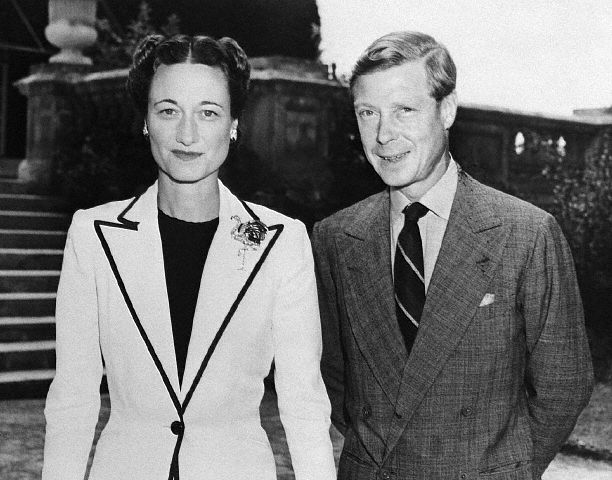
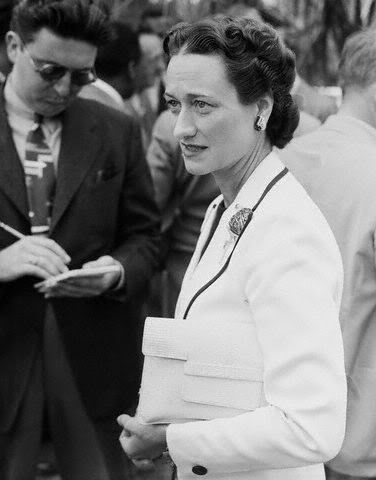
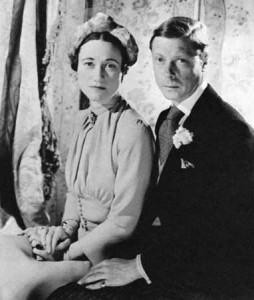
Top photo: HRH the Duke of Windsor after his 1940 arrival in Bermuda, inspecting a Royal Navy honour guard. Bottom, the Duke and Duchess in Bermuda, Royal Gazette photos
1940. August. Bermudian graduates of the Bermuda Flying School left Bermuda for England on SS Mataroa, bound for the Royal Air Force. They included Geoffrey Bird, John Brewer, Bobby Burnard, Royston Dodwell, Joseph Robert Gibbons, William Kempe, Jim Lang, Geoff Osborne, Jack Pitt, Teddy Nicholl, Pete Perinchief, Percy Roach, Martin Smith, Francis Stephens, Jackie Thomas, Jimmy Vallis, Alan (Smokey) Wingood, Jimmy Whitecross. Other Bermudians too joined the RAF, as graduates of the Bermuda Flying School. Those who joined the Royal Canadian Air Force included Fred (Red) Adderley; Harold Dale; Arthur (Copper) Jenkins; Norman Jones; David Kopec; Charles Nunn; Arnold Redman; Richards (first name unknown); Norman Sumpter; Squires (first name unknown); Robert Oatway; Geoffrey Welch; Herbert (Chummy) Zuill.
1940. August. 150 censors arrived in Bermuda and were assigned quarters and office space at the Hamilton Princess Hotel.
1940. August. The Bermuda Government set up a Service Corps, instituted various projects to generate employment which included the creation of Bernard Park and established a Conscription Act to ensure Bermuda had replacements or additions to Bermudians serving overseas.
1940. August 24. On leaving Bermuda, HMS Penzance of the Royal Navy was on its way home to Britain when it was torpedoed by the German submarine U-37 under Kapitan Victor Oehrn. One of the survivors, Lieutenant John W. Draisey, RNVR, was picked up by the merchant vessel Blairmore, only to be plunged into the sea again that very same night when the Blairmore was sunk by another torpedo from the U-37. He recovered sufficiently and returned to Bermuda as Flag Lieutenant under Admiral Sir Charles Kennedy Purvis.
1940. October 10. Arrival in Bermuda via the American Export Line ship Excambion (later to bring another famous visitor to Bermuda) from Lisbon of Dr. Otto Strasser who had fled Germany, traveling under a false last name and under a Swedish passport. He had left his wife and two children behind in Lisbon. He spent a total of six months in Bermuda, under some surveillance but also with some patronage and freedom, not interned like other German nationals. Later, he lived in Canada where he achieved a claim to fame. He was the brother of Gregor Strasser, also a left winger believer in socialism, shot by the Nazis as a traitor. Some sources say that while in Bermuda, Otto Strasser wrote and published the book "Hitler and I."
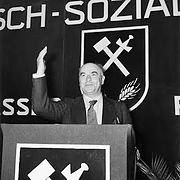
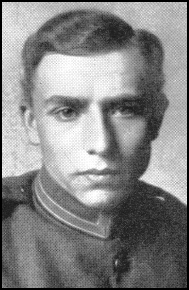
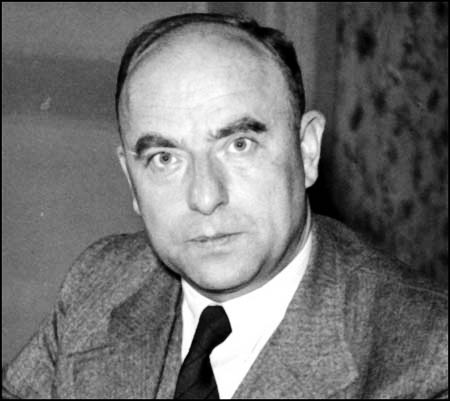
Dr. Strasser at different times. See above story.
1940. October 14. This letter was sent by the British Ambassador in Washington DC to Colonel Knox, British Army in Bermuda. " Dear Colonel Knox, You will remember that lust week I told you that His Majesty's Government had received from a committee of the Legislature of Bermuda a statement setting forth with great force the serious damage which in their opinion would be done to the life and prospect of Bermuda if the scheme suggested by Admiral Greenslade was carried out in its original form. I attach a memorandum based on material derived from Bermuda which sets out in detail the objections of the Bermudians to the present scheme and an alternative suggestion which they believe will meet the needs of the United states equally as well if not better. My Government has considered this memorandum and thinks its fundamental case is well taken, and has directed me to ask whether you would agree to Admiral Greenslade going back to Bermuda after his return to Washington and investigating the alternative plan. I understood you to say at our brief meeting last week that you would arrange for this. As you will see from the attached paper the head and front of the Bermudian objection is to the proposed position of the military aerodrome and, in a minor degree, to the islands selected for the magazines as they adjoin the very narrow entrance into Hamilton Harbour. The alternative scheme provides for a military aerodrome and possibly a seaplane base to be concentrated at the Eastern end of the island which would make it easier for the United States to keep control over its own activities there and would avoid the disturbance to the island which is involved in the present plan. It is estimated that the construction of an aerodrome on and around Long Bird Island would neither take longer nor be more expensive than that now proposed and would give longer run-ways in both directions. The Governor assures me that the people of Bermuda are most anxious to cooperate in providing the facilities needed by the United States and I am sure you will agree with me In thinking that if the proposed naval and air bases can be carried out with the good will of the people of Bermuda it will make the practical working of Anglo-American cooperation in Bermuda much easier in the future. If Admiral Greenslade wishes to have more details of the new proposal, my Naval Attache, Admiral Pott, will do his best to supply him with them."
1940. November 5. Loss of the Bermuda-based Royal Navy armed merchant cruiser Jervis Bay - a 14,000 ton former passenger liner - Halifax/UK convoy HX84 from Canada to the UK with 37 ships and this ship as its solitary escort (Capt Fegen).
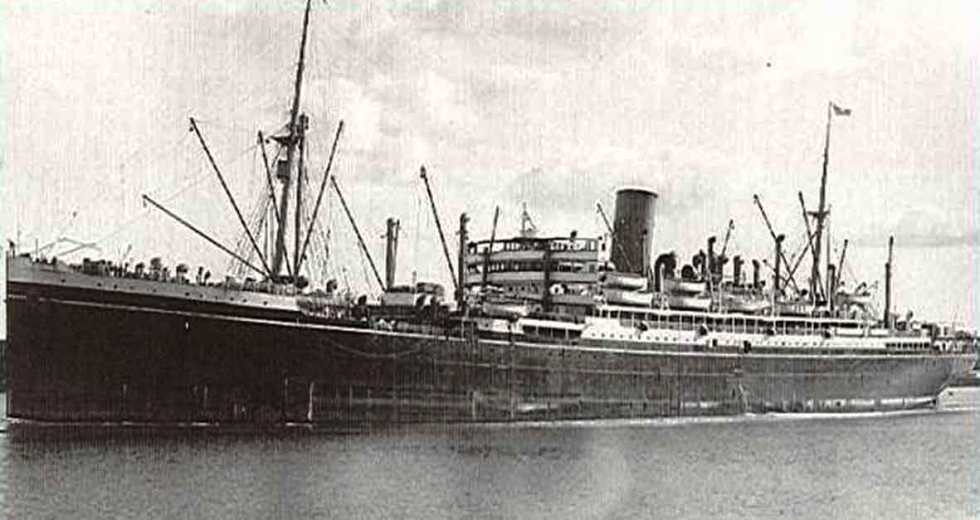
Named after Admiral Jervis, it was attacked by the German 11 in-gunned pocket battleship Admiral Scheer in mid-Atlantic. The convoy was ordered to scatter as Jervis Bay headed for the "Scheer", guns firing. The end was in no doubt and she went down with all her 189 crew including a number of Canadians, but her sacrifice saved all but five of the merchant ships. There is a memorial to the ship at Bermuda's Albouy's Point. The brass plaque on the monument asks us to "Remember Captain E.S. F. Fegen, VC Royal Navy, the Officers and ship's company of H.M.S. "Jervis Bay" who cheerfully gave their lives in successful defence of their convoy, fighting their ship to the last against hopeless odds. The SS Jervis Bay began life in 1922 out of the great Vickers shipyards at Barrow in Furness and was taken into the service of the Aberdeen & Commonwealth Line, which operated ships to and from Australia. All of its vessels were named after Australian bays, Jervis Bay being some 90 miles north of Sydney. After the outbreak of war between England and Germany in 1939, the ship was commandeered by the Royal Navy and fitted out with eight six-inch guns. First sent on station to the South Atlantic, the vessel was assigned to Bermuda Convoy Escort Duty in May 1940, and from June 1940 to the Bermuda and Halifax Escort Service, a service that would last but a mere six months, ending its demise on November 5 at position 52.26N, 32.34W. In its last days, Jervis Bay was the only armed escort for the 37 merchant ships of Convoy HX84, out of Halifax, Nova Scotia, bound for Great Britain. Meanwhile, the pocket battleship, KMS Admiral Scheer had broken out of the North Sea, making its way through the Denmark Strait between Greenland and Iceland en route to raid Allied shipping in the Atlantic Ocean. Convoy HX 84 became its prey as the sun set on the cold, grey reaches of the North Atlantic. Captain Edward S. Fogarty Fegen, commanding officer of the Jervis Bay, immediately ordered the helmsman to set a beeline directly into the guns of the Admiral Scheer, to allow the convoy to scatter and escape as best it could. The Jervis Bay was out of action in 15 minutes and sank two hours later with the loss of 190 men, still drawing fire from the Admiral Scheer. Sixty-five of the crew were rescued by the Swedish vessel Stureholm. Captain Fegen was posthumously awarded the Victoria Cross, later donated to the Royal Naval Museum at Portsmouth by his daughter, Barbara Fegen. The citation for his VC notes his "Valour in challenging hopeless odds and giving his live to save the many ships it was his duty to protect". The Admiral Scheer then proceeded to sink six other ships of the convoy, being the Mopan, Maidan, Trewellard, Kenbane Head, Beaverford and the Fresno City. A tanker, the San Demetrio, was also shelled and set afire, its crew abandoning ship. The ship was found by some of her crew in a lifeboat two days later, still on fire. They climbed back on board, put out the fires, repaired the engines and limped into port almost two weeks after the tanker was declared to be a loss, such is the courage of the merchant mariner. The Jervis Bay had seven six-inch Mark VII guns and two three-inch anti-aircraft guns, which figured little in the ensuing battle. It was the proverbial sitting duck, with guns half the range of its opponent. The Admiral Scheer was sister ship to Admiral Graf Spee of River Plate fame. She was refitted as a heavy cruiser and began raiding in November 1940, sinking 17 merchant ships for 114,000 gross tons. After "faultily concentrating her effort on the armed merchant cruiser, Jervis Bay", she allowed Convoy HX84 to scatter. Thereafter the Admiral Scheer disrupted Allied shipping as far away as the Indian Ocean, returning to port in April 1941, having never been located by Allied hunter forces. Under Captain Theodor Krancke, the ship was the most successful capital commerce raider of the war. She was then used ineffectively in the Artic and Baltic and was sunk by RAF bombers in Kiel on April 9, 1945, later buried under a new dock. The raider weighed in at 16,200 gross tons, which could be propelled at almost 30 knots. It was commissioned in November 1934 with a length of 610 feet and a beam of 71 feet. The vessel mounted six 11-inch guns in two turrets of three; eight 5.9-inch guns and eight 21-inch torpedo tubes in two quadruple sets. HMS Jervis Bay visited the Island on a number of occasions before she was sunk. On at least one occasion, her crew participated in local cricket matches. A photo after one such match was first published in the Scottish newspaper the John O'Groats Journal. A sundial memorial to the lost sailors was erected at Albouy's Point within a year of the incident and is annually honored on Remembrance Day in a service nowadays led by the Bermuda Sea Cadets. The Scottish town of Wick, which is near John O'Groats, is the latest community to create a dedicated memorial in honour of the sailors of HMS Jervis Bay. Eighteen of the crew were from the county of Caithness in north-east Scotland, of whom nine died when the ship was sunk. As well as Bermuda and Scotland, there is a memorial to HMS Jervis Bay in Nova Scotia, Canada from where she sailed on her final voyage.
1940. November. Arrival in Bermuda of a "Donald Williams" - in fact William J. "Wild Bill" Donovan - special advisor to President Roosevelt and soon to be appointed the first director of the Office of Strategic Services, later the Central Intelligence Agency. The USA was not yet at war but he was sent to Bermuda to see and cooperate with William Stevenson of the UK's wartime censors based in Bermuda since July 1940. Among other things, he colluded with Stevenson in the opening up and censorship of mail bound to and from Europe and the USA.
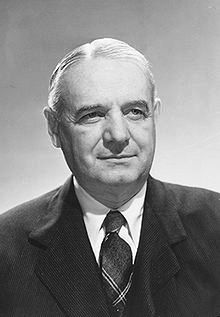
William Donovan
1940. November 28. Death in Bermuda at the age of 72 of Harold Sidney Harmsworth, 1st Viscount Rothermere, born April 26, 1868, Hampstead, London, England. British newspaper proprietor who, with his brother Alfred Harmsworth, 1st Viscount Northcliffe, built the most successful journalistic empire in British history and created popular journalism in that country. A shy individual, he let his brother handle the public and journalistic side of the business, while he handled financial matters. In October 1940, Lord Beaverbrook, apparently with the approval of Prime Minister Winston Churchill, sent Harmsworth on a secret war mission to Canada and the United States. Upon the completion of the job, Harmsworth went to Bermuda to take a rest. He died of dropsy in Bermuda at the age of 72. He is buried in grave 271, a prominent one by itself at St. Paul's Churchyard, immediately behind (on the north side of) the church in Paget Parish. Other accounts paint a different story, that he had been a pre-war admirer of Hitler been photographed with him several times, had also given his full support to Oswald Mosley and the National Union of Fascists. He wrote an article, Hurrah for the Blackshirts, on 22nd January, 1934, in which he praised Mosley for his "sound, commonsense, Conservative doctrine". The London Evening News, another newspaper owned by Lord Rothermere, also supported the Blackshirts. Another title owned by Rothermere, The Sunday Dispatch, even sponsored a Blackshirt beauty competition. The Daily Mail continued to give its support to the fascists. In July, 1934 Lord Rothermere suddenly withdrew his support for Oswald Mosley. It was alleged the Daily Mail's Jewish advertisers had threatened to place their ads in a different paper if Rothermere continued the pro-fascist campaign." Pool points out that sometime after this, Rothermere met with Hitler at the Berghof and told how the "Jews cut off his complete revenue from advertising" and compelled him to "toe the line." Hitler later recalled Rothermere telling him that it was "quite impossible at short notice to take any effective countermeasures." It is claimed by some that after Germany invaded Czechoslovakia, Lord Rothermere immediately sent a telegram to Adolf Hitler: "My dear Fuhrer everyone in England is profoundly moved by the bloodless solution to the Czechoslovakian problem. People not so much concerned with territorial readjustment as with dread of another war with its accompanying bloodbath. Frederick the Great was a great popular figure. I salute your excellency's star which rises higher and higher." One account claims Lord Rothermere became aware that MI5 had copies of his letters to Adolf Hitler and fearing that he might be arrested in the UK for treason, decided to go and live in Bermuda. But Bermuda was a British colony, he was not arrested here..
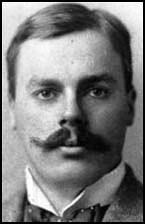
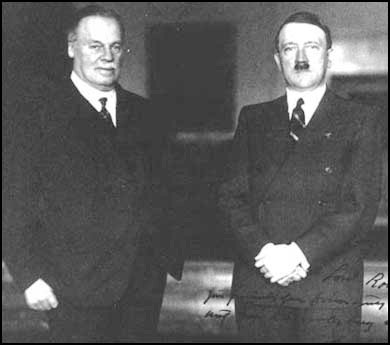
Lord Rothermere, as a young man and later, during one of his pre-war (in this photo, 1934) meetings with Hitler. See above story.
1940. Construction was approved to occur in Bermuda from scratch of two new military bases for the USA, one on St. David's Island at Fort Bell for the US Army and US Army Air Force and the other at what became the US Navy Operating Base. They were on a no-rent 99-year lease basis. They involved over 693 acres of both Crown-held and privately owned lands. They took two years to build and cost US taxpayers over US 45 million. In Castle Harbour, entire islands were bull-dozed and destroyed, including the largest, Long Bird Island. All buildings then on it were destroyed, with the exception of the easternmost house, which became the home of the commandant of Fort Bell, later Kindley Field, and later US Naval Station Bermuda. To the east of Long Bird, the following islands were reduced to ground level and buried under the Station and airfield: Pudding, Cave, Little Round, Sandy, Jones, Round, Long, Graces, and Westcott, the last having two dwellings upon it. Stocks Harbour, which provided for access between Castle and St Georges Harbours, via a channel between Stokes Point on St Georges Island and The Needles and Stocks Point on St David's Island, was reduced by land reclamation to half its original size. A goodly portion of St David's Island disappeared by bulldozing and the eastern end of the Fort Bell airfield appeared in place of Easter Lily fields and ancestral homes of a number of Bermudian families, irrevocably gone.

Warships were a common sight in Bermuda during these war years. Royal Navy photo
1941. January 16. Bermudian Douglas William Howard Hutchings was lost at sea. He was an oiler, whose first job was in the engine room of the Queen of Bermuda, but had transferred to another vessel. (At the time of his death, Queen of Bermuda was on duty in the Falkland Islands far to the south). There were two British vessels sunk that day, the Zealandic and the Oropesa. Both were attacked off Rockall, some 300 miles from Iceland and Ireland on the route from the North Sea to the Atlantic. The cargo ship Zealandic was lost with all hands and Oropesa, a passenger liner, lost 105 crew and passengers, with 143 being rescued. Given that he was originally on a passenger liner, it is possible that Hutchings was lost on the Oropesa. It was sunk by U-96, a boat familiar to most through its incarnation as the lead actor in the film, Das Boot.
1941. February 15. In the USA the Bureau of Yards and Docks awarded a fixed fee then-wholly-civilian contract in Bermuda, initially to accomplish the construction of an air station for seaplanes, and subsequently expanded to include a fuel oil depot, a supply depot, and operating base, a submarine base and anti-aircraft training school. Adjacent water, ideal for seaplane operation, and proximity to existing ship channels resulted in the choice of Morgan and Tucker Islands, situated in Great Sound, within the hook of the western end of Hamilton Island, together with an adjacent area on Hamilton Island at Kings Point, as sites for the air station and the operating base. Darrell's Island, also in Great Sound and about a mile and a half to the east, then in use as an air station by commercial airlines, was developed as an auxiliary seaplane base. Submarine facilities were planned for construction on Ordnance Island, at the eastern end of the Bermuda group, in St. Georges Harbor, adjacent to the town of St. George. This location, while remote from the operating base, was chosen because of the availability of the site, the existing facilities, and its proximity to the sea lanes serving the islands. The general topography of the leased areas was gently rolling, varying in elevation from sea level to a maximum of 40 feet. The base development plan issued by the Chief of Naval Operations to support the 15,000-plane program, indicated Bermuda as a major naval air station, with facilities for the operation of two patrol squadrons of seaplanes on a permanent basis and one additional squadron with tender support. In addition, facilities were to be provided to support the emergency operation of one carrier group from an airfield to be developed by the Army. Thus began construction of a Naval Air Station USN NAS Bermuda/NAS Annex, Morgan's Point for flying boats, and an airfield for landplanes. The terms of the agreement were that the US-built airfield, on British territory, would be a joint US Army/Royal Air Force base. When the airfield became operational in 1943, RAF ATC relocated to it, taking over the West end of the base in Castle Harbour.
1941. February. Bermudian Shelton, Stanley Arthur, member of the Bermuda Volunteer Rifle Corps who had been attached to the Lincolnshire Regiment, died in action.
1941. February. Bermuda-based operatives began to piece together intelligence gathered by both British and US radio monitors on German U-boat fleets in the Atlantic and elsewhere and how they were being instructed by radio by the German high command. British and American eavesdroppers were able to gain information on their movements. U boat captains were so convinced about the impregnability of their Enigma coding system each submarine had and the way the coding machine system changed that they became careless in using radio. The British in particular were also locating submarine positions by taking bearings on their radio transmissions. This coverage increased hugely when US stations commenced feeding information between the BSC and Bermuda.
1941. February. Sir John Cox and two other Bermuda Members of the Colonial Parliament traveled to London in an effort to persuade the UK Government not to allow the USA to set up a military base in Warwick which would have divided Bermuda into two. They were successful and what became the two base were located at St. David's and Southampton parishes.
1941. March 1. While Anglo-American staff conferences were going on in Washington on how to best combat the Germans, the Battle of the Atlantic had taken an extremely critical turn. In Admiral Stork's opinion it had become, in fact, "hopeless except as we take strong measures to save it." Four of the most powerful surface vessels of the German Navy--the pocket battleship Scheer, the heavy battle cruisers Scharnhorst and Gneisenau, and the 8-inch cruiser Admiral Hipper - were on the loose, prowling the Atlantic sea lanes and adding serious destruction to the mounting toll of the U-boat packs.8 Submarine attacks could be countered by light escort vessels; but the German surface raiders, whether in refuge or at sea, presented a different threat, one that only capital ships or strong cruiser and carrier forces could meet. Admiral Stark had not at all exaggerated the seriousness of the situation. By March it seemed to him only a matter of at most two months before the United States would be at war, "possibly undeclared," with Germany and Italy; although the Army at this time was counting on at least five months' grace. Admiral Stark discussed his analysis with the President on 2 April and again the next day, thrashed out the steps to be taken, and was told to adopt the strong measures he thought were required: to draw up plans for escort of convoy west of longitude 30° west and issue orders for the transfer into the Atlantic of a heavy striking force, including three battleships, from the Pacific. The destructive forays of the Scharnhorst and Gneisenau had given President Roosevelt an understandable concern for the safety of the American bases, particularly those which were most exposed or of most value to the Navy--Bermuda, Trinidad and Newfoundland.
1941. March. In the Town of St. George, the Bank of N. T. Butterfield & Son Ltd opened a branch, primarily to facilitate US Army, USAAF, US Navy and US civilians involved in the American build-up of the new bases.
1941. March 29. The initial construction effort of the US Naval Operating Base as an air station for flying boats and other aircraft in Southampton Parish and a US Army airfield on St. David's Island began. The base development plan issued by the USA's Chief of Naval Operations indicated Bermuda as a major naval air station with facilities for the operation of two patrol squadrons of seaplanes on a permanent basis and one additional squadron for tender support. In addition, facilities were to be provided to support the emergency operation one one carrier group from an airfield to be developed by the US Army on St. David's Island, to be built concurrently. Dredge-filling the narrow funnel-shaped channel between Morgan and Tucker islands more than doubled their original combined area of 40 acres. The one island thus formed was then connected by causeway to King's Point, on Hamilton Island. The principal structures built at the air station comprised a tender pier, three seaplane ramps and parking area, a large seaplane hangar, barracks for 1,100 men, quarters for 140 officers, a bombproof power plant, and the usual industrial, administration, and storage buildings. At the Hamilton Island site, underground storage was provided for fuel oil, diesel oil, and gasoline, as well as barracks for fuel depot and air station personnel, a 50-bed dispensary, a large magazine area, a radio station, and a 10-acre water-catchment area with storage for 5,000,000 gallons of rain water. All these installations were of a semi-permanent character. Soon after construction began, it became essential that naval air patrols be placed in operation as quickly as possible. This was accomplished by using the established facilities owned by British Imperial Airways on Darrell Island. By an informal agreement with the British and local governments, permission to use this island on a temporary basis was granted. Here, existing facilities were augmented by barracks, water supply, paved parking areas, landing floats, and other temporary essentials. This work was undertaken in May and the island put to immediate use, continuing so until March 1942, at which time the permanent naval air station was usably complete and in operation.
1941. April. Bermudian James Hugh Arnold Linton was killed in action in Egypt, while serving with the British Army.
1941. April 7. The President of the USA directed the Secretary of War to have Newfoundland reinforced and to send garrisons to Bermuda and Trinidad immediately.
1941. April 6. The US Navy base in Southampton, Bermuda, was formally opened, to much fanfare, by Admiral Ingram C. Sewell, US Navy.

1941. April 7. Captain (later, Admiral) Jules James, USN, see photo below, read his orders as Commandant, USNOB Bermuda and hoisted his pennant over the former residence of Mrs. Margaret V. B. T. Wooley-Hart on Tuckers Island. (This building later became the Religious Center).
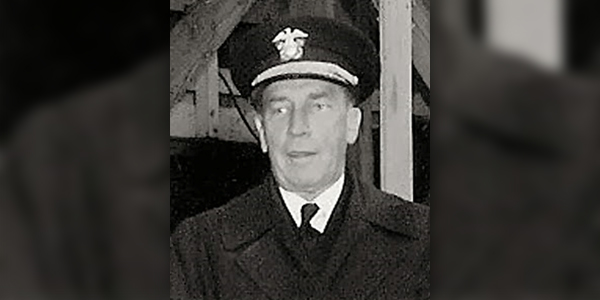
1941. April 7. First Day Postal Service and Official First Day Cover of the US Military Bases post offices just established in Bermuda. Sent by the US Marine Detachment, first unit to be based in Bermuda. Stamps shown are United States of America Army and Navy for Defense Postage 2 Cents and United States of America, Industry Agriculture for Defense Postage 1 Cent.
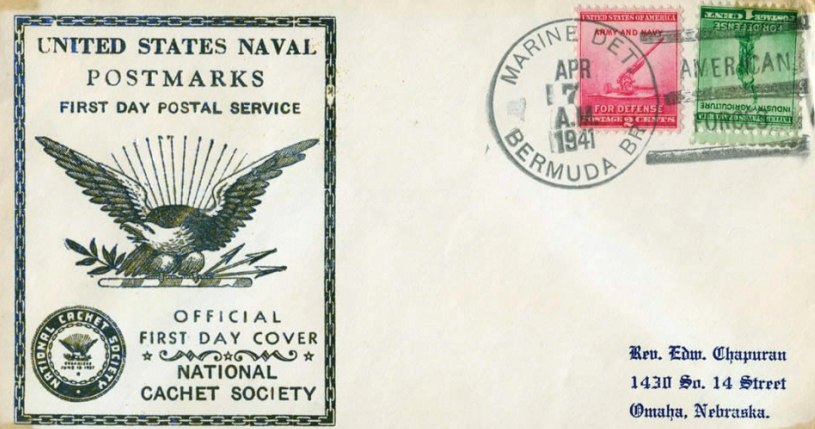
1941. April 16. The US base on St. David's Island, just completed, was about to be first occupied by the U.S. Army and named Fort Bell. However, the airfield area was referred to as Kindley Air Field, after US WW1 ace Field E. Kindley. The maintenance and operation of the entire base was handled by U.S. Army Ground Forces, while Army Coast Artillery units were responsible for defense. The U.S. Army Air Force operated the air traffic section of the base. The Bermuda base became a vital link in air and sea traffic between the United States and Europe both during and after the war as a 'stop off place.' Troops were able to rest, recover and receive medical treatment, while military personnel used the facilities to hold conferences.
1941. April. When the American Legion cargo ship arrived in Hamilton, there was huge activity at Number 8 shed in unloading the military cargo. A railway spur was laid to transport in American-provided railway gun carriages entire gun assemblies, with their barrels taken by barge to near where they would be placed.
1941. April 20. USA sent garrison troops to Bermuda. Newfoundland on the northern flank, Trinidad on the southern, and Bermuda in the center were the first of the new Atlantic bases to be garrisoned. The first contingent had arrived in Newfoundland in January 1941, ahead of the construction forces, and in April the first garrison troops arrived in Trinidad and Bermuda, only a few weeks after the advance party of construction people. The timing was not exactly what the War Department had at first envisaged. In spite of the pessimism over the chances of Britain's winning the war which in September 1940 still colored the War Department's estimate of the situation, General Marshall laid down the dictum that garrisons would not be sent to the Atlantic bases until construction was well advanced. Some definite threat to the base sites might require the dispatch of a garrison prematurely, but this was a possibility that could apparently be waited for. The Bermuda force of some 860 men, comprising Company G, 11th Infantry, Battery F, 52d Coast Artillery, and Battery B, 57th Coast Artillery, and commanded by Col. Alden G. Strong, landed in Bermuda on this Sunday. It had been preceded, a week before, by Brig. Gen. Francis B. Wilby, chief of staff of the First Army, and Lt. Col. Harold F. Loomis of the War Plans Division, who had been surveying the general situation and choosing sites for the coast defense guns and who now were among those on hand to welcome Colonel Strong and his men. Within a few hours after he arrived, Colonel Strong had drawn up in collaboration with Capt. Jules James, USN, commandant of the naval base, a joint plan for the defense of the islands, for which he disposed his troops as follows: one 2-gun battery of the 8-inch coast defense guns was to be placed at Fort Victoria, on St. George's Island, and another on Somerset Island, not far from the U.S. naval base; a like-sized battery of 155-mm. guns was to be placed on Cooper's Island, near the Army base, and another on Hamilton Island, in the vicinity of Riddle's Bay; and the infantry company, quartered in the Castle Harbour Hotel, was to be the mobile reserve. Meanwhile the two US military bases were being built. They completely changed Castle Harbour in the east and the Great Sound in the west.
1941. April 26. Bermudian Howard Sinclair Burgess died in action. He was a fireman and trimmer and with 28 others on the Henri Mory was torpedoed. The Henri Mory had sailed with a cargo of iron ore from Pepel and Freetown in Sierra Leone for Barrow in Scotland. One source suggests that the ship came to Bermuda and it is possible that Burgess joined the vessel and his fate here. The Henri Mory had left Convoy SL-68 and was traveling independently when the ship was torpedoed by U-110 in the North Atlantic. The U-110 had a very short career of only two sailings and was sunk a few weeks after the Henri Mory went down. The boat became famous for it remained afloat long enough for the British to board it and remove an Enigma code machine and many secret documents.
1941. Bermuda Workers' Association (BWA) was formed and founded by Dr. Edgar Fitzgerald Gordon, a Trinidad-born medical doctor who was trained at the University of Edinburgh and once had his practice in Kingussie, Scotland. His wife also trained at Edinburgh for a medical degree but did not complete it. His Bermuda-born children were Pamela and Patricia. The union was the forerunner of the Bermuda Industrial Union (BIU).
1941. May 10. Unexpected arrival in Bermuda on a short visit of exiled King Carol II of Romania and his party which included his mistress Madame Magna (Elena) Lupescu, his Chamberlain Colonel Urdareanu. They arrived on the American Export Line's passenger and cargo ship Excambion from Lisbon and were en route to Cuba after the former king, exiled from his homeland after a military coup, had been effectively deported from Portugal, then officially neutral but laced with German agents. The former monarch was known to be anti-German. Because of this he and party were not welcomed in the USA then also neutral but were treated well by his Bermudian and British hosts, allowed to stay at the Belmont Manor Hotel without publicity and were entertained by the Governor and British military commanders based in Bermuda.
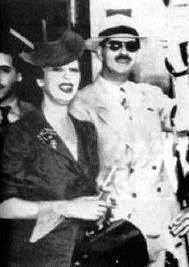
1941. May 15. Two distinctive Britons began their flight from London to Lisbon then Bermuda and from there inwards to New York City 10 days later. They were dressed as civilians but were in fact the UK's Director of Naval Intelligence, Admiral John Godfrey, and his personal assistant, Lieutenant Commander Ian Fleming RNVR (who later wrote his internationally famous James Bond secret agent novels). Admiral Godfrey was then 53 years old and Fleming was then 33. The two men flew KLM to Lisbon and then took the Pan Am Boeing 314 seaplane via the Azores to Bermuda, 600 miles east of North Carolina, where American military forces had begun building a base to help protect America 600 miles due east of the USA. In Bermuda, the British Government had established its Imperial Censorship and Contraband Control Office to read mail taken off transatlantic ships and aircraft. Fifteen hundred British ‘examiners’, also known as ‘censorettes’ because most were women, worked in the waterfront Princess Hotel, processing 100 bags of mail a day – around 200,000 letters – and testing 15,000 for microdots and secret ink messages, before sending on the bags on the next plane or ship. The two men made careful notes of what they saw. They spent about 9 days in Bermuda before they again flew Panam from Bermuda and arrived in New York City on May 25 1941. They had arranged in advance to stay at the St Regis Hotel on 55th Street and 5th Avenue in Manhattan and from there went to meet ‘Little Bill’, the Canadian businessman William Stephenson, and his American friend and ally ‘Wild Bill’, Colonel William J. Donovan. What happened from then on impacted the USA, Bermuda and the rest of the world.
1941. June. The US military contract re Bermuda contract was supplemented to undertake the development of submarine facilities on Ordnance Island. Under this program, and its subsequent additions, a number of existing buildings were rehabilitated to provide housing and messing facilities for crews while ashore, improvements and additions were made to the existing water and sewer systems, waterfront structures were repaired, and offshore moorings installed. The use of Ordnance Island was obtained under a lease extending to December 1955, under the terms of which the United States could regain all removable improvements placed by or on its behalf at any time before the termination of the lease. The island was returned to its owners in July 1945.
1941. June. Concurrently with the building of the US Military bases in Bermuda, the oyster-shell scale (insulaspis pallida) and the Juniper Scale were imported accidentally from the USA, in a cargo of US military supplies to help build the bases. Both arrived in separate shipments of conifers. The Juniper Scale began to decimate virtually all Bermuda's endemic Cedar trees which then numbered about 8 million.
1941. June. Thanks solely to the American military already here, the USA helped enormously to get the Bermuda Railway some relief. General Strong got an AA1 priority for new equipment, including the first Diesel locomotives. Two ex-US Army Brill railcars were also added to the fleet, specifically to assist the American forces then based in Bermuda during the Second World War. One very hush-hush job was the transport in the dead of night by the railway and its new locomotives and Army railcars of heavy guns for the fortification of the South shore. Automobiles on reinforced roads had to be permitted for the American, British and Canadian military. British and American soldiers stationed in Bermuda and their Bermudian counterparts added so significantly to the railway's use with their constant movements that huge damage was caused to bridges, sleepers, track and trestles.
1941. June 27. The remission of customs duties and local taxes under Articles XIV and XVII of the base agreement was not enacted by the Bermuda legislature until this date, exactly three months after the agreement came into effect. Even then there was only a partial conformity. Bermuda continued to levy duties on bulk petroleum products not consigned direct to the Army and Navy and on household effects and personal belongings. Various wharfage charges were assessed on goods destined for the bases, and a stamp tax was levied on bank checks and steamship tickets. Even at the end of 1941 the State Department was still pressing for determination of a few of the matters.
1941. June 15. The Free French submarine Surcouf was sent to Bermuda, but from late July to late November, the boat was refitted in New England.
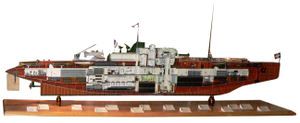
1941. June 17. The Brewster Bermuda Model-340 or Buccaneer aircraft as it was known in the USA, ordered in April 1939 by the US Navy, made its first flight . It has the dubious distinction of being one of the least successful US combat aircraft put into production during the Second World War. Desperate for modern aircraft designs, the British Purchasing Commission then ordered 750 aircraft of the type, to be known as Bermudas. But mediocre performance quickly relegated the aircraft type to only training duties.
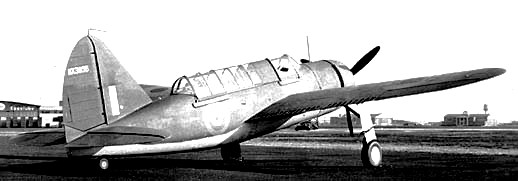
Brewster Bermuda aircraft in RAF colors. See above story.
1941. July 13. US Marine Detachment Bermuda, opened in April that year, closed.
1941. July 14. First Day Cover of First official mail from US Bases in Bermuda was sent, from members of the US Marine Barracks at NOB Bermuda, opened after the Marine Detachment Bermuda, referred to earlier, closed the day earlier. This base was part of the Land Lease program which exchanged British Bases for US Ships.

See above story
1941. July 15. Sinking by the Italian submarine Morosini in 37.23N 20.32W of the SS Lady Somers, 8194 tons, built in 1929, with many lives lost. She was the first of the five white Ladyboats to suffer from the war, owned by the Canadian National Steamship Company. The popularity of the Lady Boats peaked just prior to World War II in 1939, and then things changed dramatically. White paint became grey, few passengers surfaced; there were regular blackouts and no bananas, but lots of torpedoes to keep them company. Within four months of the Loss of the Lady Somers, German U-boats attacked three of the four remaining Lady Boats.
1941. August 1. Headquarters, Military Command, Prospect Camp, Devonshire, wrote to Arthur St. George Tucker at Nonsuch Island of the decision to approve the transfer of Miss Ruth Buchler, a German national and Nazi spy held in isolation in a temporary Prisoner-of-War camp on Nonsuch Island, to the women's cage at St. George's Prisoner of War camp (where the camp commandant was Captain G. A. Cooper).
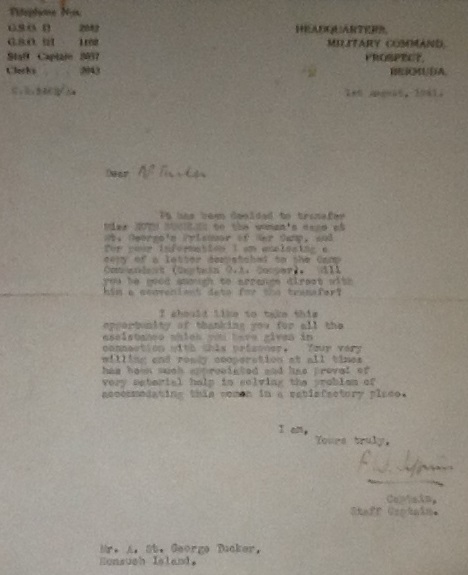
1941. August. Spitfire Bermuda One Mark IIb P8507 was bought for the Royal Air Force by Bermudians, by public appeal. It shot down five German aircraft before it failed to return on this date.
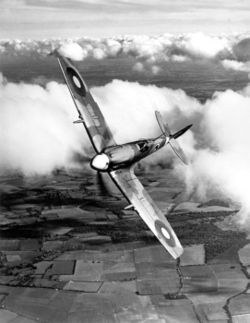
Spitfire Bermuda One
1941. August 9-12. Prime Minister Winston Churchill and President Franklin Delano Roosevelt met on the warship USS Augusta off the coast of Newfoundland and created the Atlantic Charter, the basis of the Allied war plan during World War 2.1941. August 10. Death in Bermuda at the age of only 29 of Hyman Israel Gordon, Staff Sergeant, Royal Engineers. He was buried at Prospect Military Cemetery, grave 855.
1941. August. The Bermuda Beacon, a US military monthly, published for the US Army's Fort Bell and Kindley Field by the US Army Engineers. Initially a safety magazine, later on other topics too, it was created for the-then US Army Air Force (predecessor of the USAF) air base personnel in Bermuda, the idea of Benjamin Schwartz (Bermuda Base Contractors) and Loring Cox (Mail and Records section, USED.). It had some nice stories and original graphics during that period. It continued publication until April 1943, concluding with the end of major work on the Air Base, and the termination of the original construction contract. The publication was limited to a 700 copy print run.
1941. Late August. The SS Navemar, out of Seville, bound for New York via Lisbon and Havana, arrived in Bermuda. She was one of the refugee ships, with mostly Jewish passengers escaping from Germany, who had been looking for many months if not years for a friendly country to give them political refuge. Those on the Navemar had visas for the United States, but as they were due to expire, they had to put into Lisbon to have them renewed. With the bureaucracy of the day and a war on, they had tried to get new visas, but the Consulate did not have enough typewriters to process the paperwork in time. An American Jewish refugee committee sent cash to buy up typewriters in Lisbon, upon which the lives of the Navemar passengers depended. In Bermuda, the women and children were allowed off the ship and were given a picnic by the ladies of the Imperial Order of the Daughters of the Empire and the Bermuda Women’s Auxiliary Force, for which a notice of thanks was published in The Royal Gazette and Colonist. Among the Navemar complement at the tea party was Hannah Arendt, perhaps the most important female philosopher of the last century who coined the phrase “banality of evil”, Marc Chagall’s daughter Ida, and Lucille de Saint-Andre, who wrote a fictional account about the Navemar and the infamous Vichy French concentration camp, Gurs, entitled, “Bye Bye, Baden-Baden.” But because of anti-Jewish laws still in effect that had not been repealed (and would not be until 1959), the ship was then sent on to New York where the passengers were received gladly as refugees and allowed to stay. (The ship was not so lucky, it was later - in 1942 - torpedoed by the Italian Navy off Spain).
1941. English censorette Margaret Stapleton was raped and murdered in Bermuda, after leaving a dinner party at Bleak House in Devonshire. Harry Sousa was later convicted and hanged.
1941. Founding of the Spanish Point Boat Club (SPBC) at Spanish Point, Pembroke. Once racially segregated, it became famous for Snipe Class dinghy sailing, winning the Western Hemisphere Snipe Championship, the SPBC Championship and the Bermuda National Championship in 1956.
1941. 11 September. HMS Bermuda, a Colony class cruiser, displacement 11,040 tons, overall length 555 ft 6", with twelve six inch guns in four triple turrets. was launched at Clydebank, Glasgow, Scotland and completed 21 Aug 1942. She served in WWII and was then refitted 30 Jun 1944 to 27 Mar 1945. She visited Bermuda 3 times: Feb 1958, Jul 1959, and Feb 1962.
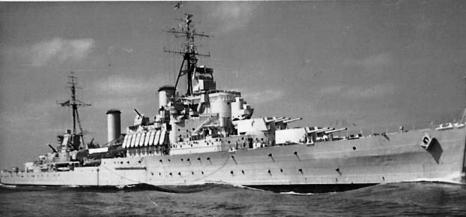
HMS Bermuda, Royal Navy photo
1941. September. The USS Augusta, which in August achieved a unique claim to fame from the visit of President Roosevelt and Prime Minister Winston Churchill - began her one-month stay mostly in Bermuda waters. With an Admiral aboard, she was the flagship of the Atlantic Fleet of the United States Navy.
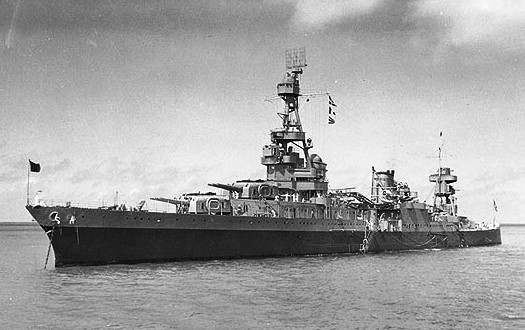
USS Augusta anchored off Bermuda
1941. September. Britain's Fleet Air Arm´s Royal Naval Air Station on Boaz Island, HMS Malabar, nominally an aircraft repair and replacement facility without its own aircrews, has been providing air patrols since 1939, using Supermarine Walrus flying boats flown by naval pilots from ships at the dockyard, or pilots from the Royal Air Force and the Bermuda Flying School on Darrell´s Island. However, once the US Navy began flying air patrols from Darrell´s Island from September, the Fleet Air Arm´s patrols ceased.
1941 September. US Navy sailors, on liberty in Bermuda, chat with a Bermuda policeman on Front Street.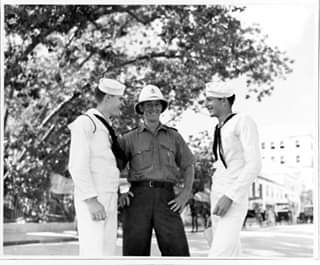
See above story
1941. October. By the end of this month American forces were committed to the task of destroying all German and Italian vessels or planes encountered anywhere in the western Atlantic.1941. October. US Secretary of the Navy Frank Knox inspected officers and crew of USS Augusta in Bermuda. .

1941. October. With her engines needing repairs, HMS Queen of Bermuda arrived at Newport News, Virginia, for a major overhaul in order to continue her work as an Armed Merchant Cruiser. One of her three funnels was removed as well as the masts. A catapult and hanger for two Sea Fox spotter aircraft were installed. Earlier, with stops at South Georgia and South Orkneys, the ship's journey had included a rendezvous with Norwegian factory ships ten days and had protected them for the next two months, dodging icebergs, escorting the Norwegian factory fleet into Freetown in west Africa. The ship had also entered the difficult harbour at Deception Island to look for signs of habitation by the Germans.
1941. November 24. Lieut. Cecil John Greenway Wright, RNVR died. He served in the Royal Navy Volunteer Reserve on HMS Dunedin when it was torpedoed on November 24, 1941, by U-124, halfway between Sierre Leone and Brazil. He was one of the 419 men lost, only 67 of the crew surviving. In 1940, Dunedin had been posted to the America and West Indies Station at Bermuda and thereafter was on the South Atlantic Station, pursuing enemy surface ships in those waters. Wright was a veteran of two World Wars, having served in the Great War in the Canadian Field Artillery and thus was one of the oldest men from Bermuda killed when fighting for the Allies.
1941. December 7. On this historic and tragic day, when the US fleet was destroyed by the Japanese in a pre-emptive strike without any prior declaration of war and the USA in turn declared war on the Axis, there were repercussions in Bermuda as well. Bermudians who had earlier resented or had reservations about the presence in Bermuda of the American military, immediately accepted and welcomed them. Bermudians serving in the Bermuda Militia Artillery, Bermuda Militia Infantry, Bermuda Volunteer Rifle Corps, Bermuda Volunteer Engineers and civilians became brothers-in-arms with their American counterparts.
1941. December 7. With the entry of the USA into World War Two, the US Navy began operating air-patrols from the Island, mostly with VJ-15.unit aircraft. Bermuda became a wartime forming-up point for convoys numbering hundreds of ships. Despite the importance of guarding against Axis submarines and surface raiders operating in the area, the RAF had not posted a Coastal Command detachment to maintain air cover. The Fleet Air Arm operated ad-hoc patrols from its base RNAS Boaz Island (HMS Malabar) on Boaz Island. This was a repair facility which had several aeroplanes on hand, but no aircrew. It operated its patrols using pilots from ships at the Dockyard on Ireland Island, and RAF and Bermuda Flying School pilots from Darrell's Island. These patrols ceased with the arrival of a US Navy patrol squadron, which operated from Darrell's Island until the US NAS became operable. The RAF operated from its two facilities in Bermuda until the end of the War, when both Commands withdrew their detachments. Darrell's Island reverted to its pre-War role as a civil airport, until the replacement of flying boats as trans-Atlantic airliners by land-planes, like the Lancastrian, the Tudor, and DC4, led to its closure in 1948. The senior RAF officer in Bermuda, during the War, Wing Commander Mo Ware, was loaned to the civil government to oversee the conversion of the RAF's end of the military airfield into a Civil Air Terminal. Pre-fabricated buildings were relocated from Darrell's Island to assemble the first terminal. Mo Ware remained with the local government after leaving the RAF, becoming the Director of Civil Aviation for many years.
1941. December 8. Final flight from Darrell's Island Airport, Bermuda, to Port Washington, New York, of Pan American World Airways flying boat Bermuda Clipper, NC 16735, which entered Pan Am service in September 1936. (She was later sold and ended up wrecked at the airport in Hong Kong when attacked by the Japanese).
1941. December 9. The US Navy minesweeper Jacamar, launched in Greenport, Long Island, New York nine months earlier in March, arrived in Bermuda from Boston, MA for coastal duty with the Atlantic Fleet. America's entry into the war in December necessitated an increase in mine protection for vital Atlantic bases. She subsequently performed these vital mine warfare functions at Bermuda and in the Caribbean until returning to Norfolk for alterations and new sweeping gear 3 February 1943. Jacamar returned to Bermuda in March 1943, remaining there during the next crucial year in the Battle of the Atlantic. She sailed for Norfolk 20 April 1944.
1941. December 11. US Navy submarine R-1 arrived in Bermuda and berthed at the submarine base on Ordnance Island in St. George's. She had left her New London, Connecticut base on 7 December, had remained in the southern New England area for the first days of American participation in World War 2. On December 9 and 10 she patrolled the sea lanes leading to New England before arriving in Bermuda. There. with other SubRon 7 vessels she joined the hunt for U-boats preying on maritime traffic between Bermuda and the North American coast. Although limited in cruising range the R-boats operating from Ordnance Island continued their patrols through the Nazi offensive of early 1942.
1941. December. The Fleet Air Arm´s Royal Naval Air Station on Boaz Island, HMS Malabar, nominally an aircraft repair and replacement facility without its own aircrews, that had provided air patrols during the early years of World War 2 using Supermarine Walrus flying boats flown by naval pilots from ships at the dockyard, or pilots from the Royal Air Force and the Bermuda Flying School on Darrell´s Island, ceased operational patrols. It was because the US Navy began flying air patrols from Darrell´s Island in 1941, prior to the completion of its own US Naval Base in Southampton Parish.
1941. Completion in Bermuda after a 2-year (from 1939) building project of the magnificent, 14-acre Grape Bay, Paget, property known as Chelston, for California oil baron with the unusual name of Carbon Petroleum Dubbs (born June 24, 1881, died August 21, 1962 in Santa Barbara, CA, USA). The finished stately and elegant Bermuda home, on which no expense was spared, featured a 10,000 square foot main house overlooking Grape Bay and boasted 15 bedrooms and 19 baths, including three guest cottages and a staff cottage. It also included a well-equipped home cinema, a nearly Olympic size swimming pool, a croquet lawn and a wood-burning pizza oven. High ‘Bermuda tray’ ceilings, floor-to-ceiling windows, multiple sets of French doors, generous room proportions and a general consistency of finish throughout the estate were hallmarks of Chelston.
1941. December. Bermudian Walter Hewson Perinchief died in action at El Alamein, serving with the British Army.
1942. Early. The armed merchant cruiser Queen of Bermuda, in her naval role, transported a number of Bermudians from Bermuda to the UK to join the Royal Air Force.
1942. January 15-16. Prime Minister Winston Churchill visited Bermuda after visiting President Roosevelt in Washington DC. It was the first trans-Atlantic trip by air of any British Prime Minister.

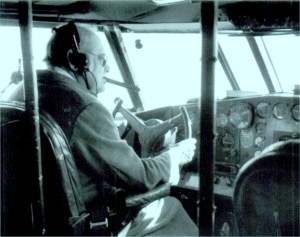 With transatlantic air travel not yet
commonplace, the British wartime leader’s impulsive decision to fly from Bermuda
was viewed as a characteristically audacious — and potentially perilous —
move. He flew
to Bermuda from Virginia aboard the British Overseas Airline Corporation’s
Boeing 314 flying boat “Berwick”.
With transatlantic air travel not yet
commonplace, the British wartime leader’s impulsive decision to fly from Bermuda
was viewed as a characteristically audacious — and potentially perilous —
move. He flew
to Bermuda from Virginia aboard the British Overseas Airline Corporation’s
Boeing 314 flying boat “Berwick”.
The British Prime Minister had been in Washington for several weeks after the sneak Japanese attack on Pearl Harbour on December 7, 1941 brought America into World War Two of 1939-1945.
He had been conferring with ally President Franklin Roosevelt at the White House and had delivered one of his most famous wartime speeches — “the United States, united as never before, have drawn the sword for freedom and cast away the scabbard” — to a joint session of the US Congress.
Soon after the flight departed for Bermuda, the Prime Minister entered the “Berwick’s” cockpit smoking his trademark cigar (see photo at right), and Captain Kelly Rogers waived the rules and let him continue, even allowing him to strike a match when it went out.
He tried the controls of the huge craft, as Kelly Rogers whispered into the co-pilot’s ear, ordering him to apply corrections only if it looked as if the plane was getting out of the Prime Minister’s control. Mr. Churchill was allowed to do a couple of slightly banked turns, and was photographed by one of the official cameramen.
During the flight he referred to his own flying experience which had begun in 1913 when he founded the Royal Naval Air Service. He compared the Boeing Clipper with the primitive aircraft he had known then. When Captain Kelly Rogers made radio contact with accompanying American fighter escorts, Mr. Churchill asked if he could speak to them, but the captain ruled that out as too much of a security risk. After about four hours they arrived at Bermuda's Darrell's Island airport Bermuda and Captain Rogers offered a sightseeing flight around the main and outer islands (with some then not as connected as they are now). The Prime Minister was summoned from his seat below and came on the flight deck to view the sights, Mr. Churchill sitting in the co-pilot’s chair. “The Prime Minister remained in the seat while I executed the landing,” Captain Rogers later recalled. “This is a privilege which is not normally accorded to passengers but conditions were ideal and I was able to handle all controls myself.” After landing in the Great Sound, the Imperial Airways (forerunner of the British Overseas Airways Corporation or BOAC and later, British Airways) aircraft “Berwick” moored at Darrell’s Island, the main flying boat station in Bermuda. Mr. Churchill was met on arrival by Governor Lord Knollys and taken to Hamilton aboard a Royal Air Force launch. From Hamilton he went to Government House and prepared for his address to the Bermuda Parliament. During his address to the House of Assembly later that same day, the Prime Minister told the Members of Colonial Parliament that “I have just signed a document implementing the agreement of September last for the leasing of United States Bases in Bermuda and elsewhere You in Bermuda happen to be called upon to play a part of especial importance and distinction. Everybody has to do his duty to the cause — first to the British Empire, but above that to the world cause. I wish to express to you my strong conviction that these bases are important pillars of the bridge connecting the two great English-speaking democracies. You have cause to be proud that it has fallen to your lot to make this important contribution to a better world.” He concluded his remarks by expressing his “profound gratitude” to Bermuda and Bermudians.
As it had been planned in advance that the Prime Minister would return to his homeland not by air but by sea, the battleship HMS “Duke of York”, with an escort of fast destroyers, had been dispatched to Bermuda to collect the Prime Minister to take him back to the United Kingdom. But while still in Bermuda, with bad news about Britain's war efforts continuing, even worsening, he decided he had to return to England the quickest possible way, by air, accompanied by only the most important members of his staff, including Sir Dudley Pound, Chief of the Naval Staff and Sir Charles Portal, Chief of the Air Staff. Powered by four 1,600 horsepower engines, the magnificent 106-foot long Boeing 314 aircraft had a wingspan of 152 feet and was designed to carry 68 passengers and 11 crew in unrivalled comfort for an aircraft of its era. Still, reaching the UK from Bermuda non-stop only just fell within the “Berwick’s” maximum operational range of 3,600 miles. The aircraft's departure from Bermuda on January 16 was not as easy as its arrival had been. “It was, as the Captain had predicted, quite a job to get off the water,” Churchill later recalled. “Indeed, I thought that we should hardly clear the low hills which closed the harbour. There was really no danger; we were in sure hands. The flying-boat lifted ponderously a quarter of a mile from the reef, and we had several hundred feet of height to spare.” Mr. Churchill was extremely taken with the luxury of this great clipper of the clouds, the experience rivaling that of a voyage on one of the great ocean liners widely used at that time. “There is no doubt about the comfort of these great flying-boats,” said the Prime Minister. “I had a good broad bed in the bridal suite at the stern with large windows on either side. It was quite a long walk, thirty or forty feet, downhill through the various compartments to the saloon and dining-room, where nothing was lacking in food or drink. The motion was smooth, the vibration not unpleasant, and we passed an agreeable afternoon and had a merry dinner.”
The journey from Bermuda back to England to the southern English port city of Plymouth was a protracted one, a distance of 3,330 miles which the great aircraft was covering at an average speed of 190 miles per hour. “Darkness had fallen, and all the reports were good,” said Mr. Churchill. “We were now flying through dense mist at about seven thousand feet. One could see the leading edge of the wings, with their great flaming exhausts pouring back over the wing surfaces. In these machines at this time a large rubber tube which expanded and contracted at intervals was used to prevent icing. The Captain explained to me how it worked, and we saw from time to time the ice splintered off as it expanded. I went to bed and slept soundly for several hours.” Near the conclusion of the flight, Mr. Churchill was briefly at risk from both friend and foe alike. On the morning of January 17, as the “Berwick” approached Britain, Captain Kelly discovered a navigational error in not sufficiently correcting for the prevailing winds. This had allowed the aircraft to drift south of its intended landfall. “When they did not pass over the Isles of Scilly at the expected time it was realized that they were heading for the port of Brest, the most heavily defended of all the German occupied towns in Europe,” said historian Martin Cherrett, editor of the World War II Today website. “They were only six miles off when the decision was made to turn abruptly north, and the Luftwaffe planes scrambled to investigate a raider heading in from the sea never found them. They were lucky again as they approached the Royal Navy base at Plymouth. Coming in from an unexpectedly southern direction they were now thought to be a German raider and ‘six Hurricanes from Fighter Command were ordered to shoot us down’ Churchill later recalled.” Fortunately — as the Prime Minister curtly noted — “they failed in their mission.”
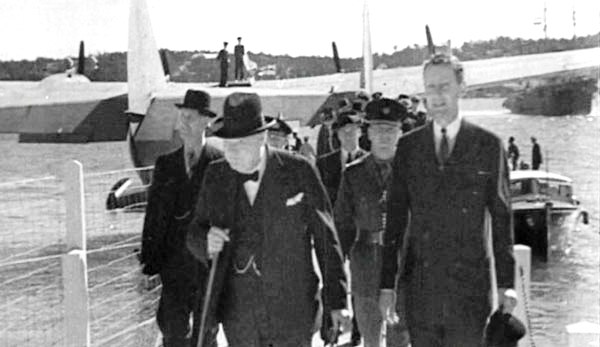
Prime Minister Winston Churchill's first visit to Bermuda, in January 1942 during World War 2.
1942. January 19. Three days after the Canadian Ladyboat steamship Lady Hawkins had left Halifax unescorted in the dead of night on January 16, hugging the relative safety of the American coast as far south as Cape Hatteras, N.C. before steaming for Bermuda, one of her regular ports of call, she was torpedoed, with great loss of life. It happened at 35-OONN 72-30W. Just before 2 am, two torpedoes slammed into her, destroyed six of the lifeboats, woke all passengers annd crew and she went down within 20 minutes. The German submarine was the U-66, Korvkpt. Richard Zapp/Knight's Cross.
The remaining boats were overloaded and many people struggled in the water before drowning. A few passengers and crew jumped into the dark Atlantic, some of them picked up by the only lifeboat that got away safely. Soon the small, nine-metre boat–certified to hold 63 people–was carrying 76 cold, wet survivors in serious danger of being swamped. Through the darkness, the voices of people calling for help could be heard. Chief Officer Percy Kelly, in charge of the lifeboat, later reported he gave “the agonizing order to pull away…there was nothing else we could do. The cries of the people in the water rang in my ears for years.” But the ordeal of the survivors, some 210 kilometres from land, was not yet over. Water began slopping over the lifeboat’s sides and everyone had to take turns bailing continuously. With a limited amount of food and water on board, breakfast and supper consisted of half a biscuit and a dipper of water each. Lunch was a mouthful of condensed milk. “Every noon, before the milk, we bowed our heads and thanked God for our deliverance. We prayed for strength and courage. It was done simply and without emotion.” As they grew weaker, some survivors fell into a coma and died. Others–babbling incoherently from shock–also succumbed. “The burials from the small lifeboat, such a dot on the large expanse of water, were conducted with care and reverence. We said a prayer as each body was gently lowered over the side.”
On the evening of the fifth day, severely weakened, everyone bedded down for the night, “wondering how much longer our ordeal would last.” Suddenly, they were jolted awake by cries from the helmsman who had spotted a ship. The dark outline of a ship came into view and stopped to pick them up. Many of the survivors were weeping as they scrambled aboard her. Shortly after the ordeal, a group of survivors wrote to Kelly thanking him for “holding them together and providing such leadership.” Later that year he was made a Member of the Order of the British Empire. The Master, Capt. H. O. Giffen, 85 crew, one gunner, and 164 passengers were lost. The Chief Officer, 21 crew and 49 passengers were rescued after 5 days in an open boat by the U.S. ship Coamo and landed at Puerto Rico. The Chief Officer, P. A. Kelly was awarded the MBE and the Lloyds War Medal for bravery at sea. Bermudian Noel Lumley Meyer was returning to Bermuda via Canada after service with and having been invalided out of the Royal Air Force. He was travelling on the Lady Hawkins. Meyer was last seen helping survivors into lifeboats, 71 persons later being rescued. At least one relative of the 71 survivors lives in Bermuda today.
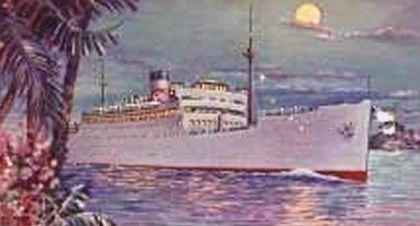
1942. February 11. Northwest of Bermuda, at 36-12N 67-14W, the German U-boat U-564, under the command of Reinhard Suhren and sent for operations off the US East coast, destroyed the Canadian tanker SS Victolite, 11,410 tons, bound for Venezuela. None of Victolite's crew survived.
 1942. February 18. The huge Free
French submarine Surcouf was accidentally sunk by collision with the
American freighter Thompson Lykes, on the Atlantic side of the
Panama Canal. She had been a frequent and popular visitor to Bermuda.
Ordered by the French Government in December 1927, she was launched on 18 October
1929 and commissioned in May 1934. She was captured by the Royal Navy on July 3,
1940 because France had surrendered to the Germans. Instead of being
sunk by the Royal Navy at Mers El Kebir like other French warships, Surcouf was sent to Bermuda in June
1941 sailing under Free French colors. From late July to late November 1941, the boat was refitted in New England.
When sunk she was lost with all hands. Her range was 18,500 kilometers (about 10,000
nautical miles) at 10 knots, 12,600 kilometers (6,800 nautical miles) at
13.5 knots and 110 kilometers (60 nautical miles) at 5 knots, submerged. Her
test depth was 80 meters or 250 feet. Her capacity was 280 tons. Her
complement was 8 officers and 110 men. Her armament was two 203 mm (eight
inch) guns in a twin turret, two 37 mm anti-aircraft cannon, four 13.2 mm
anti-aircraft machine guns, eight 550 mm torpedo tubes, with fourteen
torpedoes carried and four 400mm torpedo tubes, with eight torpedoes
carried. She also carried one aircraft, a Besson MB 411 float plane. On February 12, she had left Bermuda for the war in
the Pacific. An official joint U.S. and Free French report stated she was accidentally rammed and sunk, with
the accident due to both vessels running at night with no lights because of
the menace of German U-boats. A later French investigation commission
corrected the initial report and stated that the Surcouf had been sunk by US
planes in the morning of the 18th in a "friendly fire" accident.
There has been much other speculation.
1942. February 18. The huge Free
French submarine Surcouf was accidentally sunk by collision with the
American freighter Thompson Lykes, on the Atlantic side of the
Panama Canal. She had been a frequent and popular visitor to Bermuda.
Ordered by the French Government in December 1927, she was launched on 18 October
1929 and commissioned in May 1934. She was captured by the Royal Navy on July 3,
1940 because France had surrendered to the Germans. Instead of being
sunk by the Royal Navy at Mers El Kebir like other French warships, Surcouf was sent to Bermuda in June
1941 sailing under Free French colors. From late July to late November 1941, the boat was refitted in New England.
When sunk she was lost with all hands. Her range was 18,500 kilometers (about 10,000
nautical miles) at 10 knots, 12,600 kilometers (6,800 nautical miles) at
13.5 knots and 110 kilometers (60 nautical miles) at 5 knots, submerged. Her
test depth was 80 meters or 250 feet. Her capacity was 280 tons. Her
complement was 8 officers and 110 men. Her armament was two 203 mm (eight
inch) guns in a twin turret, two 37 mm anti-aircraft cannon, four 13.2 mm
anti-aircraft machine guns, eight 550 mm torpedo tubes, with fourteen
torpedoes carried and four 400mm torpedo tubes, with eight torpedoes
carried. She also carried one aircraft, a Besson MB 411 float plane. On February 12, she had left Bermuda for the war in
the Pacific. An official joint U.S. and Free French report stated she was accidentally rammed and sunk, with
the accident due to both vessels running at night with no lights because of
the menace of German U-boats. A later French investigation commission
corrected the initial report and stated that the Surcouf had been sunk by US
planes in the morning of the 18th in a "friendly fire" accident.
There has been much other speculation.
1942. February 18. Charles Robert Watkins-Mence, Controller of Imperial Censorship at Bermuda, made a sudden appearance with a group of his subordinates in Federal court yesterday to testify at the trial of seven alleged Nazi spies. The group had flown up from the island, where air mail sent aboard the clippers is examined, to be surprise witnesses for United States Attorney Mathias F. Correa.
1942. March. Burial at the Royal Naval Cemetery, Ireland Island, Bermuda, Grave No 396, Plot A, of 21 year old French crewmember Marcel Alexandre Le Dantec of the Free French submarine Surcouf.
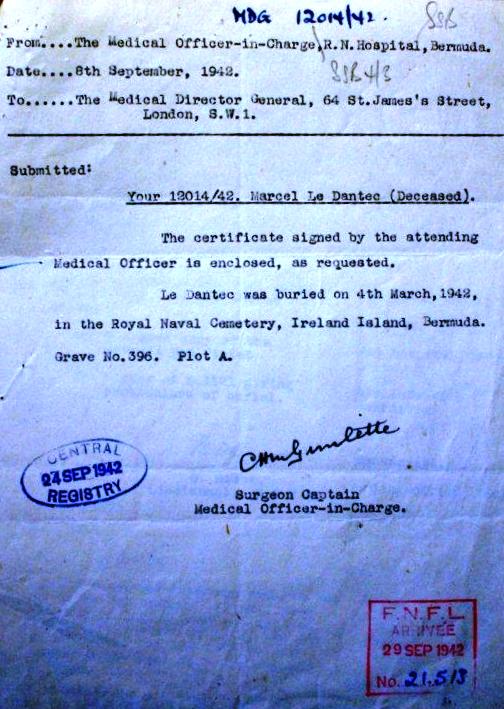
1942. March 22. The steamship Lady Nelson, one of the Canadian Ladyboats that called at Bermuda, and a British steamship that also called regularly in Bermuda bring coal from England, were both torpedoed and sunk by German U-boat U-161 in the harbour of Castries, St. Lucia, by a German submarine. 15 passengers and 3 crew from the Lady Nelson died. The Umtata was a bigger vessel than the Lady Nelson. (The latter was later refloated and repaired. In April 1943 she converted as a Canadian hospital ship. HMCS Lady Nelson carried 515 beds and completed 30 voyages by Feb. 1946, bringing home from Europe 25,000 wounded men).
1942. March 25. The British freighter, motor tanker, Narragansett, 10,389 tons, constructed in 1936 in Germany by Friedrich Krupp Germaniawerft AG, Kiel, owned by British Mexican Petroleum Co, London, was torpedoed by German submarine U-105 commanded by Heinrich Schuch. Her position was 4.46N, 67.40W - Grid CB 7779., about 100 miles from Bermuda. She was carrying a full load of fuel. The ship was found on fire by a US Navy VP plane flying from the US Navy Operating Base Bermuda, and the report read: “SS ‘Narragansett’ torpedoed 0410Z/25 34-46 N., 67-40 W. COMINCH C 250531. VP took off at dawn March 25th. To search vicinity SSS from ‘Narragensett’. Found ship 34-30 N., 67-36 W., bottom upat 1200Z. Ship sank at 1350Z. VP continued to search during day with no sign of survivors. NOB BERMUDA C 252351.”
1942. April 1. A US Navy Submarine Base on Ordnance Island, near King's Square, St. George's, Bermuda, was officially activated, although for several months it had been operating unofficially with US Navy submarine R-1 and other units. It had earlier gained its name as a Royal Army Ordnance Corps (RAOC) depot, supplying munitions to forts and batteries around the Colony. As it was no longer useful in this role the US Navy was allowed to use the Island from 1942 to 1945 as a submarine base.
1942. April 16. US Navy submarine R1, after having established since February a patrol line between Bermuda and Nantucket Island, was on patrol 300 miles northeast of Bermuda when it sighted, attacked and probably damaged a surfaced U-boat.
1942. May 1. The US Navy issued this optimistic image of its Brewster Bermuda or Buccaneer aircraft, despite its later limited success.
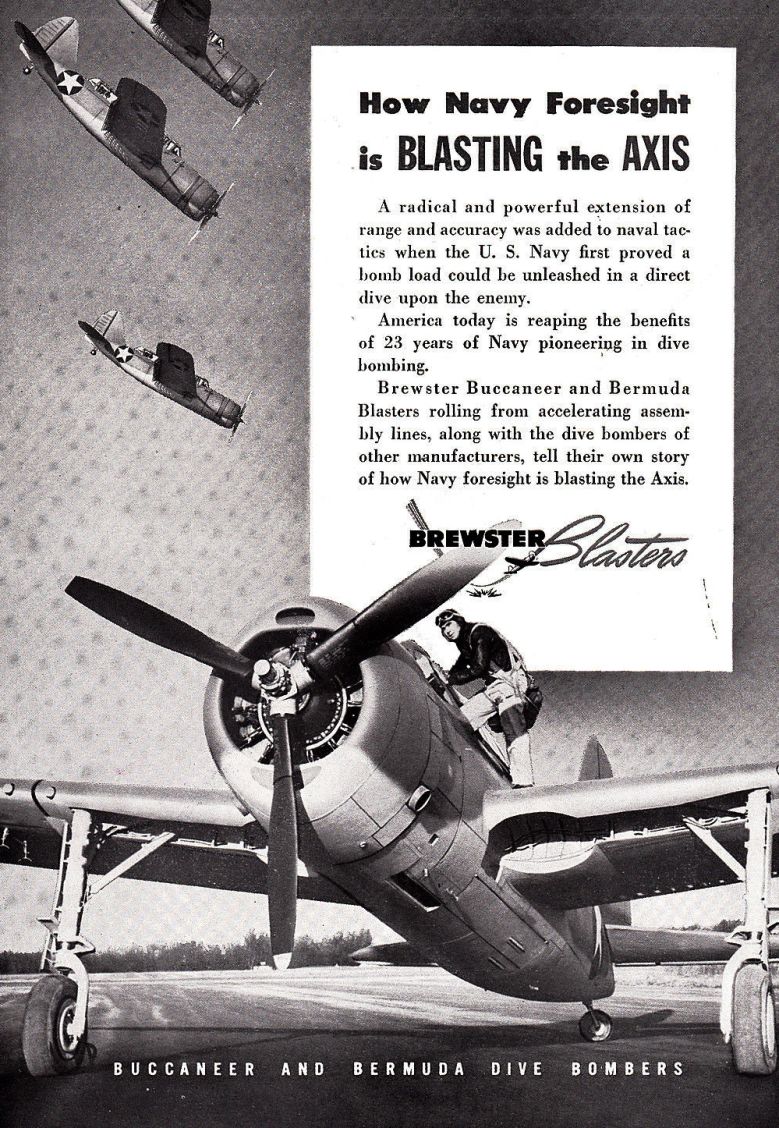
1942. May 1. The ship James E. Newsom, 671 tons, was shelled by German U-boat U-69 northeast of Bermuda at 35-SON 59-40W.
1942. May 6. The Canadian Ladyboat Lady Drake, under the command of Captain Percy Kelly, while on the final leg of a homeward journey between Bermuda and Halifax, was torpedoed at 35-43N 64-43N by German U-boat U-106. Luckily, the ship sank slowly. While 12 people lost their lives, 260 made it to five lifeboats. “Nobody even got wet feet,” one survivor later recalled. At dawn on the second day, a liner came towards the lifeboats at high speed and sailed away just as quickly. It was the Queen Mary, pressed into service as a fast troopship, on her way to New York and unable to stop because of the danger from lurking submarines. As she disappeared into the distance, her lamp signaled repeatedly, “I will report…I will report.” On the morning of the third day an American ship picked up the survivors and took them to Bermuda. As a result, the service stopped until 1947.
1942. May 6. When the USS Owl arrived in Hamilton that morning with rescued passengers from German U-boat torpedoed ships including the Lady Drake mentioned earlier, a reception was held for them. The Mayor of Hamilton, S. P. Eve was on hand, along with the Governor of the colony and the Commandant of the US Naval Operating Base. The local newspaper Colonist Daily reported “On the dock as the rescue ship warped in were officers of the various British and American Services in Bermuda. Along Front Street were lined ambulances from the U.S. Mobile Base Hospital. The Director of Health, Dr. Henry Wilkinson, and civilian, army and navy doctors were there. The grim event was not without its light touch. Among the survivors was a Greek prisoner who was in the brig of the torpedoed ship. He is now comfortable in Hamilton Gaol.”
1942. Another tiny scale insect known as the Juniper scale (Carulaspis viscid), only just visible to the naked eye, was accidentally imported from California as the result of the building of the new American military bases in Bermuda. The cedar scale epidemic spread like wildfire through the trees, causing the death of 96% of the cedar population. No longer were the hill sides, the valleys, the coated banks and the road sides being covered and flanked with healthy green cedar trees. Prior to this, landowners and developers had ensured by mutual consent and government planning that just sufficient trees were felled to build houses and other buildings, with and driveways frequently having detours in order to save some good trees. Property owners had always taken extreme care to preserve as many trees as possible.
1942. Conscription began in Bermuda for all fit men below a certain age. One result was that it swelled the ranks of the Bermuda Militia Artillery to five offers and 120 other ranks.
1942. The Bermuda Flying School closed, due to a surplus of trained pilots. (In the UK, an excess of pilots who had volunteered to serve from throughout the British Commonwealth of Nations meant that the Bermuda Flying School (BFS) established in 1940 was advised that no further pilots were required). By then, eighty pilots had been sent to the RAF and Fleet Air Arm. The BFS was not closed but renamed as the Bermuda Flying Committee (BFC). The organisation overseeing it was converted into a recruiting and selection arm of the Royal Canadian Air Force, sending 60 volunteers, primarily from the various local military units, to that service for aircrew training before the end of the War. Bertram Work, one of its mainstays, and Major Montgomery-Moore oversaw the conversion of its administration into a recruiting arm for the Royal Canadian Air Force (RCAF), sending sixty aircrew candidates to that service before the war's end. Sixteen Bermudian women were also sent to the RCAF to perform roles including Air Traffic Controller. Major Montgomery-Moore had been dispatched to Canada to make arrangements for it to send its aircrew candidates, and he was to receive a commendation from the RCAF at the end of the war for his efforts. (Despite that steady outward trickle, however, fears of weakening the garrison meant that a moratorium on further drafts from the island was in force until 1943. By then, the likelihood of a German attack, or sabotage, had greatly diminished, and American forces, including artillery detachments, had been built-up on the island).
1942. May. The Bermuda Convoy system implemented in May 1940 was discontinued and replaced with secretive new naval strategies to help combat a worsening situation for the inward and outward convoys.
1942. The Royal Canadian Navy began to distinguish itself. Its commitment in the Battle of the Atlantic that had commenced and was to last for 18 months, was profound. The RCN was about to include some 270 ocean escort warships which by 1943-1944 made it the third-largest navy in the world. It delivered safe passage to over 25,000 ships from the USA to UK. They delivered nearly 165 million tons of supplies to the UK and Allied Forces that were to liberate Europe.
1942. May. Bermudian John Edward Darrell Carlyle Brewer of 215 Squadron Royal Air Force, was killed in action over Singapore, fighting the Japanese.
1942. May. Catherine Sophia Perinchief, who owned 8.5 acres of land near Somerset Bridge, which she inherited from her father in 1929, was approached by the US Engineers Office in Bermuda, with a request to purchase 2.333 acres of her property west of the railway tracks”for the building of the US Navy Operating Base. The offer of £2,500 in compensation was promptly turned down by her as she had valued the 2.333 acres, including one house, a stable and a privy, at £8,080. The Bermuda Government gave Kate Perinchief the choice of compulsory acquisition for US Base purposes’ with an offer of £2,213 or arbitration. Kate Perinchief chose arbitration, reduced her claim to £4,580 and finally agreed to a payment of £4,000. Later, she made local history as a friend of a German submarine captain captured and interned in Bermuda.
1942. May 7. US Army captain Fred Clipper arrived in Bermuda with his unit. He was posted to the Island to protect the country as well as the shipping supply convoys from enemy submarines lurking in the Atlantic. Within a year of his deployment he married Bermudian Rosemary Champness and went on to start a family and call the Island home. Mr Clipper was born in Baltimore, Maryland and was 32 when he arrived as part of the US Army artillery division.
1942. May 22. The ship Frank B. Baird, 1,748 tons, was shelled by German U-boat U-158, south east of Bermuda at 28-03N 58-50W.
1942. June 7. USS Gannet (AVP-8) was sunk after being torpedoed by German submarine U-653 off Bermuda. The stricken vessel was accompanied by HMS Sumar, based at the HM Dockyard, one of the crew of whom was Bermudian Kenneth Dunkley who had joined the Royal Navy when war erupted. Both ships were looking for survivors from the cargo ship Westmoreland, also sunk by the same German U boat.
1942. June 8. 62 passengers rescued from German U-boat torpedoed ships arrived in Bermuda in two aircraft, daringly landing by two flying boats of VP-74 based at the US the Naval Operating Base Bermuda. They included 22 members of the crew from the USS Gannet sunk the previous day.
1942. June. Arrival in Bermuda from Baltimore Maryland via the Norfolk VA Navy Yard, to help defend Bermuda against attack by Germany or Japan or both, of the US Army's General Reserve (Mobile) which comprised the 3rd Battalion 89th Infantry and Battery A, 214th Field Artillery Battalion. Battery A was stationed at the one-time British Army post of Fort Langton in Devonshire and its main firepower weaponry were four 105mm howitzers. At that time, this was the only mobile artillery in Bermuda and was vital to the Land Defence. A howitzer could fire a 33-pound projectile up to 12,400 yards and its high trajectory was its main advantage over coast artillery for local defence. The unit's 110 men were based there until April, 1943. When not engaged in military drills they discovered and unearthed from the moat of the fort three mid to late 19th century 10-inch Rifled Muzzle Loaders British Army guns, which had comprised the seaward emplacements of the Fort in the 1880s. (These historic guns were later moved to Fort Hamilton). Battery A came originally from the 110th Field Artillery at Pikesville, Maryland. The vessel that brought them, the USS Joseph T. Dickman, accompanied by two destroyer escorts, also brought the 693rd Signal Aircraft Warning Company. Battery A was under the command of Captain Frederick W. Clipper, who a year later married a prominent Bermudian lady.
1942. June 1. Two more vessels were added to the Naval Examination ships, the Sumar and the Norwegian whaler GVAS II. The Owera was withdrawn and sent for duty in Jamaica.
1942. June 28. 99 passengers from the German U boat-torpedoed transport ship Jagersfontein were rescued and brought to Bermuda by a US Navy destroyer.
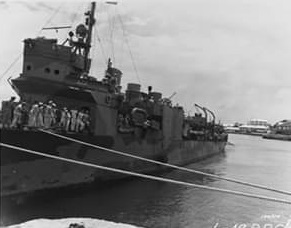
1942. June 30. The German U-boat U-158, type IXC, was depth charged west of Bermuda at coordinates 32 degrees 50 N 67degrees 28 W by US a naval aircraft Martin PBM Mariner based in Bermuda. It was a direct hit but the depth charge did not explode in impact. It lodged itself into the teak planking of the submarine's deck. When the submarine submerged to try to escape the charge detonated when it reached its pre-set trigger depth. None of the 54 crew survived. The submarine, launched from Bremen in October 1940, had gone on only two combat patrols but had sink 17 ships totaling 101,321 gross registered tons. One of those ships had been the Darina, sunk about 500 miles east southeast of Bermuda on May 4, 1942.
1942. June 30. With the USA having become the main source of supplies for Britain, the commencement of the HX convoy system shifted to New York. It was decided by the British and US governments that the task of defending these convoys would be borne at least in part if not in the majority by mostly Halifax-based Royal Canadian Navy ships on the sea line between New York and Newfoundland and back. RCN ships based in Bermuda also played a key role.
1942. Summer to 1943. The German U-boat "wolfpack" offensive in the north west Atlantic location that affected Bermuda became significantly more menacing than in 1941.
1942. July 3. 372 survivors from the U-boat torpedoed British ship City of Birmingham landed in Bermuda.
1942. July. Dutch tugboat Roode Zee arrived in Bermuda via the Admiralty to assist the Royal Navy in war-time rescue, direction-finding and ship-steering operations.
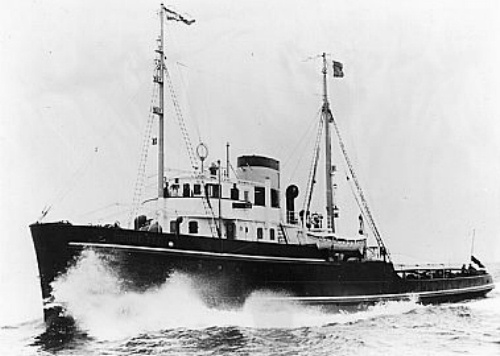
Royal Navy photo 1942 of Roode Zee
She was completed on April 25, 1938 by L. Smit and Zoon, Kinderdijk, YN889. She was Delivered to L. Smit & Co's Internationale Sleepdienst, Rotterdam. She was launched there on July 19, 1938. Her measurements were length 45.24 metres, breadth 8.10 metres, draught 4.85 metres. She was 468 gross registered tons, had 1240 horsepower from 2 6-cylinder MAN diesel engines. In 1940, when Germany invaded the Netherlands she escaped Holland, arrived complete with her crew in England and there was placed by UK Admiralty in Rescue Tug Section, pennant W 162, stationed at Bermuda until 1944..
1942. Bermudian George Wendell West, died in 1942 at Timor from war wounds.
1942. 21 August. HMS Bermuda, a Colony class cruiser, displacement 11,040 tons, overall length 555 ft 6", with twelve six inch guns in four triple turrets. was launched at Clydebank, Glasgow, Scotland and completed 21 Aug 1942. She served in WWII and was then refitted 30 Jun 1944 to 27 Mar 1945. She visited Bermuda 3 times: Feb 1958, Jul 1959, and Feb 1962.

HMS Bermuda, Royal Navy photo
1942. Late summer. The Riddle's Bay area, which had formerly been used as a golf course and resort area, was rehabilitated and equipped as a recreational area for US naval personnel. Concurrent with the construction program underway at the several areas leased by the Navy, the Army was developing Kindly Field, on Long Bird Island, at the eastern end of Bermuda. At this airfield the Army, pursuant to Joint Board directives, provided all landplane facilities constructed at Bermuda, including those used specifically by naval aircraft. Here, within the base area, the Army contractor, on a reimbursable basis, built facilities for the temporary support of one carrier air group of 90 planes. These included barracks for 550 men and 125 officers, messing facilities, storage buildings, nose hangars, and radio aids. Inasmuch as Bermuda had no fresh water from ground sources, it was obtained for the air station and the operating base by use of seven evaporating units with a daily capacity of 50,000 gallons, and a system of rain-water catchment areas, which, including roof areas, totaled 20 acres. The water thus collected was stored in reservoirs and chlorinated before entering the distribution system. Southlands, located along the south shore line of Hamilton Island, was secured under a short term lease for the development of an anti-aircraft training school. Construction included a night-vision training building, repair shops, magazine loading sheds, magazines, instruction buildings, and barracks, gun platforms and control tower, roads, walks, and services. This activity was transferred to Guantanamo Bay in January 1945.
1942. September. Pilot Officer Hubert Fortesque Watlington, Royal Canadian Air Force, was awarded the Distinguished Flying Medal DFM). He enlisted in the Bermuda Volunteer Engineers on 1 September 1939 and was discharged to enlist in the Royal Canadian Air Force, 12 January 1940. "This officer has displayed exceptional ability and his courage has been an example to his fellow pilots. On this date he was the pilot of an aircraft in the leading flight of a force detailed to attack an enemy convoy with a formidable escort of destroyers and fighter aircraft. Despite the opposition Pilot Officer Watlington pressed home his attack from short range, and although both of his air gunners were wounded during attacks by fighters, this Officer succeeded in evading his attackers and flew his aircraft back to base safely.
1942. September 10. At newly completed Fort Bell, St. David's, the United States Army Air Corps Administration building was painted in camouflage colors and shapes, including the roof. It was once a Bermuda home with two large chimneys that existed before the base was constructed. Also camouflaged were a number of other buildings including the air traffic control tower
1942. September. US Navy submarine R-1, after continuing her coastal US patrols based at Ordnance Island, Bermuda and recently refitted, began rotating between Bermuda and New London and later had an extensive conversion there to enable her to participate in the development of ASW equipment and tactics.
1942. October 1. HMS Newcastle, a Royal Navy ship damaged by a torpedo from a German submarine, slowly entered Bermuda under her own steam, en route to the Boston Navy Yard for substantial repairs. While in Bermuda and based at the Dockyard, she carried several Supermarine Walrus flying boats, one of which was launched on a training run. But the aircraft crashed into the sea of Daniel's Head and the rear gunner was killed.
1942. November. Bermudian Harris, Elgar Frederick, a British Army parachutist, a Somerset man of the Perinchief family, died in Tunisia in November 1942, along with all the members of his group who jumped with him from their plane. They were never seen again.
1942. November 8. Royal Navy ship HMS Bermuda carried out the bombardment by sea of the French fortress of Cape Matifon on the eastern side of the Bay of Algiers and the French fortresses of Duperre and L'Empereur guarding that harbour. At one point it seemed the French might strike back against the British but they did not. The fortresses had been shelled to render them ineffective to the German forces who were about to enter defeated France.
1942. December 4. The 31st Naval Construction Battalion (Seabees) arrived in Bermuda, with 27 officers and 1,027 men. They were brought in because construction of the Bermuda bases had slowed, due to difficulties in getting enough civilian construction workers in both the USA and Bermuda. They ensured the completion of all activities at the air operating base, air station, and submarine base in St. George's and their full use.
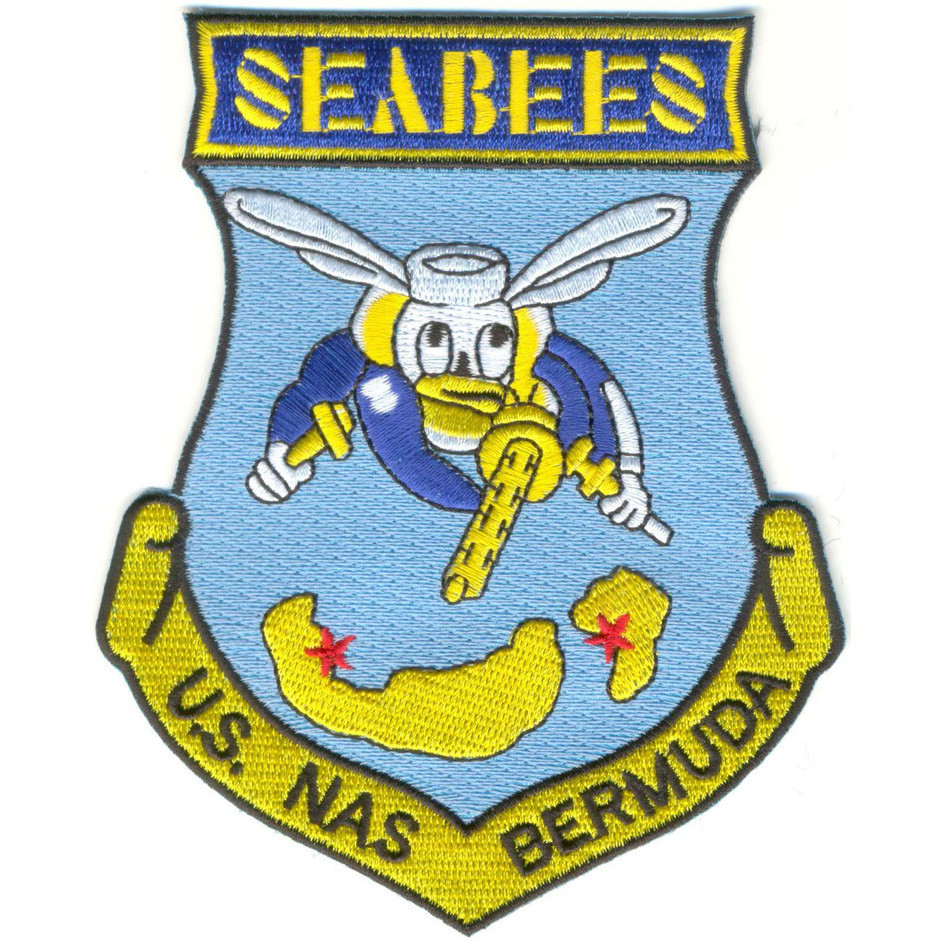
1942. December 10. The Green Lantern, a family-owned diner, on Serpentine Road, Pembroke, was opened by Cyril and Bernice Burns. Mr Burns bought the building for £275 from Jos Brown after previously acquiring the business from William Steede and Faith Bassett-Steede.
1943. January 10. Crash with fatalities of A US Navy PBY Catalina operating from Bermuda. It was a German submarine hunter. It was based at the United States Naval Operating Base (NOB) at Southampton. It attempted a pass over the target area on the Great Sound and unexpectedly dove into the water at a high rate of speed near Grace Island. The entire eight-man crew was killed in the first-ever deadly air crash in Bermuda.
1943. January. HMS Castle Harbour was withdrawn from her Bermuda station for a refit and scheduled for transfer to the Mediterranean but while awaiting this she was torpedoed and sunk in the Caribbean.
1943. February 27. The 49th Naval Construction Battalion (Seabees), with 27 officers and 1,080 men, arrived a month before the contract's termination and renewal, to augment the 31st Naval Construction Battalion which had arrived two months earlier in Bermuda. Together the battalions completed such unfinished projects as roads, utilities, grading, accessory buildings, and general clean-up. In addition, they undertook the operation, maintenance, and repair of the entire naval establishment under the cognizance of the US Navy's Public Works Department. Once construction was finished these two units served under the US Navy's Bermuda Public Works Department and took over maintenance, repair, and operational duties for all U.S. Naval activity in Bermuda.
1943. March. 943. May. Recognition of the Royal Canadian Navy's contribution to the war effort came with the decision of the Allies to create the Canadian Northwest Atlantic as a separate area of RCN and RCAF responsibility, under the command of Canadian Rear Admiral Leonard Murray. This placed the RCN in charge of all northern Atlantic convoys until the end of the war. It remained the only major theatre of the war to have been commanded by a Canadian.
1943. Bermudian Geoffrey Welch, flying for the Royal Air Force, was killed in action over Benghazi in Libya during the North African campaign.
1943. April 7. Flying instructor Captain Ed Stafford, originally from the USA, who had moved from the Bermuda Flying School in 1942 where he was the chief instructor after the BFS was no longer in operation to RAF Transport Command, was shot down, becoming a prisoner-of-war in Germany. He was piloting a Catalina on a flight from Darrell's Island to Largo in Scotland. Nearing Britain, the crew were advised by radio to divert to RAF Mountbatten, near Plymouth, due to bad weather. Evidently due to a navigational error, they found themselves over occupied France and were shot down near Landéda, Brittany, by anti-aircraft artillery and two Luftwaffe fighters. The first officer was killed outright, and the navigator wounded. Stafford succeeded in landing the aeroplane two miles offshore, still under fire. Three, including Stafford, were pulled from the water by French fisherman. The bodies of two other crewmen washed up two days later, and the third three weeks later. As a POW, Captain Stafford headed a team of Allied orderlies in a wing of the Hohemark hospital, in Hesse, which was dedicated to the care of Prisoners of War from the Dulag Luft POW Camp in Oberusel.
1943. April 8. Construction of the US Bases in Bermuda under the-then-operable contract was terminated and a new contract negotiated with the original contractors to complete several major items of dredging still unfinished. This second contract remained active until June 28, 1944.
1943. April. Last publication of the Bermuda Beacon, a US military monthly, published since 1941 for the US Army's Fort Bell and Kindley Field by the US Army Engineers. Initially a safety magazine, later on other topics too, it was created for the-then US Army Air Force (predecessor of the USAF) air base personnel in Bermuda, the idea of Benjamin Schwartz (Bermuda Base Contractors) and Loring Cox (Mail and Records section, USED.). It had some nice stories and original graphics during that period. It concluded with the end of major work on the Air Base, and the termination of the original construction contract. The publication was limited to a 700 copy print run.
1943. April 13. HMS Queen of Bermuda, after having served in various roles including taking badly wounded Australian soldiers back home, sailed of the Clyde to Glasgow, Scotland, where she was paid off as an Armed Merchant Cruiser, with her engines no longer able to keep up speed in convoy and related duties. She was replaced by newer, faster and smaller warships and once again became a troopship until long after the war ended.
1943. April. John Bloren Watlington and his long-time friend Hal Dale, both of Bermuda, after serving with the Bermuda Volunteer Rifle Corps (BVRC), left Bermuda for the Royal Canadian Air Force Flying School, from where they graduated later as Pilot Officers. John had earlier been educated at Saltus Grammar School and Ridley College, in Canada, before going to University of Pennsylvania.
1943. April. HMS Argonaut called into the South Yard for repairs after having her entire stern and part of her bow blown off by an Italian submarine.
1943. April. Bermuda hosted a 12-day conference on European refugees, one remembered by Jewish chroniclers abroad (because at that time there were only a few Jews in Bermuda) for avoiding the issue rather than for doing anything to save the lives of Jews and other Holocaust victims. Its abject failure to achieve anything is also believed to be one of the main reasons for the suicide a few weeks later of Szmul Zygielbojm, a member of the Polish government-in-exile, who made it his mission to tell the world about the Holocaust. Shrouded in secrecy, held significantly at the same time as the heroic Jewish uprising in the Warsaw Ghetto -- the meeting brought together small delegations from the United States and Great Britain following persistent reports that Jews were being murdered wholesale by the Nazis. Despite this, there were clear instructions to minimize coverage in the local or international media. The Bermuda Government volunteered to pay for the costs and as a result Horizons and other locales billed the Government £771 or more for accommodation. The delegates gathered to discuss what could be done, and yet did nothing to deal with the situation. Neither side was willing to allow Jewish refugees to come to their country.
The Allies feared that Hitler would land them with millions of Jewish refugees, forcing the diversion of ships away from the war effort to take the fugitives to safety. The only thing they were really willing to do was to help the Jews who had already saved themselves by reaching Spain. In the end, the conference’s sole outcome was to move 630 of them to North Africa. The gathering ended without saving a single Jew. Locales for the meetings were the Mid Ocean Club, Horizons and Belmont Hotel. Unwilling to give full credence to the reports of Jewish genocide, the delegates were instructed to discuss the problem of European refugees generally. That little would come from the conference was presaged by a telegram from a British official to the Bermudian hosts: "Our point of view which is being made clear to Americans is that excessive publicity is to be deprecated as calculated to raise exaggerated hopes. Outcome of meeting which must perforce be of a largely exploratory character." Britain was represented by Richard Law, parliamentary undersecretary of state for foreign affairs; Osbert Peak, parliamentary Under-secretary of state for the Home Office, and George Hall, Financial Secretary to the British Admiralty.
A lower ranking delegation was sent by the United States. Headed by Princeton University president Harold Dodds, it included U.S. Sen. Scott Lucas (D-Ill) and Rep. Sol Bloom. Although Jewish, Bloom, who served as chairman of the House Committee on Foreign Affairs, was protested by American Jewish groups as being unsympathetic to the plight of his co-religionists. Three venues were made available to the delegates for their meetings and lodgings: the Belmont Manor Hotel in Warwick, the Mid Ocean Club in Tucker's Town and the Horizons in Paget. As the Bermuda government only hosted the meeting but played no role in its proceedings, its archives do not include reports of what went on inside the meetings.
An article in the Encyclopedia of the Holocaust -- forwarded to Heritage by officials at the U.S. Holocaust Memorial Museum -- said the choice of Bermuda as the venue was calculated. "Assistant Secretary of State Breckinridge Long suggested the island of Bermuda, which, because of its inaccessibility during wartime, would allow both sides control of the press, and the conference itself could be kept free of the representatives of private agencies such as the Joint Distribution Committee (JDC) and the World Jewish Congress." This encyclopedia article was written by Henry L. Feingold, author of The Politics of Rescue. "The composition of the American delegation; the refusal to include Joseph Schwartz, head of the European branch of the JDC; the rejection of rescue suggestions by Joseph Proskauer, head of the American Jewish Committee, and by Rabbi Stephen S. Wise, head of the American and World Jewish congresses; and the fact that the State Department limited the number of press correspondents to five, representing the major news agencies, convinced even the most hopeful rescue advocates (mostly, but not exclusively, American Jewish groups) that the Bermuda Conference would be simply a ploy to deflect an aroused public opinion." The only member of the American delegation who was concerned for the Jewish victims of the Nazis was "George Backer, whose leading positions in the Organization for Rehabilitation through Training (ORT) and the Jewish Telegraph Agency made him especially knowledgeable about the fate of European Jewry," according to Feingold. Backer tried to get the conference to back aggressive rescue efforts, specifically proposing a campaign to save "125,000 Jews in eastern Europe who faced certain death" as well as pleading "to save thousands of children who could assure a Jewish future." Both pleas were rejected. Instead of sympathy for Jews and other victims, "both delegations manifested the fear that Berlin would 'dump' refugees with the Allies and use them as a weapon to compromise the Allied drive for final victory," according to the encyclopedia article's author. Subsequently "The American Jewish press was virtually unanimous in condemning the conference," he wrote. "Some spoke of it as particularly cruel duplicity in the midst of a mass-murder operation. Public protest, rather than being stilled, reached new heights. Later, the rest of the world reacted with disdain and anger to what had transpired on the Island.

Conference members gathered in Bermuda for the event mentioned above.
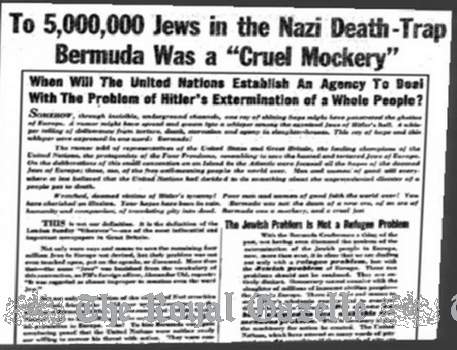
How it was condemned by a prominent New York newspaper
1943. May 1. Death in Italy of Bermudian prisoner-of-war Outerbridge, James. Born 5 September 1922. Family lived in Flatts, Bermuda. Educated at Whitney Institute, Bermuda; Rossall School, England. Accepted for Rhodes Scholarship but was interrupted by war. Flying Officer, Royal Air Force. Assigned to 458 Squadron, Royal Australian Air Force (RAAF), then based at Luqa, Malta. He piloted a Vickers Wellington Mark 8 bomber HX 522. It took off from Luqa at about 2020 hours on March 24, 1943 but either had an engine failure or was struck by enemy fire. It ditched off the coast of Sicily. M.E.F. 1941-3. Killed, shot 1 May 1943 while attempting to escape from Allied P.O.W. Camp 21 in Chieti, Italy, while being transported by train by the Germans and Italians to POW prisoner-of-war camp 39 in Palma, Italy, when the train stopped near Rimini. He may have been trying to get to San Marino, then a neutral state 20 kilometres away. During his attempt to escape he was seen and intercepted by a guard who shot and killed him. His body was later identified formally in the mortuary chamber of the Axis military hospital of Rimini. His name is engraved on a tombstone in the military cemetery of Ravenna, Italy, see photo below.
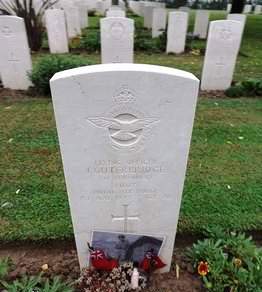
1943 grave of James Outerbridge
1943. May 11. Less than a month after the Bermuda Conference re Jewish refugees and Holocaust victims had ended, Szmul Zygielbojm, a member of the Polish government-in-exile, who made it his mission to tell the world about the Holocaust, took his own life at his home beside Porchester Square, London. He was said to be dismayed by the failure of the conference and had learnt that his wife, Manya, and their son, Tuvia, had died inside the Ghetto. “The responsibility for the crime of the murder of the whole Jewish nationality in Poland rests first of all on those who are carrying it out,” he wrote. “But indirectly it falls also upon the whole of humanity, on the peoples of the Allied nations and on their governments."
1943. May 15. VP-31 was redesignated VB-105 in preparation for its transition from patrol flying boats (VP) to land-based bombers (VB). Fifty percent of the squadron's assets, flight crews and ground support staff were supplemented by VP-52. During the four months of training detachments were sent to Kindley Field, Bermuda, for operational long-range training flights.
1943. May 19. the Angelus, 255 tons, was shelled by German U-boat U-161, north of Bermuda at 38-40N 64-00W.
1943. May 20. Wedding of Captain Frederick W. Clipper, US Army based in Bermuda and Bermudian Rosemary Champness. She was a granddaughter of Samuel Saltus Ingham, once the owner of the home that is now the Royal Hamilton Amateur Dinghy Club.
1943. The introduction to Bermuda of a mosquito larvae-eating minnow in places including the Pembroke Canal.
1943. June. The American yacht Colonel G. Ball, formerly the Sialia, later Egeria, was wrecked on the eastern side of Bermuda. At the time she was wrecked she belonged to the US Army Transportation Corps and used as a harbor boat. She had been caught in a storm and taken way out to sea.
1943. July 1.The US Navy bought the large harbor tug Shabonee in Bermuda, for use at the recently completed US Navy Operating Base in Bermuda. The tug had been built in 1915 at the Smith Dockyard in Middleborough, England. Manned by a civilian crew she had been earlier based in Bermuda assisting the Royal Navy. (The tug operated at the Naval Operating Base at Bermuda until 27 April 1945, when she was ordered to report to the Commandant, 3d Naval District, for duty at Tompkinsville, N.Y. She served there until 29 August 1945, when she was placed out of service preparatory to disposal. On 17 September 1945, Shabonee was struck from the Navy list).
1943. July 15, USAF/ex USAAF aircraft crashed with fatalities. Official USAF record of 32041 (ex USAAF B-24D 42-40440, VB-105) in Castle Harbour, at the end of the military base runway, after takeoff Bermuda. 11 Crew killed. One of the crew of the Bermuda-based 6th Crash Rescue Boat who tried to rescue the aircraft crew was Bronson Hartley.
1943. June 16. Comedian Charles Chaplin, then 54 years old, married his fourth wife, Bermuda-born 18-year-old Oona O'Neill, daughter of playwright Eugene O'Neill, in Carpenteria, California. They went on to have eight children and remained married until his death on 25 December 1977.
1943. June 30. Captain Jules James, United States Navy, Bermuda, made this public comment: "I trust that the strategic position of Bermuda will be fully recognised early in this war. It is believed that Bermuda is of as great importance in the Atlantic as Pearl Harbor is in the Pacific."
1943. July. Bermudian Thomas, Alfred John, Royal Air Force, was killed in a bombing raid over Germany.
1943. July. Bermuda issued a St. David's Lighthouse postage stamp.
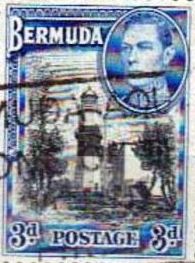
St. David's Lighthouse 3d postage stamp
July 1943. The Yankee Store, in the City of Hamilton, romanticized the Pembroke Marsh Canal by shooting a lovely colored photograph of it and published it as a postcard under the title "The Brook, Bermuda, No. 114." In this postcard, one of which is today in the Bermuda Archives Postcard Collection, the canal's shimmering blue waters reflect the spire of the Cathedral and are bordered by flowering shrubs. Considering the the infamous Pembroke Dump next to it today, this 1943 photo of the canal is a gorgeous representation of a serene, pastoral Bermuda during a time of war.
1943. July 30. The ship Constellation sank off Bermuda. She was a wooden hulled vessel with four masts originally built in 1918 and measuring 192 feet in length. (Later, Peter Benchley based his novel The Deep around her). She was a wooden hulled vessel with four masts originally built in 1918 and measuring 192 feet in length. She was originally the Sally Persis Noyes but when sold, was renamed. She was rebuilt and provided with modern comforts, including electricity, refrigeration, plumbing, a modern galley and large staterooms. She found her way to New York. When World War II began for the USA in December 1941, with the subsequent demand for ships of any kind, then owned by Intercontinental S.S. Company, she was converted back into a cargo vessel. While en route from New York to Venezuela, carrying a general cargo of building materials, medicinal drugs and 700 cases of Scotch whiskey, her steam pumping gear broke down, and she took on water from the increasingly rough weather. The crew used hand pumps for several days but could not keep up with the leaking vessel. Captain Howard Neaves, then 71 years old, headed toward Bermuda for repairs but while waiting for a local pilot she was driven by the strong current when her hull was broken apart on the reef.1943. August. Appointed the previous week as new Governor and Commander in Chief of Bermuda was David George Brownlow Cecil, Lord Burghley, 6th Marquis of Exeter. Young (38), straw-haired, a scion of the house of Cecil, which has furnished Britain with some of its most distinguished statesmen and soldiers. His father was the earlier Marquis of Exeter; from him it was expected that some day Lord Burghley would inherit enormous estates in Northamptonshire and Rutlandshire. His wife was a sister of the Duchess of Gloucester. He was a former Conservative Member of Parliament and a former British Olympian who competed in the 1924, 1928 and the 1932 Olympics where he won a silver medal in the 4x400 metre relay. His life story as an athlete was depicted in the epic 1981 film, Chariots of Fire, which won four Academy Awards, in which the character Lord Andrew Lindsay was based on the life of this Lord Burghley.
1943 August. Seabees at US Naval Operating Base Bermuda from 1943. See https://www.history.navy.mil/content/dam/museums/Seabee/Cruisebooks/wwiicruisebooks/cbmu-cruisebooks/540%20CBMU%201947.pdf.
1943. August 20. HMS Indomitable arrived in Bermuda en route to the USA, escorted by Royal Navy destroyers HMS Obdurate, HMS Obedient and HMS Opportune.
1943. September. A Norwegian ship was blown onto a Bermuda reef, with her cargo unloaded and put uf for auction in Hamilton.
1943. HMS Bermuda, commissioned in 1942, launched a Supermarine Walrus from her catapult. The aircraft was from the same company that built the Spitfire.

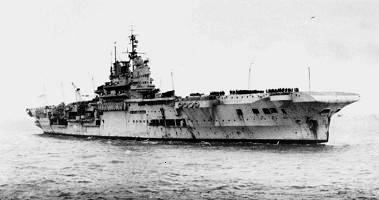
HMS Indomitable
1943. Mid October. The USA's 31st Battalion, which had served continuously on Bermuda for nearly two years, was returned to the mainland after being replaced by CBMU 540, which was followed by the CBMU 551 on December 11, 1943, to replace the 41st Battalion; the two maintenance units were then merged into one unit and designated CBMU 540.
1943. October. Bermudian James Standley Whitecross, who had joined the RAF in November 1940 was killed when flying over Germany.
1943. A new church school, the Bermuda Institute, began, under the vision of the Southampton Seventh-day Adventist church at their Jews Bay location. It then had an enrolment of twenty-six students and one teacher.
1940s. Many new plant species were introduced to Bermuda.
1944. The prolonged and frustrating struggle to secure the vote for women ended when the Women’s Suffrage Act, earlier the Women's Suffrage Bill 1944, was piloted through the Bermuda Legislature by Henry Tucker (later Sir Henry Tucker), was passed, giving all qualified female property-owners the right to vote and to run as candidates in general elections. In addition, the new law allowed them to cast ballots and vie for the offices of Mayor, Aldermen and Common Councillors in the municipalities of Hamilton and St. George’s and for positions on the parish vestries. What women had done in Bermuda in contribution to the war effort was the major factor. They assumed a significant share of public responsibility and deserved to be treated as equals at last in voting. The extension of the franchise to women notwithstanding, the increased number of voters on the electoral role amounted to less than three thousand. The first women to vote did so at a by-election in Paget later that year, on October 4.
1944. The Bermuda Workers’ Association, under the leadership of Dr. E. F. Gordon was formed. The association fought for trade union rights and was committed to the removal of segregation and the adoption of universal adult suffrage.
1944. February 5. US Navy convoy CK-1, having departed Charleston on January 20, 1944 with six Army Transport Ships, eleven small oil tankers and six tugs, escorted by Raven/Auk Class minesweepers, USS Owl, Kewaydin, Swerve, Threat and Tide, and three sub-chasers, PC-484, PC-1176 and PC-1261, having just made a brief stop at Bermuda, and was proceeding in heavy weather, when LT-23 had engine trouble and was told by the Commodore: ‘You will have to return to Bermuda unescorted … a Navy Tug from Bermuda will meet you in a couple of days.’ Heading again for Bermuda, the main engine broke down, followed by the auxiliary, which ran the bilge pumps, so LT-23 began to take on water. Spotted by a plane out of NOB Bermuda, the unit received the message a number of times by blinker: ‘How long can you stay afloat? ‘Until we sink!’ was the reply. The engines were restarted and shortly thereafter, the tug USS Cherokee arrived to escort LT-23 to Bermuda, where she went into drydock at HM Dockyard, Bermuda
1944. April 6. At the US Naval Base, Bermuda, Governor and wife, Vice Admiral Sir Alan T. B. Curtis, Royal Navy, and his officers attended the ceremony at which US Secretary of the Navy Frank Knox hailed the third anniversary of the founding of the base and spoke at the event. Also there were Lord Burghley, Governor of Bermuda (see photos below) Brigadier General Alden G. Strong, US Army, Commanding Officer of American troops in Bermuda; Rear Admiral Ingram C. Sowell, USN, Commanding Officer of the US NOB; Right Reverend A. H. Browne, Bishop of Bermuda.

Governor of Bermuda and wife salute

Royal Navy salute

Admiral Sowell, Secretary of the Navy Frank Knox and commanding officer-elect of the US Naval Base

US Army and US Navy officers saluting
1944. Bermudians Allan (Smokey) Wingood and Hugh Watlington, both Flight Lieutenants in the Royal Air Force, went to Buckingham Palace in London to receive the Distinguished Flying Cross and Distinguished Flying Medal respectively, for bravery in battle, from King George VI. They were flying Wellington bombers. They were accompanied by Mrs. Peggy Wingood, wife of Allan Wingood, and their baby daughter Katherine.
1944. Dr. E. F. Gordon, originally from Trinidad but by then a Bermudian, became President of the BWA.
1944. The Parliamentary Committee on Emigration issued a report noting that due to over-population, Government should look for places where Bermudians could emigrate.
1944. April. The Bermuda Contingent of the 1st Battalion Caribbean Regiment (Overseas Contingent) left Bermuda for the battlefields of Europe, via the USA. They were 100 volunteers from the Bermuda Militia Artillery (BMA) and Bermuda Militia Infantry, under the command of white officers Major Fuller and Bermudians Lieutenant Stuart Outerbridge and Lieutenant Robert Card.
1944. April 21. Bermuda's House of Parliament enacted the women's right to vote.
1944. April 24. The Dutch tugboat Roode Zee that had made many friends in Bermuda when stationed here from July 1942 when she arrived from the UK and was based in Bermuda until earlier in April this year was torpedoed by a German E boat S-100 off the coast of Dungeness, Kent in the English channel and sank with the loss of her entire crew. She had arrived in Bermuda via the Admiralty to assist in war-time rescue, direction-finding and ship-steering operation. Before she was attacked with a torpedo hitting her bunker where the fuel was located she had been towing a British Admiralty Phoenix caisson for parking at Selsey.

Dutch tug Roode Zee. Royal Navy 1942 photo
1944. May 1. Americans took over censorship of mail passing through Bermuda, and most of the censors returned to the United Kingdom. Around 60 chose to remain in Bermuda. During the time here the Bermuda censors helped to catch over 40 German spies operating out of the United States.
1944. May 1. Bermuda Mystery movie released in USA. Directed by Benjamin Stoloff; written by John Larkin (story), Scott Darling (screenplay). Cast were Preston Foster; Ann Rutherford; Charles Butterworth; Helene Reynolds; Jean Howard; Richard Lane; Roland Drew; John Eldredge; Theodore von Eltz; Pierre Watkin; Jason Robards Sr.; Kane Richmond; Emmett Vogan; Edward Keane; Chester Clute. It did not launch to rave reviews, in fact a contemporary press report called it a “thoroughly mediocre film.” The plot began with Connie Martin, played by Ann Rutherford, being convinced that her beloved uncle, who lived in Bermuda, was murdered; he died shortly after he had received a gift of expensive cigarettes, which she suspects were poisoned. The authorities in Bermuda declared that the man died of natural causes, prompting Connie to travel to New York City in order to dig deeper into the circumstance surrounding his death. It’s there that she finds out her uncle had been part of a pact made by six World War I veterans. They each had put up $10,000 to invest, and decided that at the end of 10 years, those who are alive would share in the proceeds, providing a clear motive for the murder of her uncle. Connie responded to this information by hiring a slick private detective in the hope of proving that one of the six veterans was responsible for her uncle’s death. A New York Times review published on May 13, 1944 said, “The only mystery about ‘Bermuda Mystery,’ which came to the Rialto yesterday, is why do they call it “Bermuda Mystery” when everything happens in New York?” Although Bermuda Mystery appears to have been a less than iconic production, actress Ann Rutherford tasted silver screen success when she appeared in the classic Gone with the Wind, playing the role of Scarlett O’Hara’s younger sister, Carreen. Gone With The Wind was an American historical romance film adapted from Margaret Mitchell’s Pulitzer Prize-winning 1936 novel and produced by David O. Selznick.
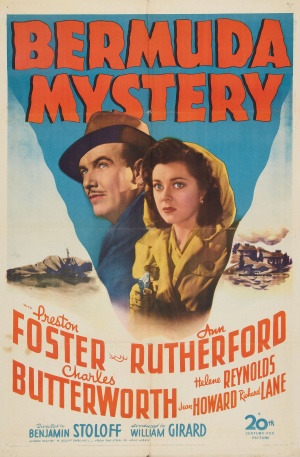
1944. The Bermuda Militia force, composed of members of the BMA (Bermuda Militia Artillery) and the BMI (Bermuda Militia Infantry), trained with the BVRC contingent as an infantry force at Prospect Camp. The BVRC contingent was then sent to the Lincolns. The Bermuda Militia contingent, however, proceeded to North Carolina, where it formed the training cadre of a new regiment, the Caribbean Regiment, being formed on a US Army base in North Carolina. Contingents, mostly of new recruits, were sent from various West Indian territories. In North Carolina, they were assessed for fitness, then trained as infantry. The unit was then posted to Italy in 1944. After serving briefly in the field, the Regiment escorted a shipment of Axis prisoners to Egypt, then remained there as prisoner-of-war (POW) camp guards until the end of hostilities. (The Caribbean Regiment was disbanded after the war, and the Bermuda Militia contingent members returned to their original units in Bermuda).
1944, June 1. An Armed Forces Radio Station, which used the call sign WXLQ, transmitting on the 1240 kcs medium wave band frequency, went on the air from Kindley, for a two-year stint. At the same time and as a consequence, the Bermuda Government station, which had operated from a studio in the Walker Arcade in Hamilton since the war started in September, 1939, finally went off the air.
1944. June 4, 1110 hours, off the coast of West Africa, the USS Chatelain reported a sonar contact, the submerged German U-boat U-505.. The accompanying US Navy Task Group jumped into action. The USS Guadalcanal could not attack without damaging itself so Captain Gallery moved the ship quickly out of harm's way. Supported by the Destroyer Escorts USS Pillsbury and USS Jenks, the USS Chatelain swiftly attacked. As the sonar crew maintained contact with the submerged U-505, the USS Chatelain attacked with a salvo of 24 hedgehogs that missed. While the USS Chatelain opened the range to turn and make another attack, two fighter planes from the USS Guadalcanal fired their guns into the water to help mark the location of the submerged U-505. The USS Chatelain then fired a pattern of 14 depth charges forcing U-505 to the surface. It was the opening saga in a major event that was soon to impact on Bermuda. U-505 was a Type IXC/40 submarine, one of 54 of this type that got put into operation, a long-range warhorse of the German Navy that could operate in the Caribbean or Atlantic or Indian oceans without refueling. She went into service in 1941, with a range of 13,000 nautical miles. She was captured off western Africa, towed to Bermuda and hidden, with no news of its capture until the end of the war in Europe on May 7, 1945.
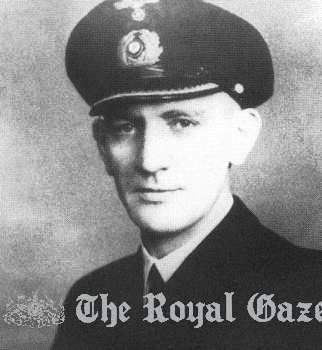
U boat commander Harold Lange
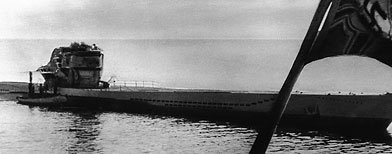
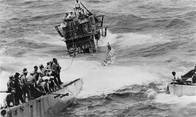
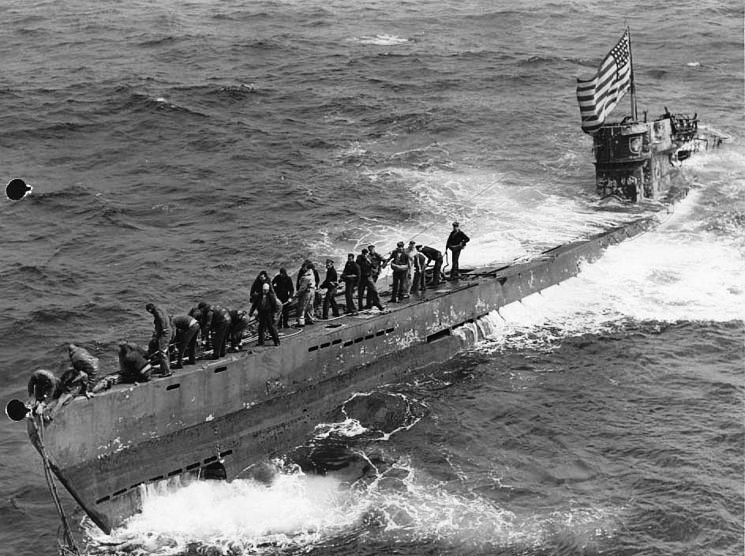
She was one of the U-boats which had departed from a massive concrete submarine pen at an occupied French port. Her target was the southeast Caribbean, where most of the fuel supplies for the Allies was shipped from Venezuela, Trinidad and Curaēao. She was built at the yards of Deutche Werft AG in Hamburg. Commanded by Oberleutnant Harald Lange, she was commissioned in August 1941. She was on her 12th patrol, having sunk eight vessels over those voyages. In February 1944, Lange took the boat south to the sea lanes off southwest Africa to prey on supply vessels bound for Europe with supplies such as iron ore. On this day she was intercepted by TF 22.3 under the command of Captain Daniel Gallery, USN and was depth-charged. Lange brought the damaged boat to the surface to save his men and thus surrendered, actions for which he was for a time after the war ostracized at Hamburg, although they had taken all standard procedures to scuttle the boat. Captain Gallery, USN, of Task Force 22.3 managed to get a boarding crew (see third photo below) onto the U-505 before it could sink and they saved the boat intact. Once the Germans had abandoned the U-505, Task Group 22.3 dropped whaleboats into the water with crews trained in boarding and salvage procedures. Some of the crews rescued the surviving German sailors from the sea. One whaleboat from the USS Pillsbury pulled up alongside the damaged sub. The crew's mission was to board the U-boat, overpower any remaining German sailors and take control of the submarine. It was an incredibly dangerous operation. The U-boat was going in circles, she was flooding with seawater and was most likely rigged with explosive charges intended to prevent her capture. It was the first time since 1815 that the US Navy had captured an enemy vessel at sea and was both the first and only submarine captured but not sunk by the US Navy
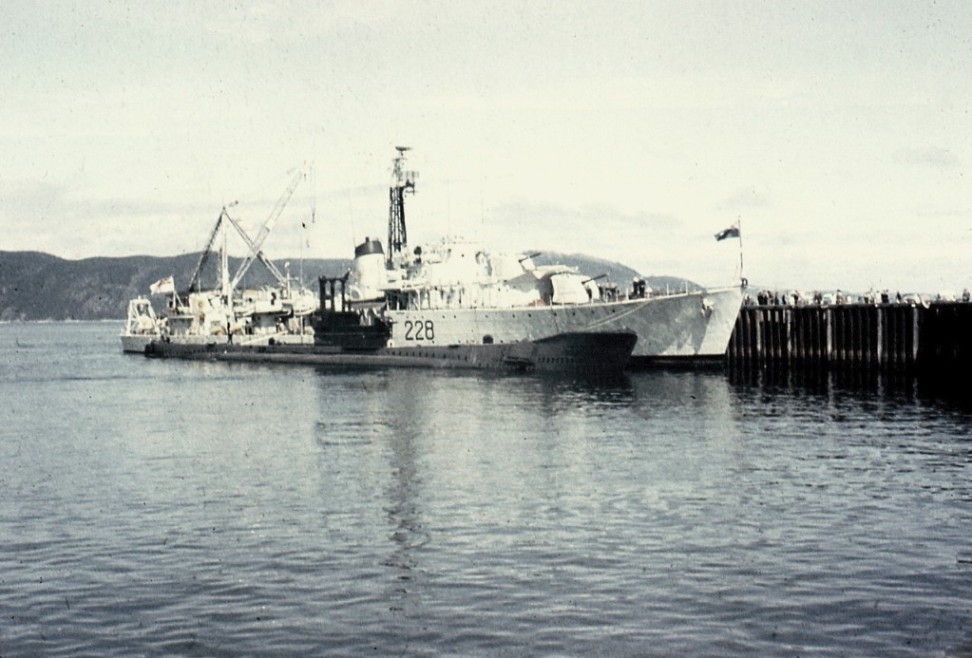
The men of TF 22.3 were sworn in writing to secrecy and the boat was towed across the Atlantic by USS Abnaki to the US Naval Operating Base at Bermuda, accompanied by the ships of TF 22.3, USS Guadalcanal, Chatelain, Pillsbury and Pope.
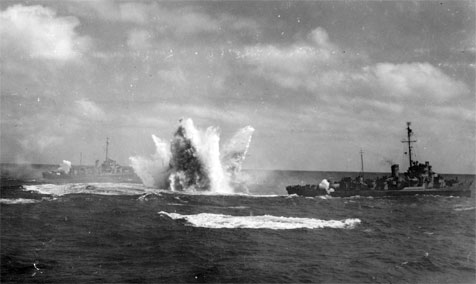

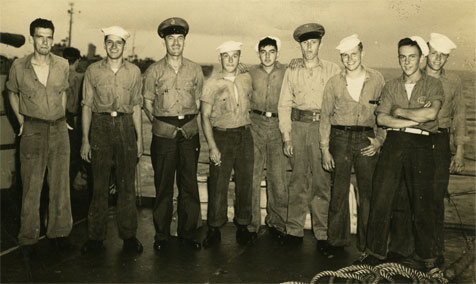
In bottom photo the Nine-Member US Navy Boarding Party who towed U505 to Bermuda were Albert L. David, Lieutenant, Junior Grade; Chester A. Mocarski, Gunner's Mate, First Class; Wayne M. Pickels, Boatswain's Mate, Second Class; Arthur W. Knispel, Torpedoman, Third Class; George W. Jacobson, Chief Motor Machinist's Mate; Zenon B. Lukosius, Motor Machinist's Mate, First Class; William R. Riendeau, Electrician's Mate, Third Class; Stanley E. Wdowiak, Radioman, Third Class; Gordon F. Hohne, Signalman, Third Class.
Capture of U-505. US Navy photos
1944. June 19. Arrival in Bermuda (until May 20, 1945) of the captured German submarine (unterseeboot) U-505 and crew, held incommunicado until the end of the 1939-45 world war. The U-505 was wrapped in canvas, wedged between moored vessels at the US Naval Operating Base until the end of the war in mid-1945. She was destined to become one of the most famous submarines of the war, not only for its capture with secret code books and machines intact. She stayed in Bermuda for eleven months incommunicado and undetected until she left for the Philadelphia Navy Yard on May 20, 1945. Her crew, minus her captain, Lange, had left for POW camps in the United States in the autumn of 1944. Some of the crew who arrived in Bermuda on June 19, 1944 and stayed until their transfer to a POW camp in the USA are shown in the US Navy photo below.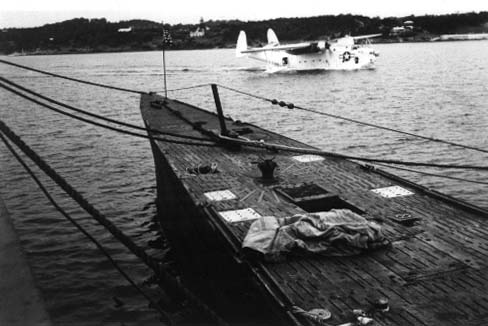
U-505 in Bermuda
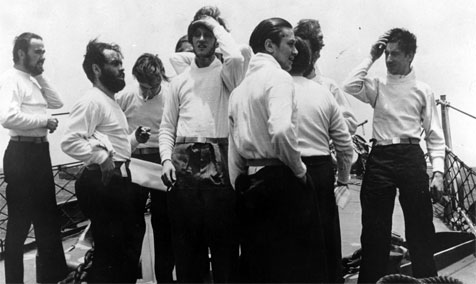
Some of the captured U-505 German Navy crew. US Navy photo
Only one German sailor died. The 58 who survived and were transported to Bermuda as US prisoners-of-war included Oberleutnant, later Kapitan, Lange who had been taken from the water unconscious and severely injured. At the US military hospital then recently erected in Bermuda, one of his legs had to be amputated, so he remained here longer, until repatriated at the end of the war. While in Bermuda, Lange was cared for by a young nurse of the Jones family of 'Inwood', Shirley, the late wife of Lt. James Humphreys, USNR, of Paget. She related that Lange's major worry was that his wife would remarry in his absence, since it would have been assumed in Germany that the U-505 had been lost with all hands. He also became friendly with Catherine (Kate) Perinchief who lived at Somerset Bridge and is known to have visited him during his Bermuda confinement. Lange himself did not believe that his boat had survived the scuttling attempt until Captain Gallery showed him family articles from his cabin. The U-505 was taken to Chicago in 1954 and forms a major exhibit and war memorial at the Museum of Science and Industry. In the company of Rear Admiral Gallery, Harald Lange toured his last command in a meeting of friends in 1964. One member of the crew of the U-505 moved to Chicago and for several decades until his death was an intimate tour guide for the submarine. An outside display for many years, the U-505 has since been moved into a purpose-built building to ensure its survival into the future as the only Unterseeboot to survive the war above water.1944. June 21. Founding of the Bermuda Workers Association, later the Bermuda Industrial Union.
1944. First publication of the Bermuda Historical Quarterly magazine. Published and printed were Volumes 1-38, each with 4 editions. It continued until 1981. Today, they can be found at the Bermuda Historical Society in Hamilton and at the Reference Department of the Bermuda National Library.
1944. 10 July. Bermudian Flying Officer John Hartley Watlington, Jr, Royal Canadian Air Force, previously declared in the Toronto Globe and Mail and in Bermuda as missing and presumed dead after his Mustang fighter AG 641 of 400 Squadron RCAF was shot down near Dieppe on 22 June 1943, finally arrived back home in Bermuda. It took him more than a year to escape from France and return home. He authored an account of his adventures published in the Bermuda Historical Quarterly in 1949.
1944. July. The Bermuda Contingent of the 1st Battalion Caribbean Regiment (Overseas Contingent), having previously been routed to the USA for onward transport to the battlefields of Europe, left the USA for Italy. There, the men trained for action in the shadow of Mount Vesuvius. (It was there that the contingent suffered its first casualty, Private Winston Baxter, buried at Pompeii).
1944. August. The Royal Canadian Navy established a small training base at Convicts Bay, St George's, which was commissioned HMCS Somers Isles (eventually decommissioned in October 1945 but not before 125 RCN and 12 RN escorts passed through before going to the war.
1944. August. The small Royal Navy Air Station at Boaz Island in Sandys Parish was closed, mostly due to the significant presence in Bermuda of both the US Army Air Force and aircraft of the US Navy following the opening of their Bermuda bases. It was built in 1939.
1944. 17 August. The US Navy's Indicative, a steel-hulled minesweeper built in 1943 in Savannah, Georgia, arrived at the US Naval Base in Bermuda for anti-submarine exercises off Bermuda. She then began regular duties as a convoy escort vessel between US ports and Bermuda, helping to counter the German submarine menace in the western Atlantic
1944. Late August. Bermudian Fowle Alison William Bluck, a member of the Bermuda Volunteer Rifle Corps attached to the Lincolnshire Regiment, died at Calvados, France, as his unit was fighting to access Germany.
1944. Bermuda saw Juniperus bermudiana, the Bermuda cedar, start to die at an alarming rate due to two species of insect. The oyster-shell scale found in the East End and the juniper scale found in Paget had been introduced accidentally in 1943, and cedars were dying throughout the island. (The Bermuda Cedar Blight would claim more than three million trees, and by 1971, 99 percent of cedars had been eradicated by the invasive species).
1944. Black Bermudians purchased the Brunswick Hotel in Hamilton for blacks. Other blacks began opening restaurants and small guesthouses and driving taxis. Other blacks like the Talbot Brothers and Sidney Bean enjoyed success as entertainers by selling black culture to white visitors.
1944. September 4. Bermudian soldier Winston C. Baxter, while on active service, died in Italy and was buried at Pompeii. He had volunteered for and was serving in the Bermuda Militia Infantry.
1944. September 22. Military parade held in Hamilton and US NOB Southampton for visit of Admiral Royal Eason Ingersoll, Commander in Chief, US Atlantic Fleet and other US Admirals. Also present were senior Royal Navy, Royal Canadian Navy and British Army officers and US Army and US Navy officials. British Army-provided photos below show Brigadier General Jones, commander of US Army forces in Bermuda, one of the VIP military guests. During his visit the Admiral inspected also inspected the 3.5 year old US Navy NOB Bermuda. Other photos show British Army's guard of honour outside the Cenotaph in Hamilton and the separately, the three US Admirals who were (from left to right) Admiral Ingersoll, Rear Admiral Walter K. Kilpatrick and Rear Admiral I. C. Sowell.



1944. October. The 1st Battalion Caribbean Regiment, including its Bermuda Contingent, went from Italy for Egypt, guarding German prisoners-of-war, on the then-troopship Queen of Bermuda and another ship the Ormond. They spent 14 months in Egypt.
1944. Early October. Bermudian Warren James Harris, a member of the Bermuda Volunteer Rifle Corps attached to the Lincolnshire Regiment, was killed in The Netherlands.
1944. October 14. At Overloon, Holland, four Bermudian soldiers of the Bermuda Volunteer Rifle Corps fighting with the Lincolnshire Regiment were lost to enemy fire: John DeSilva, Richard Martin White, Major Anthony Frith (Toby) Smith and Willard Patterson. Major Smith was one of 12 children, five of whom saw active military duties in two world wars. He and the entire first contingent of soldiers of the BVRC and Bermuda Militia Artillery (BMA), survived a U-boat attack in July 1940 and spent several years in the United Kingdom before finally seeing active combat. Meanwhile, his family struggled to make ends meet during the war from their home in the United States and then in Bermuda.
1944. November 12. Bermudian Jay Circott Stephenson, Bermuda Volunteer Rifle Corps, attached to the Lincolnshire Regiment, died after being wounded by the enemy. He sought shelter in a barn in Holland, which the Germans set fire. His tags and a picture of his girlfriend identified him.
1944. November 13. Direct taxation for Bermuda was the subject a major debate in the House of Assembly. The establishment of an income tax department was moved by Henry P. Vesey as chairman of the Finance Committee. He pointed out that customs duties were exceedingly high and had a direct impact on the cost of living. He suggested relief in this area by imposing, in the place of customs duties, a form of income tax to spread the burden of taxation more evenly. The motion was defeated. Also thrown out were land tax and inheritance tax. Both Mr. Vesey and Mr. Eldon H. Trimingham, as Deputy chairman of the Finance Committee, submitted their resignations from the latter, as they had submitted their recommendations on a matter of principle and had the courage to believe it was the right thing to do.
1944. December 28. Death of A, K. Carnohan, Company Quartermaster Sergeant, Bermuda Volunteer Rifle Corps. He was buried at Prospect Military Cemetery. grave 44.
1944. December. Mr Arthur St. George Tucker, of Nonsuch Island, was awarded the MBE for his work at the Nonsuch Training School. He was presented with his insignia by the then acting Governor the Hon. W. E. Murphy.
1945. January. An American Army Hospital ship got stuck in the reefs off Bermuda.
1945. Howard Academy began in Bermuda as a place for secondary education for black children.
1945. March 1. Bermudian Scott, Frank, Flying Officer, J/43783, Royal Canadian Air Force, was killed in action. The Wellington bomber in which he was serving crashed into the village of Norton, near Evesham, Worcestershire, England, shortly after taking off from nearby Honeybourne, bound for Germany. He was buried in Norton. He was the son of Arthur Havelock and Rena Scott, Tucker's Town.
1945. March. Royal Air Force serviceman Philip Lamb of Bermuda, an aircraftsman from St David's, a black Bermudian initially with the Bermuda Militia Artillery before volunteering for the RAF and arriving in England in 1944, was injured in England in one of the last air raids the Germans made on England. He received leg injuries when bombs hit a building in which he was he was attending inside.
1945. March. Bermudians Edward Eugene Hennessay and Francis Walter Monkman, both with the Bermuda Volunteer Rifle Corps attached to the Lincolnshire Regiment. lost were killed in battle at Winnekendonk, Germany.
1945. April 15. When British troops of the 11th Armored Division, who included a number of Bermudians who had volunteered for overseas service during this Second World War and were serving with the Lincolnshires, entered the fairy tale town of Celle in Lower Saxony, Germany, they found themselves on the threshold of hell. Outside Celle the British troops were confronted by unprecedented scenes of man’s inhumanity to man, writ large and in the blood of innocents. Just a few miles beyond the town’s half-timbered houses, cobblestone streets and centuries-old chestnut trees, Germany’s Nazi dictatorship had built the Bergen-Belsen concentration camp complex. The troops who liberated Bergen-Belsen that day found themselves face to face with mountainous jackstraw heaps of emaciated corpses, diseased survivors who envied the dead and the ruins of a diabolical philosophy predicated on the perverse notion that mass human sacrifice could renew and purify Germany. Bergen-Belsen and its five satellite camps instantly became synonymous with and emblematic of the Nazi policy of exterminating Untermensch — those deemed to be “undermen” or subhumans by the state. There were no gas chambers at Bergen-Belsen or any of the other ghastly apparatus of mechanized slaughter which the Nazis installed at other camps. The inmates at Bergen-Belsen were literally worked to death as slave laborers or died of disease — typhus was rampant — or simply succumbed to the active neglect of their captors. Tens of thousands of Jews, Czechs, Poles, anti-Nazi Christian activists and others died there in the two years Bergen-Belsen was in operation as a concentration camp. Among the casualties was Anne Frank, the young Dutch Jewish diarist. Her first-hand account of life in hiding from the Nazis was later published and remains a timeless gift to the world, one which demonstrates that hope, humor and compassion are still capable of illuminating the human condition even during history’s darkest hours. She is thought to have died just a few weeks before the British entered Bergen-Belsen. One of the Bermudians who took part in the liberation of Bergen-Belsen reflected on his life-changing experiences at the camp complex in a letter he wrote late in life to his son. An eyewitness to the seemingly boundless limits of human cruelty, mass violence and state-sanctioned bigotry, he said: “I discovered when I was at the camps that Evil is not simply a religious conceit; it is a real and palpable force in this world. But I also learned that Kindness, Decency and Tolerance are equally real — and act as powerful countervailing forces to Evil. I’m sorry if this sounds a bit like Dale Carnegie, one of those ‘If life hands you a lemon ...’ banalities. But if I didn’t believe this to be so, I doubt I could believe in anything ever again.”
1945. April. Bermudian George Fisher, who had gone to Europe with the First Contingent Bermuda Volunteer Rifle Corps on HMS Mataroa, and trained as a paratrooper but was badly injured at Arnhem and taken prisoner, was liberated from a POW camp by the US Army.
1945. Late April. Bermudian Harry Reginald, Frost Bermuda Volunteer Rifle Corps attached to the Lincolnshire Regiment, was killed in Germany.
1945. May 2. Death in Germany from war wounds of Bermudian Williams, Granville Barton. Unlike all other Bermudians, he served in the US Army. Earlier, he had received the Bronze Star, Silver Star and Purple Heart, for valor. (Pictured below).
1945. May 2. Death in Germany from war wounds of Bermudian Granville Barton Williams. Unlike all other Bermudians, he served in the US Army. Earlier, he had received the Bronze Star, Silver Star and Purple Heart, for valor. (Pictured below).
1945. May. Bermudian Frederick Gerald David Hughes, US Army Air Force, died in an accident.
1945. May 12. The marriage, in Bermuda, at the age of 23, of Mary Sylvia Dorothy Johnson and Wing Commander E. M. (Moe) Ware, Royal Air Force (RAF), B. Sc (Eng), DFC, OBE, then seconded by the RAF as Air Advisor to the Bermuda Government. He was later responsible for the negotiation and design of the first Civil Air Terminal, subsequently becoming the first Director of Civil Aviation. He predeceased her in March 2003. Sylvia (''"Rosebud''¯) was born on 6 November 1921 in Quetta (formerly India) to Major Bernard Thomas Johnson and Mrs. Janet (Ginny) Johnson (nee Stein Campbell /Sharp). She moved to Bermuda as a child with her parents, who took up a posting in Bermuda, and lived at Avocado Lodge, Corkscrew Hill. She was one of 7 children Thomas (Tom), James (Jim), Robert (died age 2 years in Ceylon), Betty (died age 14 years in Scotland), Audrey (veterinary surgeon, who married Stuart Peniston of Bermuda, together with whom she ran a practice in Orange Valley, Devonshire), Ian who was married to Elizabeth (deceased) formerly of Bermuda Harbour Radio. Sylvia attended the Bermuda High School for Girls, and married Ware. Sylvia was a keen participant of the Girl Guides, and during WWII worked as a Cipher Clerk and secretary at Admiralty House.
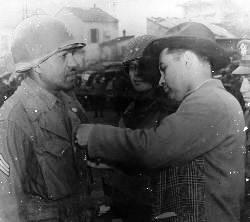
1945. May 24. After Germany surrendered unconditionally, World War 2 in Europe ended, to the joy of Bermudians and those elsewhere in the world. But it carried on for two more months in the Pacific.
1945. May 25. The United States Navy stationed in Bermuda celebrated the end of the war in Europe - VE Day for Victory in Europe with the unconditional surrender of Germany - with a march-past and parade in the City of Hamilton, as this photo shows. In the background of this Queen Street photo is the old Hamilton Hotel. Also celebrated was news that on this day US Navy aircraft based on aircraft carriers in the Pacific had fire-bombed Japan in a mass attack. But the world had to wait three more months for the Japanese to be repeatedly atom-bombed before it would surrender.
US Navy official photo of that parade
1945. June. After World War 2, the two aircraft Luscombe fleet of the former Bermuda Flying School became the basis for a short-lived flying club, with additional Luscombes being added.
1945. Edward Brennan, a stepbrother in Bermuda's Vallis family, died in action over Germany, having joined the RAF and later transferred to the American Army Air Force. He was awarded the USA's Air Medal, the Distinguished Flying Medal and posthumously, a Purple Heart.
1945. With the war having improved the economy in so many ways, the capital funds of both the Bank of Bermuda Ltd and Bank of N. T. Butterfield & Son Ltd were increased by 55%, in large part because of increasing liability to the public and protection of depositors. Reforms were enacted that achieved a doubling of the number of stockholders and with pension and benefit programs instituted for bank staff.
1945. August 6-9. The United States Army Air Force dropped atomic bombs on the Japanese cities of Hiroshima and Nagasaki to hasten the end of World War 2 in the Pacific. Thousands died in the explosions and after from radiation sickness and other injuries. But the atomic bombs succeeded in their purpose, to force the unconditional surrender two days later of the Japanese and end the war.
1945. August 16. Death in Bermuda at the age of only 31 of John Michael Hamer, Captain, Royal Army Medical Corps. He was buried at Prospect Military Cemetery, grave 547.
1945. BOAC began a post-war thrice weekly Bermuda-Baltimore service from Darrell's Island, with Boeing 314 long-range flying boats, one of the largest available passenger aircraft at that time. The first flight was by G-AGBZ RMA Bristol.
1945. Dr. E. F. Gordon, MCP, President of the Bermuda Workers Association, a Trinidadian doctor of medicine who had studied at Edinburgh University, qualified in Britain and then settled in Bermuda, hand-delivered a petition to the Secretary of State of the British Government for democracy for Bermuda's working class and mostly black population. In his petition he said: "When only 2.462 men and women can vote in a population of nearly 35,000 people, the dangers of oligarchical government is fully realized. Democracy is a mockery as far as Bermuda is concerned." He asked for a Royal Commission to investigate. In Bermuda, many members of the House of Assembly were outraged
1945. Founding of Bermuda Tuberculosis, Cancer & Health Association, to assist patients fighting TB.
1945. Elbow Beach Cycles was established. The shop started out renting push bikes, then 50cc motorbikes and then scooters.
1945. Elliott School # 1 became The Skinner School in Devonshire, Bermuda, under Mr. E. P. Skinner.
1945. October. Arrival back in Bermuda of Bermudian Captain Raymond Correira, United States Air Force after World War 2 duty overseas with the USAF. He was commissioned as a pilot on March 25, 1943 and was transferred to the 311th Fighter Group (D) at Waycross, Georgia, on April 5, 1943. In that summer his 311th Fighter Group received orders to report for duty at San Francisco, where they boarded a troop carrier, the USAT Brazil, destined for Bombay, India. In order to avoid Japanese submarines en route, the ship took 28 days to reach India. However, after the first two weeks, the ship ran out of a variety of foods and had to put into Hobart, Tasmania to take on provisions. At Bombay, the three squadrons were taken by bus to Karachi where their disassembled P-51 planes had been shipped. Built by North American Aviation (now part of Boeing), the P-51 was underpowered until a suggestion by the Royal Air Force that they be powered by the Rolls Royce Merlin engine transformed the P-51 into a major aviation attack weapon. Members of the unit flew to their base, Dinjan Airfield, located in northeastern India, to the west of the Naga Hills that separated India from Burma. Upon arrival, Raymond was assigned to the 10th Air Force (eventually changed to the 14th), 311th Fighter Group, 529th Fighter Squadron. He was stationed at Dinjan for one year. Missions were against enemy aircraft and to destroy ground targets, primarily in Japanese-held Burma. Raymond flew 70 combat missions during the twelve months from the summer of 1943 and was awarded the Air Medal (25 combat missions flown) and the Distinguished Flying Cross (50 combat missions flown) by the United States Army Air Force. In mid-1944, Lieut. Correia received orders to return to the United States. He eventually got there after temporary assignments, was first re-assigned to Waycross, Georgia where he trained fighter pilots, then to USAF bases in Florida and Louisiana to be trained to fly P-51Ds for service in Germany before going home to Bermuda where he became a member of the USAAF Reserves, promoted to Captain.
1945. During parliamentary debate on a Bill entitled the Parliamentary Election Act 1945, Dr. Eustace Cann moved an amendment to the draft legislation, which, if agreed to by both Houses of the Legislature, would have eliminated the property vote altogether and made universal adult suffrage a reality. Its rejection by the House of Assembly by an overwhelming margin of twenty-five to three revealed that the majority of the members were certainly not ready for any changes to the status quo. During debate on the same Bill, Dr. Cann also moved an amendment (which was defeated in the House of Assembly by twenty-six votes to five) to eliminate plural voting, a feature of the electoral system which entitled electors to cast ballots in any of the parishes where they owned property satisfying the voting criteria. This entitlement resulted in elections spanning a period of days to allow multiple landowners the time to cast their ballots at the various polling stations located throughout the island. The legislation, which was returned to the House of Assembly by the Legislative Council on a number of occasions with recommended amendments before finally being passed by both Houses, contained a number of interesting features. Following on the heels of the Women’s Suffrage Act passed in 1944, the new law included the following provision relating to joint tenancy of freehold estates - “For the purposes of this Act, persons who are joint tenants in respect of any freehold estate in land shall be deemed to be tenants in common in equal shares in respect of the freehold estate.” Another section of the Act stipulated that to be eligible to vote in a parish constituency, an elector had to be a British subject who owned a freehold estate in that parish, valued at the last assessment at sixty pounds or more. A different set of criteria applied to election candidates. In order to qualify as a candidate in any parish for a seat in the House of Assembly, a person had to registered as a Parliamentary elector, own a freehold estate valued at the last assessment at two hundred and forty pounds or more and, “unless a native of these islands”, must have resided “in these islands for a period of not less than five years.”
1945. August 15. A decision to end the Bermuda Railway was made by the Commission on Public Transport. Since it opened on October 31, 1931 it had never been profitable. In every year since then it had been unable to even break even. World War 2 usage had also been a financial disaster, with greatly increased mostly military traffic that had incurred severe structural defects on many bridges, trestles and sleepers from not being built to carry that kind of military weight with no maintenance. Depreciation of buildings and equipment was massive. The system was hugely in debt with investors having had no returns and more than £400,000 was owing in unpaid interest. made worse by the total absence of any civilian cars and trucks to take part of the load. Figures provided to the Commission revealed a stark reality of the huge liability.
1945. December 5. At Fort Lauderdale Naval Air Station, five airplanes of Flight 19 – a routine military training mission departed from Fort Lauderdale, Florida but vanished without a trace. The message picked up by the control tower was as bizarre as it was alarming. “Everything looks strange,” said the pilot. “It looks like we’re entering white water. We’re completely lost.” The Fort Lauderdale ground staff made frantic efforts to contact the lead pilot, Lieutenant Taylor, but their messages were not picked up. They eventually managed to triangulate Flight 19’s position and it was most alarming. The planes were north of the Bahamas, miles from land. There were a few more crackles and then silence. No wreckage was ever found, despite an extensive search, and nor were any bodies recovered. It was as if the planes and their 14 crewmen had simply disappeared into thin air. Within hours of the five Avenger planes disappearing from the radar, a PBM-Mariner seaplane was sent on a search-and-rescue mission. The Mariner’s pilot made a routine radio call at 7.30pm indicating his position. It was the last call he ever made. Soon afterwards, the Mariner also vanished from the radar, just as the five Avengers had done. Neither the plane, nor her 13-strong crew, was ever seen again. Thus began the infamous Bermuda Triangle, with its mystery and myth.
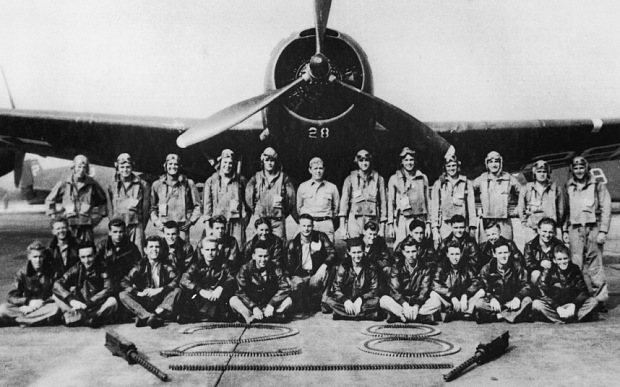
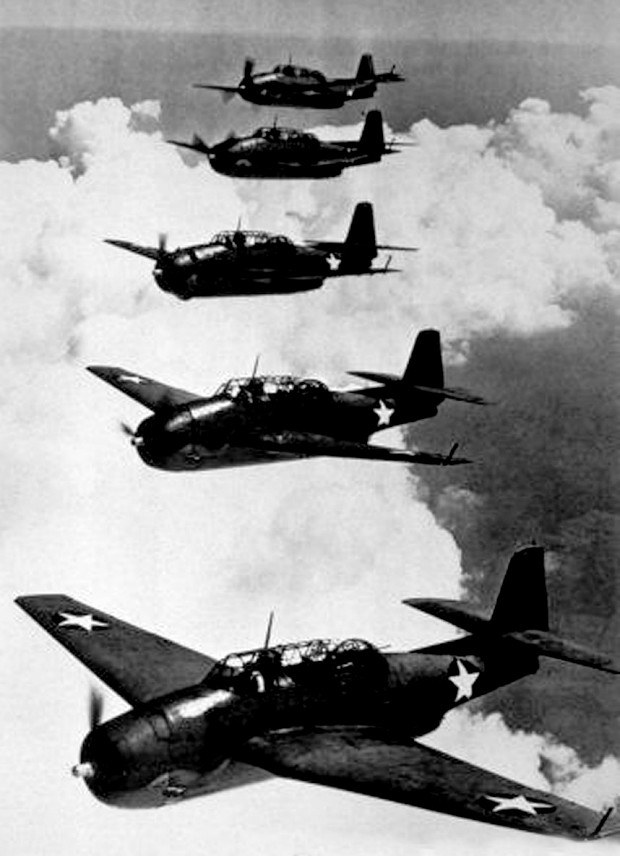
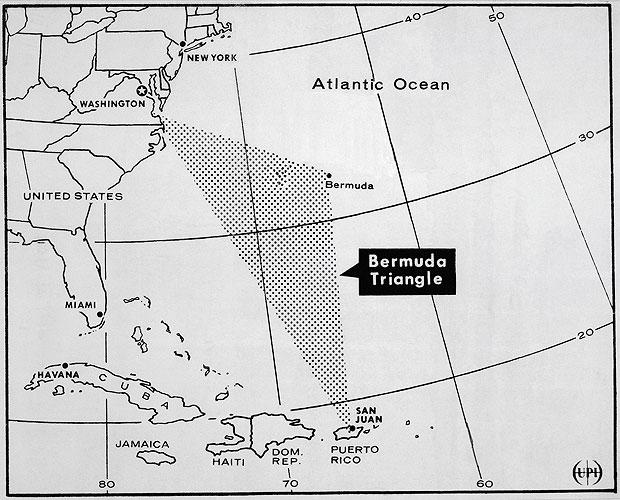
1946. 15th January. Bermuda
Air Agreement (Aviation), known as Bermuda I, began to be negotiated.
Delegates
from the United States and the United Kingdom met at Hamilton, Bermuda, to
resolve issues remaining from the 1944 Chicago meeting. Senior officials
of Britain's Ministry of Aviation and the United States Civil Aviation met to
agree on British and American airline routes across the Atlantic and into each
country's territories. It was a
27-day conference, to agree on British and American airline routes
across the Atlantic and into each country's territories. It was the first of
what became later several subsequent aviation agreements to which Bermuda lent
her name. The principal American delegate at that Bermuda Conference was
Fiorello LaGuardia, the energetic and colorful Mayor of New York, who had been
involved in several other important conferences relating to air travel held
previously; and had been a guest of the American
military base at Fort Bell/Kindley, at the VIP quarters. The
earlier Chicago meeting which had involved some 52 countries had been unable to
reach agreement on any but the most fundamental points at issue in post-war
international civil air transport. It had agreed the first two Freedoms of civil
air transport
It
was clear to aviation planners in both countries that there would be
considerable post-war development of civilian air traffic across the Atlantic.
Rapid wartime development of civil aircraft especially landplanes such as the
Douglas DC4 and DC6 the Boeing Stratocruiser and Lockheed Constellation meant
that future routes between the two countries would use runways, many developed
during the war as refueling points for USAAF Boeing Fortresses on delivery runs
to operational bases in England and North Africa. The new airliners could carry
substantially greater payloads than the flying boats, allowing for both more
passengers and greater fuel loads providing longer range. But no civil transport
aircraft at that time could fly the Atlantic without refueling.
The
American delegates were in favor of a very liberal regime under which several
airlines could provide as much capacity as they wished on each designated route,
charge what fares they considered commercially justified and operate with as
little government interference as possible. The British were conscious that the
US had a significant lead in the development of civil aircraft, that it already
had a substantial internal air travel market and that its airlines dominated
traffic within South America and between South and North America.
The
eventual agreement permitted each country to specify as many carriers as it
wished on a series of designated routes. In the event the British restricted
their allocation to BOAC whilst the Americans allowed three carriers to compete,
Pan American, American Export and Trans World. Fares were to be agreed by an
international body and there would be a procedure to investigate them if either
country thought that they were too low to be commercially viable.
Members of both the United States Senate and the House of Lords criticized the negotiators. Both sides were concerned that the other country would exploit the agreement to take internal traffic for example from New York to New Orleans or in the British case from London to India. So a clause was inserted that permitted only as much traffic to be carried between intermediate points as was justified by spare space on the aircraft. It was specifically forbidden to introduce a larger aircraft on a segment such as New York-Mexico City or London-Paris. In the event little such traffic was attracted and the fears proved groundless. As was to be expected American airlines won the lion's share of the Atlantic route, over the next few years. But gradually BOAC also was able to build this into its most profitable route, largely by using American aircraft.
1946. January. After 14 months in Egypt the Bermuda Contingent of the 1st Battalion Caribbean Regiment, including Privates John W. DeShield and Earl Darrell, arrived home in Bermuda. A great banquet was held for them, with the returning troops standing for a minute of silence for their lost comrade Winston C. Baxter, killed and buried in Italy in 1944 when they were posted there.1946. January. Kindley Field Airport, Bermuda, was opened. It was established on that part of the US military base once reserved for and used by Britain's Royal Air Force (RAF). The senior RAF officer in Bermuda during the War, Wing Commander E. M. "Mo" Ware, OBE, DFC, was loaned to the civil government to oversee the conversion of the RAF's and its Transport Command end of the military airfield into a Civil Air Terminal. Pre-fabricated buildings were relocated from Darrell's Island to assemble the first terminal. Ware remained with the local government after leaving the RAF, becoming the Director of Civil Aviation for many years. Although no longer maintaining any detachment in Bermuda, the RAF continued to use Island as a trans-Atlantic staging after WW2 While most foreign military aircraft passing through the Island had used the US military end of the airfield, the RAF continued to disperse its aircraft at the former RAF end of the field. Large detachments of tactical aircraft, accompanied by larger refueling, transport, and maritime patrol aircraft, regularly staged at the island on transits between the UK and the garrison at Belize, etc.
1946. January. First commercial flight by any airline to Kindley Field Airport, Bermuda by Pan Am. The Boeing Stratoliner S-307 "Flying Cloud" was built in 1940. She was the first to fly as high as 20,000 feet. Only 10 were built. She carried 5 crew and 33 passengers, later re-configured for 45 passengers at an average speed of 187 mph. After flying routes in Texas, California and Mexico for Pan Am, she was taken over from December 1941 by the US Army Air Force and put to work in South America. After WW2, she was returned to Pan Am which flew it on the New York to Bermuda run for a short time in January 1946 until she was sold. She was moth-balled at Tucson, Arizona, for years. It still survives, despite a crash-landing near Seattle in April 2002. She is now owned by the Smithsonian.
1946. January 26. The Bermuda Railway Company, at death's door as reported earlier, having petitioned the Bermuda Government to buy it out, was duly sold to the government for £115,000 with the creation of the Railway Purchase Act approved a day earlier. The government appointed Harold Kitchen, earlier the company's chief engineer, to head the new publicly owned company.
1946. February 11. At an
IATA Conference held in Bermuda, the original "Bermuda air
travel agreement", known as Bermuda I, debated since January, was
finally signed after neatly a month of negotiation. It took its name from this island where UK and US transport
officials met to negotiate a new, inter-governmental air services agreement
between Britain and the United States. That agreement, which was highly
restrictive at the insistence of the British negotiators who feared that
"giving in" to US demands for a "free-for-all" would
lead to the then financially and operationally superior US airlines' total
domination of the global air transport industry, was the world's first
bilateral air services agreement. It became a blueprint for all subsequent
air services agreements. It
established a precedent for the signing of approximately 3,000 other such
agreements between countries.
1946. February. The two surviving Lady Boats, Nelson and Rodney, both of which had been regular callers at Bermuda before and during WW2 until they had to cease after their sister ships were sunk by German U-boats, were assigned a new post-war task: bringing war brides and their children from Britain to Canada through Halifax’s Pier 21. These so-called Diaper Specials continued for about a year before the ships were extensively refitted and returned to their old West Indian routes.
1946. March. Prominent tourism advertisements about Bermuda began appearing in American magazines, following the announcements of flights to Bermuda.. “This is a dream beyond time, a dream in which this minute, this hour, this golden day, this magic night will endure forever. This is Bermuda, where dreams are even better”, said the advertisements. They promote the beauty of Bermuda, describing the island as having “coral sands”, “flower lined lanes,” “powdery pink sands”, “old world streets” and “magic scented evening air.” The ads — one of which notes that Bermuda is busy “reconverting from war,” presumably referring to WWII [1939 - 1945] — were produced by The Bermuda Trade Development Board, the appointed body that was the forerunner to the later Department of Tourism.
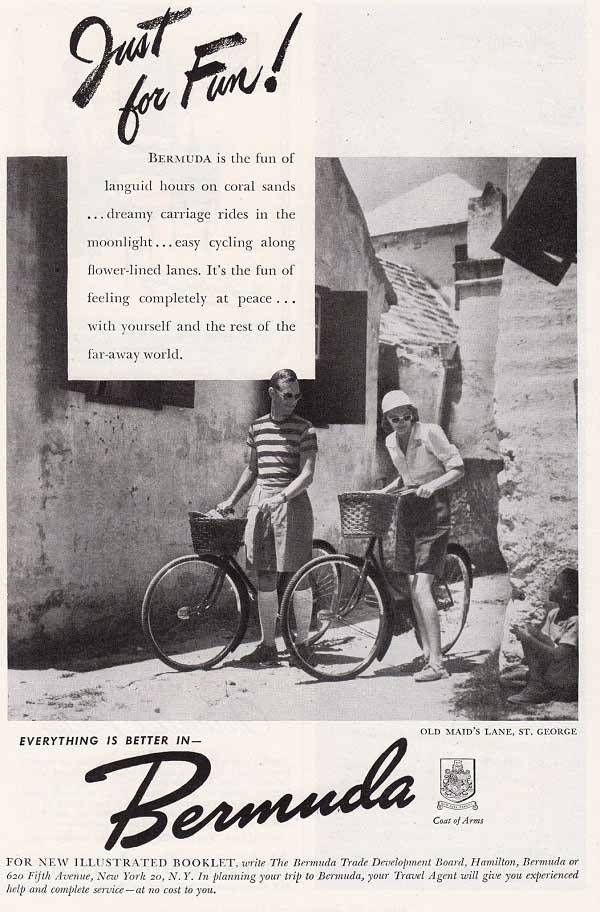
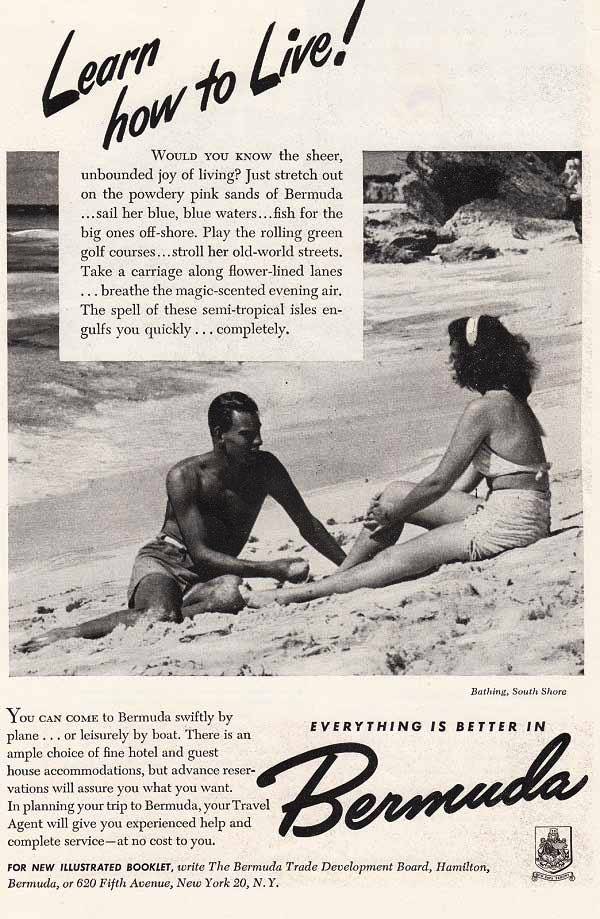
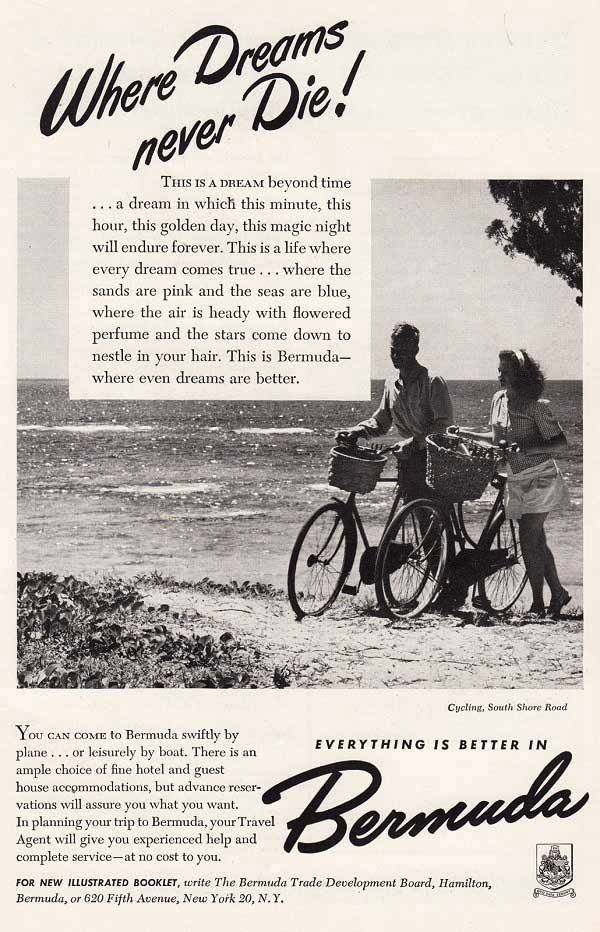
1946. March-April. British South American Airways Corporation (BSAAC), an airline
created by World War II veteran pilots in an effort to provide service into
the previously untapped South American trade and passenger routes, commenced
fortnightly transatlantic services with a BSAA plane making the first operational flight
from London Heathrow Airport to the Azores, Bermuda. Jamaica and Caracas. and beyond.
operated
mostly Avro aircraft: Yorks, Lancastrians and Tudors. The Avro Lancastrian
was a modified Lancaster bomber, an aircraft that had been used with devastating
effect on German cities during World War 2. Its gun turrets had been replaced by
streamlined metal fairings. This pioneering route paved the way for later daily
transatlantic flights.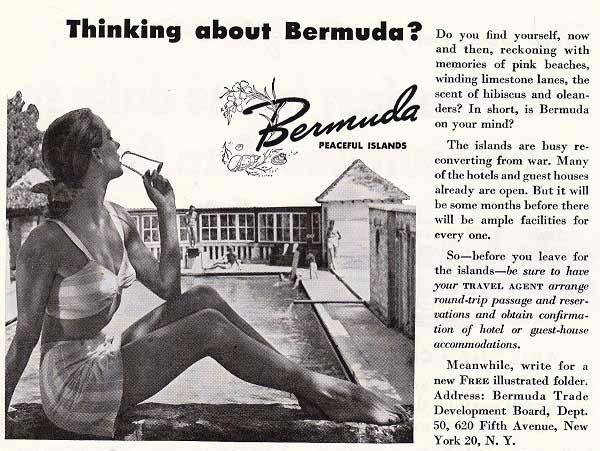
1946. April. The Piggly Wiggly grocery store in Bermuda was purchased from the Crisson family by the Pimental family and remained in their hands until 1950.
1946. April. The private Bermuda Railway company sold the entire operation to the Bermuda Government, at a huge loss.
1946. April. The Public Transportation Board (PTB) launched its first bus service on the island. The first six buses were 21-seater Model 773s from the Yellow Bus Company, purchased from New Jersey, USA. The original buses were left-hand drive, which meant passengers had to alight into traffic. They were green in color and collectively cost only $1,000.
1946. The Bermuda Militia Infantry (BMI), along with the Bermuda Volunteer Engineers (BVE), were disbanded.
1946. April. World War 2 veteran Thomas (Tommy) Aitchison returned home to Bermuda, after war service in the UK, Germany and Italy. Born in 1916 in Mount Kisco, New York and the son of long-standing Bermuda residents David and Jean Aitchison, he was among the first to sign up with the Bermuda Volunteer Rifle Corps. Travelling overseas in 1940, Mr Aitchison’s convoy came under submarine attack during the Atlantic crossing. He joined the Royal Lincolnshire Regiment, attaining the rank of sergeant, and transferred in 1942 to Black Watch Regiment his father’s county regiment where he honed his bagpiping skills with the bagpipes, and later saw military action in North Africa. Mr Aitchison was stationed in central Italy at the war’s end, where he was attached to one of the headquarter units of the Royal Army Service Corps.
1946. May 5. Bermudian Daisy Louise Vallis died, in a car crash in Colchester, Chittenden County, Vermont, USA. She was killed on her way to Canada to be demobbed. She was the daughter of Clive Valentine Selby and Edith Beatrice Vallis, of Devonshire, Bermuda. Born on May 17, 1917 and 28 years old at the time of her death she was a Leading Aircraftwoman of the Royal Canadian Air Force (Women's Division) and was one of the 29 Bermudian women who served overseas in the Second World War. She was buried in St. John's Churchyard, Pembroke. There is a Canadian War Memorial ID 43595540 in her honour.
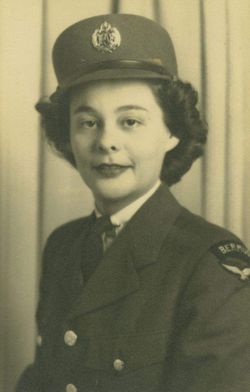
1946. May. Colonial Airlines (later, Eastern) commenced airline service to Bermuda. It was a direct result of the Bermuda Air Agreement negotiated in early 1946. It was originally known as Canadian Colonial Airlines until it was bought out by American interests. It was awarded the Washington, DC to Bermuda and New York to Bermuda routes in 1942 but did not fly that early. It flew DC-4 aircraft. Much later, the airline merged with and became part of Eastern Airlines.
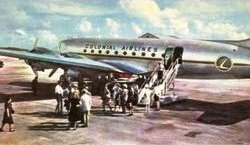

1946. May 15. A British Admiralty vessel sailed from Alexandria, Egypt to Bermuda, in the company of tugs Warden and Reward, towing Admiralty Floating Dock AFD 5. In the dock, many of the world's most famous warships recovered from war wounds during World War 2. The journey to Bermuda was via Gibraltar and the transfer was part of the British Forces evacuation from post-war Egypt.
1946. May. ZBM Radio began broadcasting in Bermuda, 26 years after birth of radio broadcasting in Pittsburgh, PA in 1920 and 16 years of the first-ever commercial radio station in Bermuda in 1930 by Thomas Wadson. It was Bermuda's second commercial radio station. It was owned by the Bermuda Broadcasting Company Ltd. (Z of ZBM is pronounced the English way). It broadcast at 1235 kHz on the AM band.
1946. June 8. To commemorate the 1939-1945 World War 2 victory in its own way as a British Colony, the Bermuda Post Office issued these two postage stamps. They were referred to as Victory stamps.
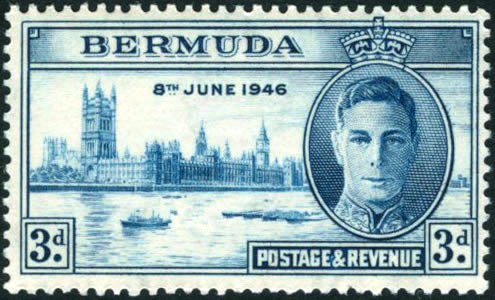
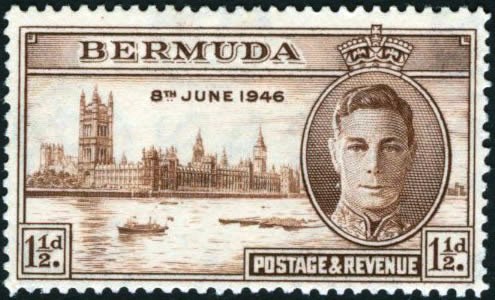
1946. June. Bermuda generally and Bermuda's yachtsmen in particular welcomed the return of the Newport-Bermuda race after an absence of 7 years. The last race, held once every two years, had been held in 1938. However, the pre-war biannual excitement of this event was this year tempered by the fact that so much hard work was required to bring Bermuda back to its prewar glory days of tourism as the island's principal revenue earner. Another aspect had to be dealt with, the fact that while other emerging or established tourism hotspots in the USA, from where Bermuda derived most of its tourists, had long had privately owned automobiles to facilitate tourism, Bermuda still then relied solely on old fashioned and appreciably slower horses and carriages. The arrival of the American sailors who had recently raced from Newport to Bermuda, who were used to going by car, was a stark reminder that Bermuda needed some drastically different thinking from tourism and government bodies for the introduction of modern means of transport in Bermuda.
1946. June. The second Bermuda Floating Dock, which had been stationed in Bermuda since 1902 and was of tremendous assistance, particularly during the War Years 1939-1945, was sold and left Bermuda. The dock was referred to officially as Admiralty Floating Dock No. 1 (AFD1) sometimes now as the “Bermuda Dock”. AFD1 is a “floating graving” type floating dock designed by Clark & Standfield for the British Admiralty and built by the famous naval firm C.S. Swan and Hunter Ltd, Wallsend. In the “floating graving” type dock, there are three separate pontoons each bolted to the continuous sidewalls on either side. Self docking was accomplished by unbolting the centre pontoon and sinking the dock allowing the centre pontoon to rise up. The pontoon was then reattached at the higher level and then raising the dock, thus lifting the centre pontoon clear of the water. A similar process could be applied to the other two pontoons, one at each end. Access to the underside of the sidewalls for repair was by careening. The dock was launched in February 1902 and completed June 1902. She cost £226,000. She was taken to Montevideo. Note that this dock should not be confused with the first Bermuda dock, which was designed by Campbell in 1869.
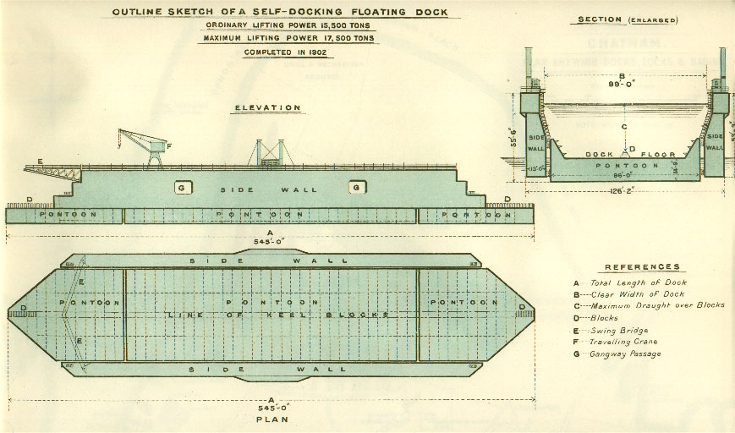
2nd Admiralty Floating Dock in Bermuda 1902-1946
1946. July 4. A British Admiralty vessel that sailed from Alexandria, Egypt on May 15 in the company of tugs Warden and Reward, towing Admiralty Floating Dock AFD 5, arrived in Bermuda.
1946. July 20. In New York. The New Yorker magazine. on page 66, wrote that "Bermuda is coming to life again as a vacation resort; hotels reopening, and American tourists, around six hundred a week are checking in. Prices have, of course gone up considerably. Scotch whiskey is abundant. Tells about the U.S. Army and Navy installations. About 15,000 men were stationed there during the war. These men were easier with their money than peacetime tourists. With the American forces and ships from many lands tying up at the port, the island had an abnormal boom, and also a general feeling of acceleration, which is probably not welcome. The most tangible sign of this is the coming of cars. Tells about the restriction of cars.".
1946. September 1. The long-term ban on private cars and motor vehicles in Bermuda was finally lifted. Exceptions had been made for American and British military vehicles during and after World War 2. Automobiles for civilians had been banned for over 40 years. However, a limit was imposed on private cars of one per household, in effect to this day.
1946. September 3. Bermuda-bound passengers who disembarked from the steamship SS George Washington witnessed a unique moment in Bermuda's history, the birth of the motorized taxi industry. New motor vehicle taxis greeted them, as well as horse-drawn carriages. All the motor taxis, with their yellow painted taxi signs on the front and side, were easily distinguished from private cars and were allocated to passengers going to the St. George Hotel. One of the very first taxis was number 1629. Ruth Simons was one of the first women taxi drivers.
1946. The Bermuda Library Act 1946 was enacted. It created the legal foundation for the establishment of a national public library based on subscriptions and fees, under the control and management of a government Minister in a new Government department to be known as the Libraries Department. It also appointed a Management Committee and Head Librarian.
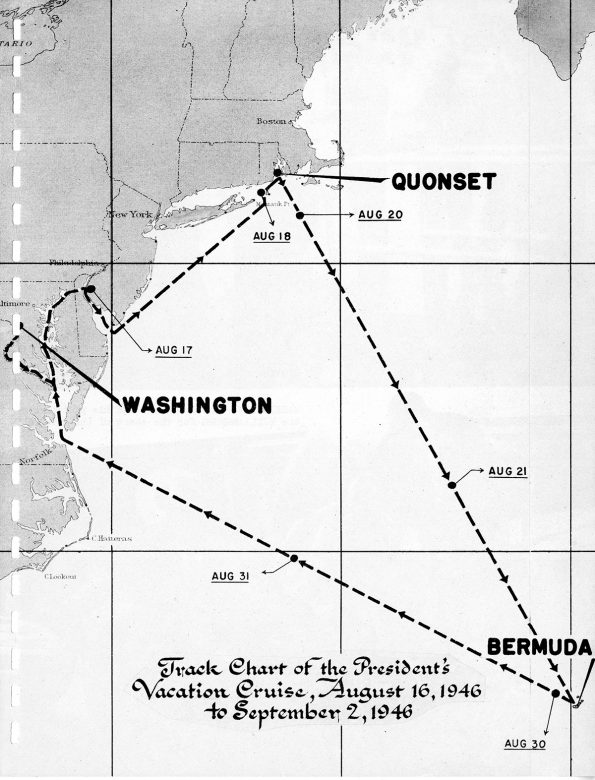 1946. August 22. President
Harry Truman of the USA arrived in Bermuda on the presidential yacht USS
Williamsburg (built in 1930) for a week-long, unscheduled informal stay. See how
it came about, originally unplanned, in https://www.whitehousehistory.org/a-journey-into-nowhere.
1946. August 22. President
Harry Truman of the USA arrived in Bermuda on the presidential yacht USS
Williamsburg (built in 1930) for a week-long, unscheduled informal stay. See how
it came about, originally unplanned, in https://www.whitehousehistory.org/a-journey-into-nowhere.
He swam, fished and toured the island by automobile. His yacht became known as the floating White House.
Originally a private yacht, the “Williamsburg” served as a US Navy gunboat during World War Two [1939-1945]. Following the Allied victories over the Axis powers, the 243-foot “Williamsburg” became Mr. Truman’s official yacht until the end of his administration in 1953.
On August 16, 1946 Mr. Truman [1884-1972] had embarked on a cruise aboard the “Williamsburg” — his first real non-working vacation since the former Vice-President assumed office on April 12, 1945 on the death of Franklin D. Roosevelt.
The USS “Williamsburg’s” first stop was the Naval Air Station at Quonset Point, Rhode Island. While in Rhode Island, the President visited the Naval War College at Newport.
But as the ship prepared to leave Quonset Point, a bad storm broke out and rather than sailing further north as planned, President Truman suggested sailing to Bermuda. The ship contacted the State Department to obtain permission from the British authorities to visit Bermuda with a minimum of formalities — what Mr. Truman called “fuss or feathers.”
When the ship arrived in Bermuda on this day, Governor of Bermuda Ralph Leatham boarded the “Williamsburg” to call on President Truman. Later that afternoon President Truman took a carriage ride to Government House and spent several days on the island swimming, sunning and fishing. The President told Sir Ralph “that he has come to Bermuda because he wants rest and quiet. He [told me] that he would appreciate anything that I could to do to assure that his wishes are respected.” During the week he spent on the island, Bermudians treated the President with the gracious nonchalance they are renowned for; the famous visitor toured the island, went on fishing trips and walked the streets of Hamilton to and from the Anglican Cathedral for a Sunday service without once being mobbed. He also took a small tour of the island with staff from the US Naval Operating Base at Port Royal Harbour. “We have deemed it a great honour that you chose Bermuda for your holiday and hope that its restful beauty has lived up to your expectations,” Sir Ralph told President Truman when the “Williamsburg” left Bermuda on August 30.
“We shall always remember that you were the first President in office to visit our colony and hope that you honour us again.” In a message to Sir Ralph, President Truman said: “Everyone enjoyed our visit to Bermuda and hope to come back. Please express my appreciation to the inhabitants of Bermuda for all their courtesy,” President Truman said in a message to Sir Ralph after he returned to Washington. Although he never returned to the island aboard the “Williamsburg”, after leaving office Mr. Truman became a regular visitor to Bermuda in the 1950s and ’60s.
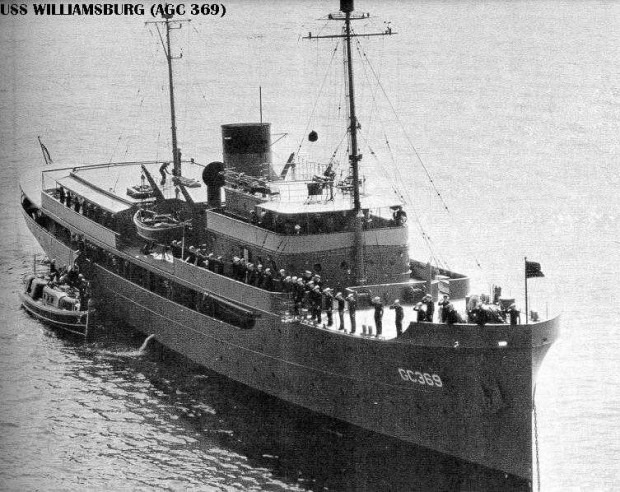
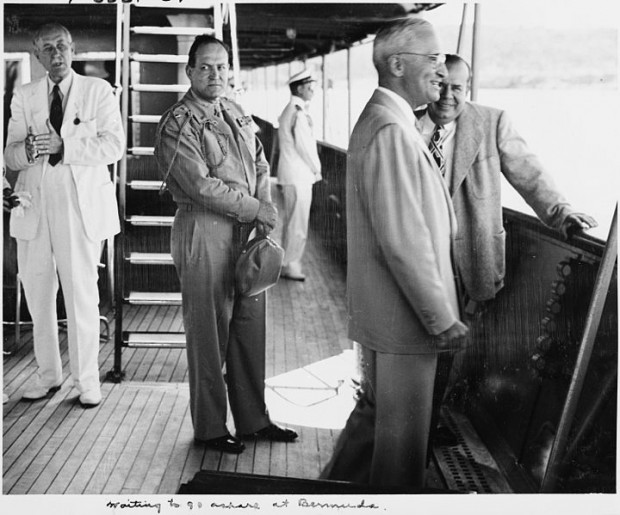
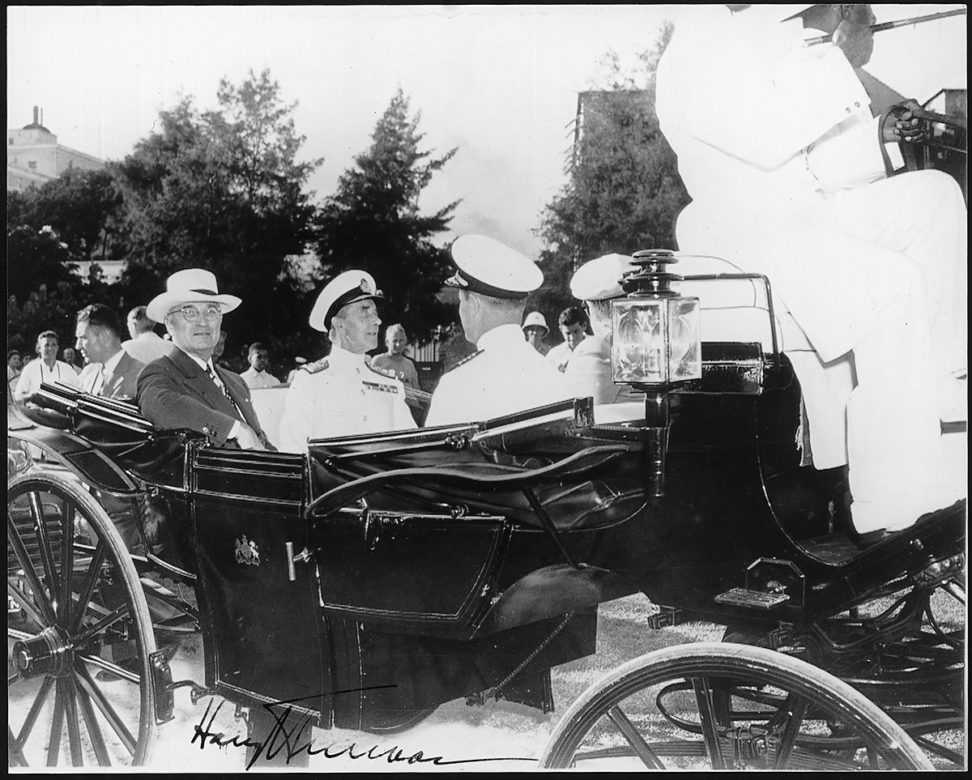
1946. A cedar blight began to destroy what eventually became 98 percent of all cedar trees in Bermuda. When they went, so too did the "singers" - the noisy but lovable cicadas that inhabited their branches and made a distinctive nightly sibilant buzzing sound. It was later determined that the blight had been caused by the accidental introduction of American pests contained in shipments of the massive American construction of its two military bases in Bermuda.
1946. The Bermuda Track and Field Association was founded.
1946. End of the Bermuda Volunteer Rifle Corps (BVRC). It was replaced by the Bermuda Rifles. The newly-renamed unit was issued with a unique new cap badge. It can be seen from the image below.
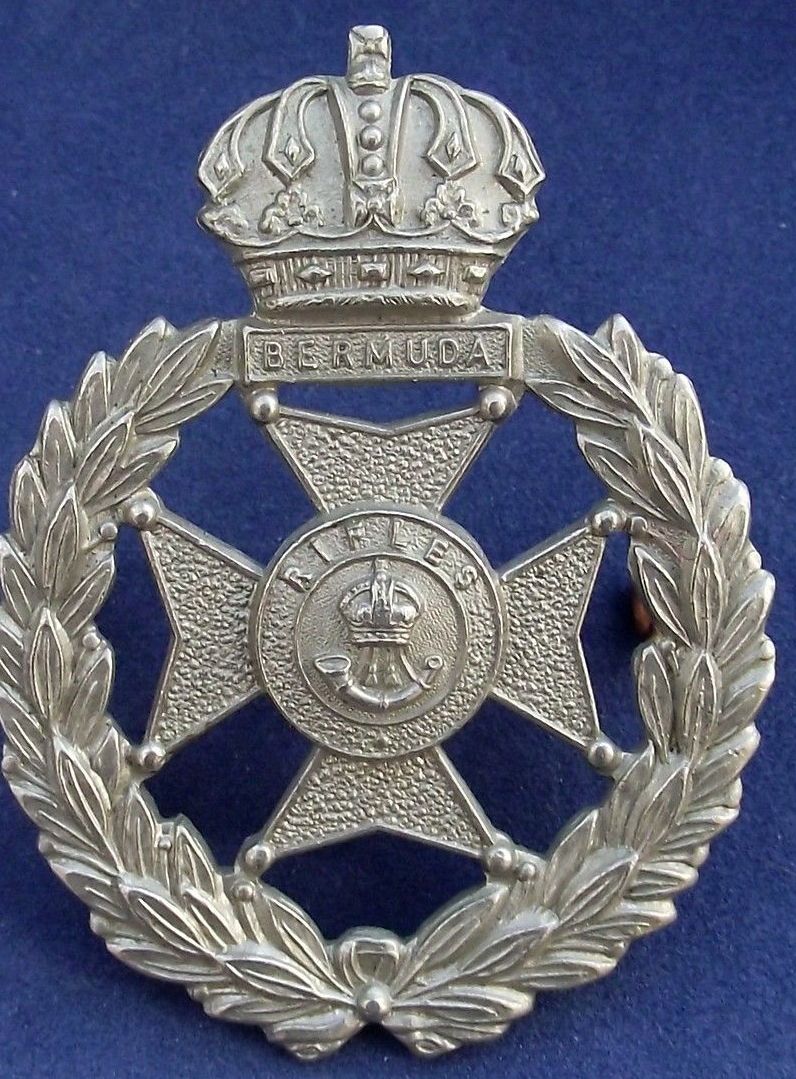
Bermuda Rifles insignia
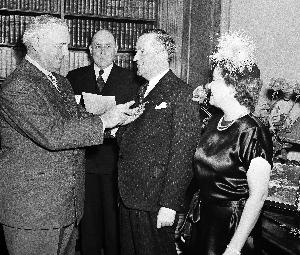 1946. November 30.
Senior
Representative of British Intelligence, Sir William Stephenson or code name
"Intrepid", who helped to trap German spies and agents in the US (Stephenson
was the wartime British security coordinator for
the Western Hemisphere) received
the Medal for Merit, highest honour the United States can grant a
non-citizen, in a New York ceremony. (See
AP photo at right). Major-General William J. Donovan
presented
the medal, with Col.
G. Edward Buxton, wartime assistant OSS director, background, Mary Simmons,
or Lady Stephenson as she became
later. Sir William eventually settled in Bermuda.
Sir
William retired in 1964 and moved into a suite at The Princess with his
wife. They eventually moved into a home in Paget were he lived until he died
at the age of 93 in 1989. The
hotel was closed at the start of the war. It was re-opened by the British
Government with the nickname, "Bletchley in the Tropics" after
Bletchley Park, the English country house where the "Enigma" code
was broken. The Hamilton Princess Hotel was the censors' headquarters,
the base
for intense intelligence operations for the British Government during the
Second World War. The hotel was the
operations centre for twelve hundred secret agents, experts, scientists and
linguists in the former Adam Lounge, dubbed Room 99, from 1940 to 1945. It
was chosen because of because of it's strategic geographic location. Working
out of a two-storey wooden building, the Gazebo Lounge and the Adam Lounge,
the Gold Lounge today, the men intercepted all postal, telegraph and radio
traffic between the Western Hemisphere and Europe. Flying
boats to Darrell's island would drop off packages which were delivered by
launch to the Princess dock. The mail was sorted in the present-day Gazebo
Lounge area before being sent over to the Adam Lounge to check all the
details. The parcels were then searched by the Imperial Censorship staff for
microdot messages that could have been sent by German spies. The men would
decode the secret correspondence, extract the letters from the tightly
sealed envelopes and put them back without anyone knowing.
1946. November 30.
Senior
Representative of British Intelligence, Sir William Stephenson or code name
"Intrepid", who helped to trap German spies and agents in the US (Stephenson
was the wartime British security coordinator for
the Western Hemisphere) received
the Medal for Merit, highest honour the United States can grant a
non-citizen, in a New York ceremony. (See
AP photo at right). Major-General William J. Donovan
presented
the medal, with Col.
G. Edward Buxton, wartime assistant OSS director, background, Mary Simmons,
or Lady Stephenson as she became
later. Sir William eventually settled in Bermuda.
Sir
William retired in 1964 and moved into a suite at The Princess with his
wife. They eventually moved into a home in Paget were he lived until he died
at the age of 93 in 1989. The
hotel was closed at the start of the war. It was re-opened by the British
Government with the nickname, "Bletchley in the Tropics" after
Bletchley Park, the English country house where the "Enigma" code
was broken. The Hamilton Princess Hotel was the censors' headquarters,
the base
for intense intelligence operations for the British Government during the
Second World War. The hotel was the
operations centre for twelve hundred secret agents, experts, scientists and
linguists in the former Adam Lounge, dubbed Room 99, from 1940 to 1945. It
was chosen because of because of it's strategic geographic location. Working
out of a two-storey wooden building, the Gazebo Lounge and the Adam Lounge,
the Gold Lounge today, the men intercepted all postal, telegraph and radio
traffic between the Western Hemisphere and Europe. Flying
boats to Darrell's island would drop off packages which were delivered by
launch to the Princess dock. The mail was sorted in the present-day Gazebo
Lounge area before being sent over to the Adam Lounge to check all the
details. The parcels were then searched by the Imperial Censorship staff for
microdot messages that could have been sent by German spies. The men would
decode the secret correspondence, extract the letters from the tightly
sealed envelopes and put them back without anyone knowing.
1946. For the first time in Bermuda’s history, a petition, signed by the Executive Committee of the Bermuda Workers’ Association on behalf of its members and “the great majority of the underprivileged and suffering inhabitants of Bermuda”, was submitted directly to the Colonial Office in Great Britain, requesting an investigation into a litany of grievances relating to Bermuda, including the restricted franchise, segregation and limited occupational opportunities for Bermudians. The document was hand-delivered in London by Dr. E. F. Gordon, the founder and President of the Bermuda Workers’ Association, an organisation which had its genesis in pay disputes involving Bermudian workers at the United States Bases and whose membership had by this time grown to almost five thousand strong. The Colonial Secretary’s reply came in the form of a strongly-worded document (labelled Command Paper 7093 and sent to the Governor, Admiral Sir Ralph Leatham, K.C.B.), which recommended that the Legislature should examine the local problems alluded to in the petition with a view to making positive and progressive revisions to the colony’s long-standing discriminatory laws and practices.
1946. The Bermuda Industrial Union (BIU) was formed from the membership of and to replace the BWA.
1946. British South American Airways launched a London- Azores - Bermuda - Jamaica service. It was operated by Avro Lancastrian converted war-time bombers with all the flying crew former Royal Air Force pilots and personnel.
1946. Established by President Harry Truman to honour those who assisted the United States during the War, the Medal of Honour was awarded to Bermuda resident, Sir William Samuel Stephenson, CC, MC, DFC, the great spymaster.
1946. December 21. A letter sent on November 18 of that year by Captain Harald Lange, ex German Navy, who had been incarcerated at the Naval Operating Base for nine months between 1944 and 1945, arrived at the Somerset Bridge home of Bermudian Catherine (Kate) Perinchief. It led to the pair exchanging letters. Captain Lange had returned to Germany after the end of the war. Harald Lange was the captain of the U-505, which the US Navy had captured on June 4, 1944, and brought to Bermuda.
1947. January. The Royal Navy completed the transport from Alexandria, Egypt, to Bermuda via Gibralter, of Admiralty Floating Dock (AFD) no 5. Vessels that pulled her included the Admiralty tugs Warden and Reward. It was part of the post-war British military withdrawal from Egypt. This floating dock had an illustrious history. In her, many of the world's most famous warships of that time recovered from World War 2 wounds. She arrived in Bermuda to replace the aging previous floating dock that had been there for generations and had performed with distinction in the Battle of the Atlantic off Bermuda in that war. AFD 5 was to spend more than four years in Bermuda before being towed to Britain in 1941 with the closure of the Bermuda Dockyard.
1947. Arrival in Bermuda as new residents of Sir Harold Mitchell, then one of the world’s wealthiest men, and his wife Mary Pringle.
1947-1949. The Newspaper
Sydney Morning Herald observed
that during this post-war two-year period all of the leading hotels in Bermuda
passed into British hands. Billy Butlin, of Butlin’s Limited amusement
park and holiday camp group; along with Louis Jackson, of British National Films
studios, and others, had acquired the Princess hotel, Pembroke, Hamilton. Lady
Yule (jute heiress and operator of the British National Films studio), with
Jackson, acquired the Belmont Manor Hotel, Warwick, Bermuda, and the Inverurie
Hotel. John Moores (of Littlewoods
Pools) acquired the Elbow Beach Surf Club. The British-based consortium [headed
by Sir William Stephenson, Canada, but who had much to do with Bermuda through
his World War 2 development as a spymaster and organizer of the British censors
network in Bermuda ] had, through the Bermuda Development Company
(BDC), had taken control of the Castle Harbour Hotel, Bermuda, the Bermudiana
Hotel, overlooking Hamilton Harbour, the St George Hotel Beach and Golf Club,
and the Mid-Ocean Club residential club.
1947. Insurance tycoon Cornelius Vander Starr of USA, previously in China and Panama, first visited Bermuda to establish as a Bermuda-incorporated company his American International group operations, later known as AIG. This arrival of a large US corporation that became a Bermuda-incorporated company was unprecedented and required enactment of a special new piece of Bermuda legislation, the American International Company Limited Act of 1947. The Act created an exception to Bermuda's local ownership requirement and exempted AIG from taxes on income that came from outside Bermuda. Later, Starr and AIG executives were very largely responsible for then-unique Bermuda laws and regulations, modeled on those originally established for AIG and later thousands of others that so hugely favored Bermuda-incorporated insurers that Bermuda not only became a global center for the offshore insurance industry but also spawned and hosted a vast number of other Bermuda-registered AIG and other operations.
1947. March 18. Bermuda Aviation Services Ltd was incorporated under an Act of Parliament bearing the firm’s name. It originally provided aviation-related services to what was the Bermuda's Civil Air Terminal (now LF Wade International Airport), including passenger handling, weather updates and flight plans, and was authorised to act as an agent for the airlines serving Bermuda. (But over the seven decades since, BAS has evolved into something completely different, a group of companies offering broad-ranging expertise from air conditioning and energy efficiency to elevator servicing and auto repairs. On its website (www.bas.bm), BAS makes this bold claim: “The wide range of skills and depth of knowledge within the group of companies enables BAS to solve any challenge that a business might face.” BAS could stake a claim to having the broadest corporate skill-set of any domestic company listed on the Bermuda Stock Exchange. The group includes CCS Group — infrastructure cabling, cloud services and enterprise networking; Besco — energy management systems, fire detection and security systems, mechanical, electrical and plumbing engineering; Integrated Technology Solutions — audiovisual solutions, window treatment, digital signage; EffTech — heating, ventilation and air-conditioning solutions and maintenance; fire and safety systems; Otis Bermuda — elevator supply, maintenance and retrofits; escalators and moving walkways; BAS-Serco — facilities management and commercial cleaning; Weir Enterprises — automotive servicing and diagnostics; industrial and commercial radiator repair. BAS-Serco lost the airport contract in March 2016 and BAS has also sold International Bonded Couriers but the company has expressed confidence that growth across its operating subsidiaries will replace the revenue lost. CCS has broadened its horizons by setting up a European operation in Portugal, opening the door to a much larger market. The office in Lisbon opened in 2015. Much of BAS’s transformation into a multifaceted services provider has happened within recent years, during which time BAS acquired Besco and ITS and founded Eff-Tech).
1947.
May 24. While at Palmer's Yard at Hebburn-on-Tyne, near Newcastle, England,
undergoing a refit for resumption of her service as a cruise ship between
New York and Bermuda, Bermuda's famous Furness Withy passenger liner Monarch
of Bermuda, was gutted by fire, declared a total loss and seemed destined
for scrap. She
had entered service in 1931 as a spectacular cruise ship on the
Millionaire Run from New York to Bermuda. From
November 1939 to 1946 she served as a troopship. On 10th December 1939 she
sailed from Halifax, Canada to Greenock, Scotland carrying Canadian
soldiers. These were the first Canadian soldiers to land in Britain at the
start of the Second World War. On the 14th April 1940 the Monarch of
Bermuda participated in the landing of British forces at Narvik in Norway.
In July 1940 she sailed in convoy from Greenock, Scotland with an escort of
British and Polish warships to Halifax, Canada landing there on the 13th
July 1940.This convoy was transporting priceless royal treasures from Wawel
Royal Castle in Poland as well as millions of dollars of gold bullion from
the Bank of England to be deposited in the Bank of Canada for safekeeping
during the Second World War. On the 5th - 7th May 1942 she participated in
the Allied landings against the Vichy French in Madagascar. On the 27th
November 1942 she was in Liverpool to embark troops for the action against
Vichy French arriving in Oran, Algeria on the 6th December 1942. On the 3rd
July 1943 the Monarch of Bermuda boarded troops destined for action in
Operation Husky which was the Allied invasion of Sicily and landed them at
Pachini on the 17th August 1943. In 1946 she was used to transport Canadian
War Brides across the North Atlantic. Possibly because of her proud record,
the
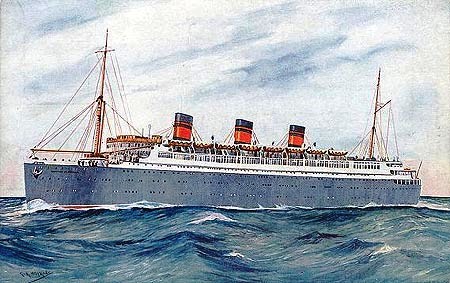
End of Monarch of Bermuda on May 24, 1947
1947. The Mid Ocean News newspaper – published as a daily in those days – was incorporated by a special Act of Parliament, becoming the Mid-Ocean News Company Inc.1947. The Bermuda legislature resolved that Cup Match would take place on the Thursday and Friday before the first Monday in August. This was the first year this would happen and has been observed since then.
1947. September 28. The Royal Dutch/Shell Group established its Bermuda-incorporated office.
1947. October 14. Bermuda Sky Queen downed. She was the former Pan Am Boeing 314 Capetown Clipper (NC 18612), renamed Bermuda Sky Queen when she was taken over by non-scheduled carrier American International Airlines and put on the Poole UK) to New York route, via Foynes and Gander Lake. Most of the passengers were British delegates going to the United Nations. After severe and sustained high winds, the aircraft landed in the North Atlantic, near a combined weather and warship. Passengers were transferred to the ship in heavy seas via a line but the aircraft collided with the ship. Still afloat but a hazard to shipping, she was finally sunk by gunfire from the same American warship, the U. S. Coast Guard cutter Bibb. It was a combination ocean station patrol and search and rescue operation that brought Bibb and her crew international recognition when, while operating on Ocean Station Charlie, the Bermuda Sky Queen was forced to make a landing during a gale with high winds and in rough seas when the flying boat ran low on fuel. The Bibb, under the command of CAPT Paul D. Cronk, had picked up an aircraft on radar heading west at 0232 (GCT) on 14 October 1947. It was the Boeing 314 flying boat Bermuda Sky Queen (NC-18612), on a trans-Atlantic flight from Foynes, Ireland to Gander, Newfoundland with 62 passengers and 7 crew on board. After flying beyond Bibb, the pilot of the flying boat, Captain Charles M. Martin, decided to return to the cutter to attempt an emergency landing because unexpectedly strong head winds had caused the aircraft to consume too much fuel for them to make landfall safely. After establishing communications with Bibb, Martin made a successful landing in the 30-foot seas at 1004 (GCT) near the cutter. After maneuvering close to the Bibb to secure a mooring line, the flying boat lost control and collided with the cutter's hull, damaging the nose of the aircraft as well as both wings and their attached floats. With the waves cresting at 30 feet and the cutter rolling 30 to 35 degrees, getting the passengers and crew of the Bermuda Sky Queen aboard Bibb proved to be a tremendous challenge. Attempting various methods, including using a pulling boat and various rubber rafts from both the cutter and the flying boat, three passengers of the latter volunteered, only two hours before sunset, to attempt to make it to the cutter using one of the flying boat's small rafts. The Bibb laid down an oil slick downwind of the Bermuda Sky Queen prior to crossing her bow to create a lee for the three men. They then began paddling towards the cutter, but the seas were too great. As they cleared the flying boat, Bibb drifted as close a practicable and threw lines to the men, bringing them safely aboard. This method would prove impossible for the women and children on board, so the cutter launched her motor surfboat that towed a 15-man raft to the Queen. Using that raft as a bridge between the flying boat and the motor surf boat, the Coast Guardsmen managed to save 28 persons in three trips and get them back to Bibb. On the fourth trip, the surfboat, taking on water after being battered against the hull of Bibb, began to sink. Fortunately Bibb was able to pull all 21 survivors and Coast Guardsmen on board the surfboat and in the raft to safety, leaving 22 on board the Queen. One more attempt was made with a pulling boat that night, but again the rough seas and darkness prevented their success and captains Cronk and Martin agreed to wait until the next morning to save the remaining passengers and crew. The following morning the seas had abated somewhat and Cronk ordered a rescue attempt with his personal gig. After one successful trip, the gig's engine broke down and the Coast Guardsmen once again launched a pulling boat. The pulling boat successfully rescued the remaining passengers and crew and the captain's gig finally got its engine going again and both boats were then brought back aboard Bibb. Cronk and Martin agreed that it was impossible to tow the Queen to safety and Cronk then ordered her sunk as a hazard to navigation. Obtaining permission to leave the ocean station and return to Boston with all of the souls who had been on board the Queen, the cutter arrived to a hero's welcome. The rescue demonstrated the utility and importance of the ocean station program and historian Robert E. Johnson noted that "The Bermuda Sky Queen incident must rank with the Coast Guard's outstanding rescue feats."
1947. October 19. While US Army Air Force B-29s had flown over or penetrated hurricanes and typhoons at high altitudes in the mid-1940s, the first low level (i.e., about 10,000 ft.) penetration of a hurricane occurred on 19 Oct 1947, when a 53rd Weather Reconnaissance Service (WRS) RB-29 penetrated Hurricane Love, southeast of Bermuda. This flight determined that penetrating tropical storms at lower altitudes was a reasonably safe activity, and all future penetrations were conducted at similar levels.
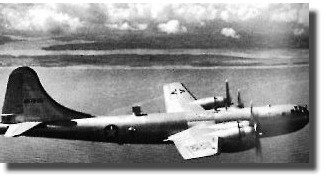
53rd WRS hurricane-hunting over Bermuda October 19, 1947. USAF photo
1947. In Britain's House of Commons a White Paper on Bermuda was debated. The matters raised in Dr Gordon's petition were referred back to Bermuda for Bermudians to deal with.1947. Two years after the end of the Second World War, the 2nd insurance company in Bermuda started, Kitson Insurance.
1947. Nurse Sylvia became the first black Bermudian to work at the Health Department and was the first Duty Nurse to become a Health Visitor.
1947. The "Lady Rodney" and re-floated, re-fitted "Lady Nelson" after being torpedoed during World War 2, resumed their service between Canada and West Indies via Bermuda, until 1952.
1947. November 18. Cable & Wireless (WI) Ltd in Bermuda introduced a facsimile service for the transmission and reception of pictures by radio.
1947. November 20. Elizabeth Alexandra Mary - later, Queen Elizabeth II - and Lieutenant Philip Mountbatten, son of Prince Andrew of Greece, were married at Westminster Abbey in London.
1947. December. Bermuda’s "beginning" as an insurance market was the quiet passage of the American International Company Limited ("AICO") Act as an exempt company, physically present from 1948. Companies had been formed earlier with an exemption from this restriction, provided that they conducted business only outside of Bermuda. But AICO’s parent, AIG, was the first significant insurance organization to take advantage of this situation. In 1947, AIG was a collection of insurance agencies around the world representing both U.S. insurance carriers and its own life insurance companies. AICO provided management services to the two pillars of AIG’s corporate structure outside of the U.S., American International Underwriters Overseas ("AIUO") and American International Reinsurance Company ("AIRCO"). AIUO was the parent of the foreign general insurance agency operations and AIRCO owned the life insurance companies and wrote internal and external reinsurance. By the middle of the decade, the group had become one of the largest private sector employers on the island with around 300 staff. At that time, the office was on Pitt's Bay Road, Pembroke, nearly opposite the Bermuda Fire and Marine Insurance Company. Later, another offshoot of AICO, American Life Insurance Company (ALICO) was established out of AICO offices. In addition to its Bermuda staff it had offices and/or representatives throughout the world including in the Caribbean. One representative, in St. Lucia, was Mr George Mallet, Minister of Tourism. Although AIG’s founder, C.V. Starr, was happy with his choice of Bermuda as a base for non-U.S. operations it would take another decade and another entrepreneur to create a second defining point for the international insurance business on the island.
1948. January. The Bermuda Legislature finally approved the importation of automobiles (motor cars) for private use. Earlier, only taxis had been allowed for importation. It was predicted at that time, wrongly, there would never be more than 1,000 licensed vehicles.
1948.
January. The Royal Naval Radio Station at the Dockyard reached its highest ever
number of staff, a total of 40.
1948.
January 30/31. The British South American Airways civilian aircraft Star Tiger
(registration G-AHNP was lost. It had 29 passengers and a crew of 6. It had logged just over 500 flight hours.
The plane was flown and commanded by Capt. B. W. McMillan, and copiloted by
both Capt. David Colby and C. Ellison, all experienced pilots.
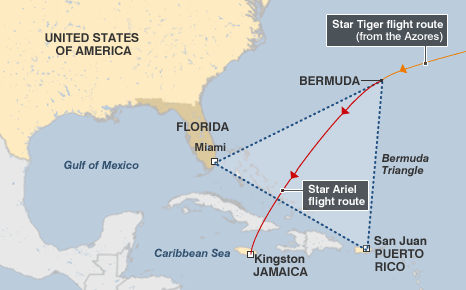
The UK Civil Air Ministry later issued this press release into the incident: "In closing this report it may truly be said that no more baffling problem has ever been presented for investigation. In the complete absence of any reliable evidence as to either the nature or the cause of the accident of Star Tiger the Court has not been able to do more than suggest possibilities, none of which reaches the level even of probability. Into all activities which involve the co-operation of man and machine two elements enter of a very diverse character (sic). There is an incalculable element of the human equation dependent upon imperfectly known factors; and there is the mechanical element subject to quite different laws. A breakdown may occur in either separately or in both in conjunction. Or some external cause may overwhelm both man and machine.
What happened in this case will never be known and the fate of Star Tiger must remain an unsolved mystery." But there are a number of clues in the official accident report that reveal the Star Tiger had encountered problems before it reached the Azores. The aircraft's heater was notoriously unreliable and had failed en route, and one of the compasses was found to be faulty. Probably to keep the plane warmer, the pilot had decided to fly the whole transatlantic route very low, at 2,000 feet, burning fuel at a faster rate. On approaching Bermuda, Star Tiger was a little off course and had been flying an hour later than planned. In addition, the official Ministry of Civil Aviation report considered that the headwinds faced by Star Tiger may have been much stronger than those forecast. This would have caused the fuel to burn more quickly. Flying at 2,000 feet they would have used up much more fuel. At 2,000 feet they would be leaving very little altitude for maneuver. In any serious in-flight emergency they could have lost their height in seconds and gone into the sea. Whatever happened to the plane, it was sudden and catastrophic - there was no time to send an emergency signal.
The Avro Tudor IV was a converted warplane that was eventually taken out of passenger service because of its poor safety record. Only BSAA continued to fly the aircraft. Gordon Store was chief pilot and manager of operations at BSAA. Much later, he said he had no confidence in the Tudor's engines. "Its systems were hopeless… all the hydraulics, the air-conditioning equipment and the recycling fans were crammed together underneath the floor without any thought. There were fuel-burning heaters that would never work."
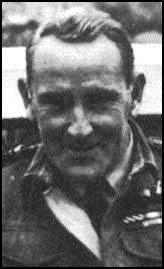 One of the passengers killed was World War 1 flying ace Arthur Coningham, born
in Brisbane, Australia, in 1895. Educated at Wellington College, New Zealand,
Coningham joined the New Zealand Army on the outbreak of the First World War.
Coningham saw service in the Pacific and the Middle East before joining the
Royal Flying Corps in 1916. Assigned to 32 Squadron Coningham scored his first
victory on 23rd January 1917. This was followed by nine more successes during
that year.
One of the passengers killed was World War 1 flying ace Arthur Coningham, born
in Brisbane, Australia, in 1895. Educated at Wellington College, New Zealand,
Coningham joined the New Zealand Army on the outbreak of the First World War.
Coningham saw service in the Pacific and the Middle East before joining the
Royal Flying Corps in 1916. Assigned to 32 Squadron Coningham scored his first
victory on 23rd January 1917. This was followed by nine more successes during
that year.
Promoted to the rank of major he was given command of 92 Squadron in June, 1918, and was credited with four more victories. After the war Coningham remained in the Royal Air Force and in 1926 he led a record-breaking 5,268 mile flight from Helwan in Egypt to Kaduna in Nigeria.
On the outbreak of the Second World War Coningham was commander of the long-range bombers based in Yorkshire. In July 1941 he went to Egypt as air vice marshal commanding the Western Desert Air Force. While involved in the Desert War Coningham pioneered the development of tactical air support for Allied ground troops.
Coningham was knighted after the El Alamein and continued to provide tactical air support for the 8th Army until they occupied Tripoli in January 1943. Later that year he was promoted to Air Marshal and directed tactical air force operations in the invasion of Sicily and Italy. In January 1944 Coningham was recalled to England where he helped plan the air support for the D-Day landings in France. The following year he was given command of Flying Training Command. Coningham retired from the Royal Air Force in 1947. Photo above right: Arthur Coningham.
1948. At Kindley Air Force Base, Bermuda, Sir Richard Fairey, who had founded the UK's strategically important Fairey Aviation company and had maintained both a house and yacht (HMS Evadne) in Bermuda, was awarded the US Medal of Freedom (with Silver Palm). It was for his assistance with the development of American aircraft when he was Director General of the British Air Commission at Washington, DC during World War 2. The award was made to Sir Richard by the then-Commanding Officer, Colonel Thomas D. Ferguson, on behalf of the President of the USA.
1948. Arrival in Bermuda of the ferryboat and tender Chauncey M. Depew, a much-used (second-hand) vessel that ultimately endeared herself to Bermudians until she was retired in 1970. She was a deep draft propeller steamboat suitable for coastwise service where rough water is often encountered. She was built in Bath, Me. in 1913 and named Rangeley, for the Maine Central Railroad to carry summer visitors from their railroad terminal at Mt. Desert Ferry on the Maine coast to Bar Harbor and other way stations on Mt. Desert Island. At that time her forward deck was closed in up the level of her second deck and her hull and superstructure were painted a glistening white. As this traffic decreased by reason of the automobile and improved highways, the Rangeley was sold in the mid '20s to the Hudson River Day Line, which changed her name to Chauncey M. DePew, after the famous politician of that name. After many years of operation on the Hudson River, and after being taken over by the U.S. Government during the war, she finally found her way to her passenger excursion service at Bermuda. In her final days she was towed to New York and sold for scrap.
1948. April 26. A pioneering transatlantic route was started by Cuban airline Compańķa Cubana de Aviación S.A.1995. between Havana and Madrid (via Bermuda, the Azores and Lisbon) using Douglas DC-4 Skymaster aircraft. The DC-4 was Cubana's first four-engine aircraft, and it required five cockpit crew members to operate (captain, first officer, flight engineer, navigator and radio operator). The DC-4 that started the transatlantic route had a pressurized cabin and was christened "Estrella de Cuba" (CU-T188 see photo below). A second DC-4 was christened "Estrella de Oriente" (CU-T397) and replaced the DC-3s on Cubana's Miami route. It was also used on the Bermuda route. By then the name of the airline had been changed to Compańķa Cubana de Aviación S.A. A majority share in the airline was then held by Pan American Airways.
Photo courtesy Compańķa Cubana de Aviación S.A.1995.
1948. May 1. Trans
Canada Airlines commenced Bermuda service. For
the tourism heads of the Bermuda Government, it was the opportunity they
had long sought to market.
The Trans Canada Air Lines service began on a twice-weekly basis, operating
Canadair Four North Star aircraft (see photo), with one schedule
operating to and from Montreal and
the other to and from Toronto. Earlier that day, at a ceremony at Montreal,
the originating point of the new service, members of the Canadian Government
and international aviation representatives met on the tarmac to inspect the
40-seater Canadair North Star aircraft, the first-ever such large passenger
aircraft to be built entirely in Canada. In the Montreal ceremonies prior to their inaugural departure to Bermuda on
the North Star carrying the registration CF-TFK were Dr. E. P. Warner,
President of the International Civil Aviation Organization; the Hon. Lionel
Chevrier, Canada's Minister of Transport; Mr. R. C. Vaughn, CMG, a Director of Trans Canada Airlines and the
President and Chairman of the Canadian National Railroad. Also on the aircraft were the Hon. Ernest Berfrand, Canada's Post Master
General; Mr. Gordon R. McGregor,
President of Trans Canada Air Lines; Mr. W. F. English, Vice President,
Operations, Trans Canada Air Lines; Mr. A. C. McKim, Trans Canada Air Lines'
Vice President, Traffic; Mr. W. S. Thompson, Director of Public Relations
for Trans Canada Air Lines; and Sir William Hildred, Director-General of
IATA. As press representatives on board the plane, which had a flight-time
of five hours from Montreal and arrived at 4.30 pm. Present were well-known personalities of Canada
in prominent newspapers and radio stations.
On its arrival in Bermuda, the inaugural flight was met at the Civil Air Terminal of Kindley Field by the Wor. Leon Fox, Mayor
of St. George's and an official party of senior Bermuda Government
representatives and other dignitaries. To commemorate the arrival of the
distinguished Canadian visitors, the Governor of Bermuda, Admiral Sir Ralph
Leatham, welcomed them to Government House at an official reception held in
their honour. In those halcyon days of 1948 the airline advertised its one
way fare from/toBermuda at the fixed rate of C$85, with the round-trip at C$153. The round-trip
excursion fares were introduced to promote winter travel. Also in its
published tariff, the airline noted that tickets sold in Canada were subject
to a 15 percent tax and that all outward bound passengers from Bermuda were
subject to a Bermuda departure tax of twelve shillings and sixpence. Some of the above is mentioned in the
book "It Seems Like Only Yesterday: The First 50 years of TCA"
(now Air
Canada) by Philip Smith.
1948. May 11. Cable & Wireless in Bermuda
switched operation of civilian Air/Ground services from Morse telegraph to
radiotelephony.
1948. Bermuda Air Tours Ltd.
was established.
Formed by
Bermudian Flight Lieutenant Hugh Watlington, DFM, RAF, who during World War
2, flew bombers.
1948. A
Parliamentary Committee set up in Bermuda presented a Paper to the House of
Assembly, recommending the gradual extension of the franchise and the
measured expansion of opportunity in the Public Service for the black
population.
The Committee also favoured the continued segregation of the
races, but urged equally good facilities for Blacks and Whites.
1948. Sir John Cox, MCP, became
Speaker of the Bermuda House of Assembly.
1948. Yousuf
Karsh, an Armenian-born Canadian photographer whose work is featured in some of
the world’s most prestigious galleries, arrived in Bermuda for a short visit,
with his wife Estrellita. Karsh was born in Armenia in 1908 but took
refuge in Canada 16 years later after his family fled Turkish genocide in their
homeland. He achieved international acclaim for the 1941 image of Churchill —
which appeared on the cover of Life magazine — and went on to
photograph scores of dignitaries and celebrities including the Queen and Martin
Luther King Jr.
1948. The Building Authority was
established to regulate building development. It was the forerunner of the
Department of Planning.
1948. The Building Authority
established the first building standards and regulations in Bermuda.
1948. August 30. Death at Doctor's Hospital, New York, of
British-born Bermudian Major Reginald Woodfield Appleby, CBE,
VD, born on 18 September 1865, one
of the founders of what became Appleby, Spurling and Kempe. He was a
British-Bermudian lawyer who practised in Bermuda. He served as a major in the
Bermuda Volunteer Rifle Corps (BVRC) during the First World War and was a
member of Bermuda's Legislative Council. Reginald
Appleby was born at Portsea Island, Hampshire, England, in
1865
to George Walton Appleby of Durham and his Bermudian wife Agnes
Sterry Tucker of Tankfield, Paget
East, Bermuda. His parents had married at St. Paul's Church (Church of
England), Paget, on 8 September 1859. His father, at the time, resided in
Pembroke, Bermuda, and was an officer in the 26th (Cameronian)
Regiment of Foot. The regiment then served as part of the Bermuda Garrison from
1854 until October 1859. Reginald had three brothers and a sister. His mother
was born in Pembroke, Bermuda, on the 5 May 1839, the daughter of Benjamin
Jennings Tucker (appointed Commissioner of Pilotage in December 1840, and July
1843) and Catharine Dickinson Tucker. The Tucker family had been prominent in
Bermuda since Daniel Tucker was appointed Governor in 1616. The Jennings
family of Bermuda included the privateer Henry Jennings who died in
1745. Reginald Appleby's mother died in 1870
and his father remarried, to Drusilla Matthews, his
former servant who had been with the family when his first wife was alive. George
and Drusilla gave Reginald several half-siblings. Reginald Appleby married Edith
Mary Gosling[6] at
St. Paul's Church, in Paget, Bermuda, on 18 September 1899, and they had a
daughter, Prudence Tucker (1905–1976), later Prudence Pearman. The family
lived in Westmoreland, Pembroke Parish,, Bermuda. 1948. American International
set up offices in Bermuda after being
incorporated in Bermuda in
December 1947, initially on Pitts Bay Road, Pembroke, opposite the Bermuda Fire
and Marine Insurance Company Ltd. (See December 1947)
1948. Establishment by a
group of mostly-back Bermudians of the
Association for Bermudian Affairs (ABA).
Members who did not object to
being publicly identified included Hilton and Georgine Hill, Carol Hill, Eva
Robinson, Fred Barnes, Yvonne Blackett and David Critchley, the only white
member. The ABA convened at regular intervals and tried to find a way to end
local social, business and commerce racist problems. One result was the
paper titled An Analysis of Bermuda’s Social Problems. To try to
avoid further racial problems in Bermuda, the group had the document printed
in Canada and it avoided showing them by name. One objective was to rid
Bermuda of the segregationist policy at Bermuda's movie houses. To help
enforce their views members of the group handed out leaflets condemning the
racist practice and entered the movie houses separately, deliberately
seating in the area reserved for whites. There was an attempt made by two
directors of the theatre to allow a favored few black Bermudians to sit in
the white section but this was rejected by the ABA.
1948. The Bermuda Post Office issued this Perot
Centenary stamp.
1948. The British flagged ship
Leicester - formerly the SS Samesk - was in tow off Bermuda.
SS Leicester being
towed off Bermuda 1948. October 18. The manager
of Bermuda's Belmont Manor Hotel stiffly requested the U.S. Navy to make the
hotel "off bounds" for enlisted men.
Rear Admiral Austin K. Doyle,
the U.S. commandant, even more stiffly replied that he would put it off
bounds for officers too. Said he: "The customs of my country do not
permit discrimination between officers and men in public places."
1948. The USS Rochester was
based in Bermuda for a period,
at the US Navy's Naval Operating Base in
Southampton Parish.
USS Rochester in
Bermuda, 1948 I948. Two women candidates,
Mrs. Hilda Aitken and Mrs. Edna Wadson, were voted in as the first two
female members of the House of Assembly,
representing the parishes of
Smith’s and Paget respectively. Four years after women were at last allowed to vote in Bermuda, Mrs. Aitken
and Mrs. Edna Watson became the first two women elected to Bermuda’s
Parliament under the new legislation. Hilda Aitken was elected
the first woman MP, followed a day later by
Edna Watson.
1948.
This unusual souvenir of Bermuda was made available in some stores.
1948 Bermuda
pillow cushion 1949.
January 17. Almost a year to the day after the loss of Star Tiger, the
airliner Star Ariel of British South American Airways was lost. 1949. February. It was
announced by the Royal Navy Dockyard in Bermuda that its Royal Navy Radio
Station, earlier with 40 members of staff, would close down.
1949.
February. Valentine's Day. The 19-knot Queen of Bermuda, having survived the
war, returned to the Bermuda run (and
sailed on it until, when deep into maritime old age, she was sold to scrappers
up in Scotland in late 1966). She had served throughout World War 2 and
thereafter as a troopship carrying soldiers back to India and the Far East. She
had been refitted to some
of her pre-war glory before bringing her post-war American tourists from New
York to Bermuda. She
provided a much-welcomed economic boost to the Bermuda tourist trade, just
beginning to get re-established following the end of World War 2. She was owned
by the Furness Bermuda Line and had been refitted from her war-time roles.
1949.
May 15. Cable & Wireless closed down its high frequency direction-finding
station on Town Hill, Smith's Parish, at the same time as it ended all its
telegraph Air/Ground services.
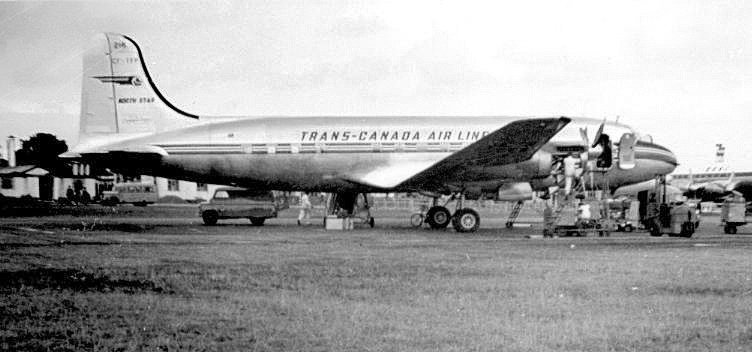
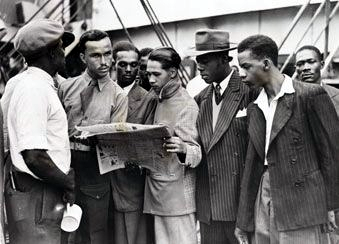 1948. June. Arrival at
Tilbury, England, of the ship HMT Empire Windrush with 500 mostly Jamaicans aboard.
The former German
troopship had set sail from Kingston with the first wave of West Indian
guest workers answering a British government advertisement offering cheap
transport to the mother country to help fill the pressing postwar labour
shortage. Many of the migrants had served in the RAF and other forces during
the Second World War. But at the time (subsequently amended) no mention was made in BBC reports that the last
port of call for the ship before London was Bermuda. And that aboard were a
group of Bermudian stowaways. 139 passengers of the 1,027 on board later
gave Bermuda as their last place of residence. The ship had been plagued with engine trouble
early in the journey having first to divert from Kingston to Cuba; and then
to Grassy Bay off the Dockyard. And after a false overnight start it was
forced to return and dock in Hamilton. Bermudians went all out to show
hospitality to passengers and crew with total support from Dr E. F Gordon. A
major social event, with plenty to eat and drink was a dance on the old
Unity Patio in Happy Valley. And when the West Indians filtered back to
their ship, some adventurous young Bermudian men followed suit. Among them
was a now, very successful South Shore, Warwick businessman who had a
harrowing experience hours before the ship docked at Tilbury. He and one
other Bermudian jumped overboard, hoping to avert the authorities by
swimming ashore. He survived and returned home in a more legal way a couple
of years later. Six other stowaways who managed to escape the authorities
upon landing, melted into the British way of life like the other migrants.
Photo above:
Empire Windrush in
Bermuda, June 1948.
1948. June. Arrival at
Tilbury, England, of the ship HMT Empire Windrush with 500 mostly Jamaicans aboard.
The former German
troopship had set sail from Kingston with the first wave of West Indian
guest workers answering a British government advertisement offering cheap
transport to the mother country to help fill the pressing postwar labour
shortage. Many of the migrants had served in the RAF and other forces during
the Second World War. But at the time (subsequently amended) no mention was made in BBC reports that the last
port of call for the ship before London was Bermuda. And that aboard were a
group of Bermudian stowaways. 139 passengers of the 1,027 on board later
gave Bermuda as their last place of residence. The ship had been plagued with engine trouble
early in the journey having first to divert from Kingston to Cuba; and then
to Grassy Bay off the Dockyard. And after a false overnight start it was
forced to return and dock in Hamilton. Bermudians went all out to show
hospitality to passengers and crew with total support from Dr E. F Gordon. A
major social event, with plenty to eat and drink was a dance on the old
Unity Patio in Happy Valley. And when the West Indians filtered back to
their ship, some adventurous young Bermudian men followed suit. Among them
was a now, very successful South Shore, Warwick businessman who had a
harrowing experience hours before the ship docked at Tilbury. He and one
other Bermudian jumped overboard, hoping to avert the authorities by
swimming ashore. He survived and returned home in a more legal way a couple
of years later. Six other stowaways who managed to escape the authorities
upon landing, melted into the British way of life like the other migrants.
Photo above:
Empire Windrush in
Bermuda, June 1948.
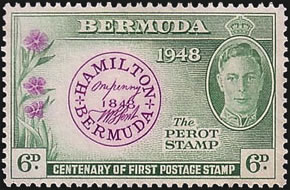
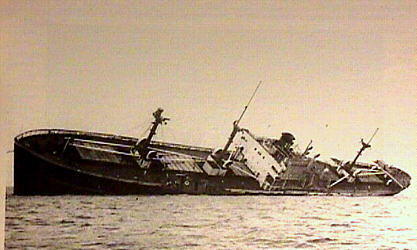
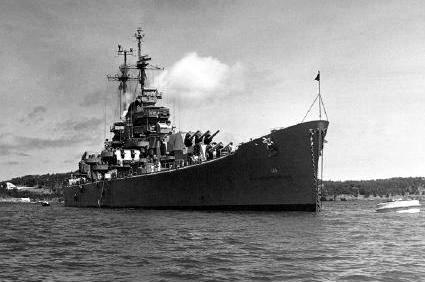
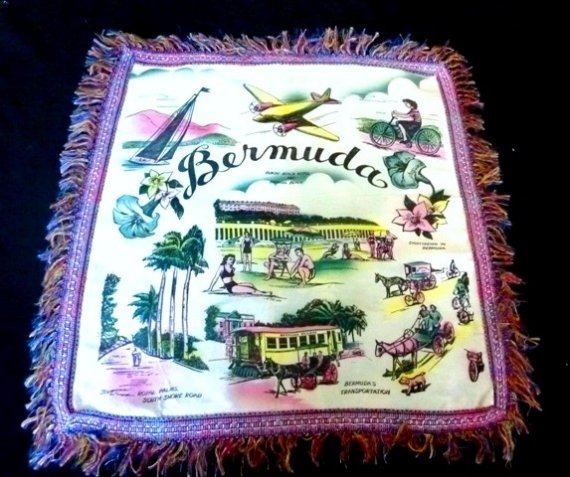
1949. June 20. A Paget
architect reported seeing an object "spherical in shape and brilliantly
silver in colour" speeding across the sky above the Island heading due
south. The architect, his wife and two friends watched the object for five
minutes from the garden of a South Shore house. The sphere was seen to decrease
in velocity and, when at a position about 80 degrees off the horizon in a line
due south, it disappeared straight upward in a matter of seconds. A later US Air
Intelligence report on the sighting (dated July 11) concluded that due to the
shape of the object no accurate estimate of the altitude or speed could be
determined, but considering its position in relation to cloud banks it was at
least 10,000 to 15,000 feet above the surface of the ocean (rough estimated
altitude 30,000 feet or higher). Investigators quickly seized on what seemed to
be a plausible and entirely down to earth explanation for that sighting:
meteorologists at Kindley Air Force Base at the East End had released a
high-altitude weather balloon into the skies above Bermuda at precisely 6pm on
June 20, just five minutes before the Paget architect reported seeing the
spherical UFO. But the Kindley weather officer, who provided calculations
charting the balloon's trajectory for US Air Intelligence, disagreed. In a
written submission to investigators, he argued that observation of the balloon
from Paget would have been impossible.
1949. Bermuda lost forever
and said goodbye to the one-track Bermuda railway, the most expensive
train ever built.
It began in the early 1930s and once brought trains right up to the pier
for bigger ships. The train carried millions of tourists in its eighteen years. It was
sold to Guyana, then still British Guiana, in 1948 and shipped in 1949. The
shipment included two freight railcars along with all the rolling stock and most
of the rails. (They were used in Guyana for nearly 25 years until the
country’s passenger service ended in 1972, but some carriages were saved and
used for storage).
1949. The
law firm operated by Major Reginald Appleby in Hamilton since 1898 that became
Appleby & Spurling in 1938 when Major Appleby was joined by partner Dudley
Spurling, became Appleby Spurling & Kempe when William Kempe joined the
practice following his service in World War 2.
1949. Arrival in Bermuda of
new Governor Lieutenant General Sir Alexander Hood (1888-1980), with his
wife Lady Hood and daughter Miss Rosemary Hood.
He was a
doctor who had ended a military career with honour. He had joined Royal Army
Medical Corps in 1912
. He served World War I in France and Belgium 1914-1918. He was Assistant
Director, Pathology, India 1929-1930, then Deputy Director of Medical
Services, Palestine and Transjordan 1938-1939. He was in World War II
1939-1945, became Director General of Army Medical Services 1941-1948;
retired 1948
; then appointed Governor of Bermuda until his retirement in 1955. Sir
Winston Churchill commented 'I like Hood' and Lord Moran wrote of him: 'Hood
is a full-blooded red-faced Scot with no neck to speak of, as if he had
stepped down from a Raeburn portrait for our correction. After his
retirement as Governor, he bought a home in Bermuda.
Governor Sir
Alexander Hood 1949. October 5. The
Orchids Club of Bermuda began, founded by
Mrs. Ivy Ming Swan, a chambermaid at the black-owned and -operated Imperial
Hotel in Hamilton. Mrs. Dorothy Minors was the treasurer. An unhappy
sociological climate gave birth to the Orchids, turbulent times of both
racial and religious prejudice throughout Bermuda.
1949.
The Bermuda Beekeepers'
Association (BBA) was formed.
1949.
December. British engineer Frederick
Charles Eveleigh, who had begun the project in January 1947, finished
his replacement, this time with Portland cement, of the original
timber Grey's Bridge that in 1850 connected Ireland Island with Boaz
Island. It was known thereafter as the Grey's Bridge Causeway. Eveleigh used
a total of 7,496 cubic yards of concrete.
1950.
Argus Insurance was established through a need for medical insurance and it
also formed the Somers Isles Insurance Company.
1950. Major Cuthbert
Brook-Smith (he appears in the Army Lists as C B Smith but used the surname
Brook-Smith) - pictured below - was posted to Bermuda as GSO II to the Governor and
Commander-in-Chief of Bermuda.
He was there as a staff officer (not in any
way attached to the Duke of Cornwall's Light Infantry posted there later).
He had been commissioned into the King's Shropshire Light Infantry (KSLI) on
30th January 1936. He was appointed temporary Lt Col on 28th June 1945
but reverted to his substantive rank of Major shortly afterwards. In
Bermuda, he married a Bermudian, the daughter of Mrs. Helen Arnell. (His
brother-in-law was Jack Arnell). He relinquished his appointment in Bermuda
in 1952 and returned to 1 KSLI. He took over command of the Battalion in
Kenya. It is believed that he accidentally walked into an ambush that had
been set on a track to lure the Mau Mau, but instead he was shot by members of his
own unit and died instantly. He was buried in Kenya.
1950. 1st February. The
Bermuda Reserve (Police) Constabulary was formed officially (and legislated on July
1, 1951).
In the late 1990s it was renamed the Bermuda Reserve Police.
1950. The Marketplace grocery
store in Bermuda changed hands again, from the Pimental family to Mr.
Fernance Perry.
In
1960, he formed a limited liability company, Piggly Wiggly Limited. In 1964,
he decided to expand in a westerly direction and built the Somerset Piggly
Wiggly Plaza. The following year the decision was made to expand again, this
time in an easterly direction, and the Shelly Bay Piggly Wiggly Plaza was
built. Nine years later in 1974, the Heron Bay Piggly Wiggly Plaza was
completed.
1950. June. Two Cable &
Wireless operators from Bermuda were among those volunteers who made up the
staff of the Telcom unit in Korea during the Korean war.
They wore battle
dress with the 'Telcom' shoulder flash and blue berets of World War 2. They
were attached to the British Commonwealth Brigade Headquarters in Seoul,
South Korea. They were not the only people from Bermuda who fought in that
war. At least ten native Bermudians served in the United States Forces, some
with medals awarded them for their bravery.
1950. The Royal Canadian
Navy (RCN) and the United States Navy (USN) formally agreed to coordinate and
standardize HF/DF activities ashore. Jointly, it was called the
Atlantic HF/DF Network. It was to have an impact in Bermuda, later. This
initiative resulted in the integration of all Canadian and US stations into two
networks which would provide mutual support for the common objective of maritime
warfare. The two networks were comprised of five RCN stations: Coverdale, NB;
Chimo (1949-52), Frobisher Bay, N.W.T (1952-1966).; Gander, Nfld; Bermuda
(1963-1993), Gloucester, Ont. and nine USN stations. On the west coast, that arm
of the Net was called the Eastern Pacific Network and consisted of one RCN
station at Masset, British Columbia and eight USN stations. Coverdale was also
designated as the Alternate Net Control station for the Atlantic Network. The
primary Atlantic Net Control station was located at Cheltenham, Maryland. In
actual practice, Coverdale performed this function about 25% of the time just to
keep the operation up and ready.
1950. July 1. The US Naval
Operating Base in Bermuda was decommissioned and became, instead, the US Naval
Station.
1950. 1st August. The Bermuda
Red Cross was established as a branch of the British Red Cross Society,
initially as a nursing reserve. At its opening ceremony were Governor Alexander
Hood, Patron; Lady Hood, President; Mrs W. D. Tucker, Hon Vice President;
Mrs Winifred Rogers, Hon Vice President; Rev. Keith Harmon, Director (Rector
of Devonshire and Chaplain to the Prospect Garrison); Mrs.
Thomas Hall, Secretary; Roderick A. Ferguson, Treasurer; Dr. W. E. Talbot,
Medical Officer; Mrs. Betty Frith, Jr.
1950. September 9. After
announcement of the closure in months of the Royal Naval Dockyard, Bermuda,
the MV "Doric" left the Royal Naval Dockyard, Bermuda, with 50
teenage Bermudian apprentices on board,
bound for the Portsmouth Dockyard in
the UK to complete their training.
1950. The Town of St. George, Bermuda's first
capital (1616-1815) was made a special historic area. Development was
strictly regulated so the original character of the town remained largely
intact, unlike parts of the City of Hamilton, the later capital.
1950. The Radio Society of
Bermuda (RSB) was founded,
as an amateur radio (HAM) group. members,
both in Bermuda and overseas. Membership
is open to any licensed radio amateur for an annual fee for local residents
and overseas members. Address is PO Box HM 275, Hamilton HM AX, Bermuda.
1950. Visit to Bermuda of HMS
Challenger, a modern-day Royal Navy survey ship
tasked to survey the
Pacific Ocean after World War II. Bermuda was her first stop after
leaving from Chatham, UK. Her survey took two years.
1950. Jeffrey
& Sons (now on Cemetery Road, Pembroke, since 2012) was established,
in Dockyard, by Frederick Jeffrey Sr. Initially it was a mill shop, later
becoming a hardware business on Front Street, and then a custom blind
manufacturing retail store near Shelly Bay, in Hamilton Parish. For many years
it was run by the late David Jeffrey, who introduced custom roll shades and
exterior storm shutters. He started a lot of the local production and bringing
in the storm shutters. The company also offers servicing and maintenance of its
shutters and those installed by other businesses. Today it makes, sells and
installs storm shutters.
1950. A small number of black Bermudian businessmen
formed the Bermuda Tourist Association (BTA) and displayed great initiative in
trying to get black Americans to visit Bermuda. A booking office for black
Bermuda guesthouses like Cannville, Archlyn Villa and the Imperial Hotel was
opened in New York, and advertising was devised to lure black tourists. A
leading light in this endeavor was Hilton Hill, a local photographer turned
public-relations man, who saw tourism not only as a lucrative opportunity for
black Bermudians but also as a means of raising political consciousness in the
black community. He arranged the arrival in Bermuda of the black American actor
James Edwards (star of the 1949 movie about racial prejudice in the U.S. army,
Home of the Brave) to Bermuda to showcase the colony to American blacks.
1950. Discovery on an inner
Bermuda reef of a treasure ship from the Spanish colonial period, the San
Pedro.
She was part of the Nueva Espana fleet which carried manufactured
goods from Spain to the New World and returned with gold, silver, coins,
jewels and other valuable products. In November 1596, en route from
Cartagena, Columbia to Cadiz, Spain, and laden with treasure, the 350-ton
merchant ship was wrecked on Bermuda’s inner reef. She was discovered by
veteran shipwreck diver, Teddy Tucker and Robert Canten. Among the treasures
they recovered was a gold pectoral cross with seven emeralds, said to be one
of the most valuable pieces of jewellery retrieved from any Spanish
shipwreck. Other items included a thirty-two ounce gold bar, two small gold
ingots, a bronze mortar, a navigating instrument, a pewter porringer, tools,
Chinese ceramic, glazed pottery, French coins, an ostrich egg, pearl-studded
gold buttons and race Carib Indian weapons. It was the first major treasure
recovery as well as the most significant Tudor period find of the twentieth
century.
1950. September 10. 50 young Bermuda Dockyard
apprentices left Bermuda by ship bound for RN Dockyard Portsmouth for up
to 5 years.. Lionel Young was one of them. Their parents were there to see
them off and many of them and some of the departing apprentices cried. The
latter left on the tender and sailed away. Lionel Young had packed his guitar
for the trip. Although he claimed he was not very good, he and several other
Bermudians played together in Portsmouth as the Bermuda Quartet and The
Portsmouth Melody Makers. They performed calypso standards at parties and dance
halls across Portsmouth and in December 1952 took second prize on The
Carroll Levis Discovery Show, a talent competition on BBC Television.
1950. December 19.
Bermudian Corporal Henry E. Dowling, US Army, was killed in Korea.
In US
Army records he is listed wrongly as from the US Virgin Islands.
1951. The Mid Ocean Club,
Tucker's Town, was established as a private members Club, instead of a
luxury hotel it had been.
Situated in
picturesque Tucker's Town it offered unrivalled facilities to a strong
international community of members and their guests. Earlier, it had been
the property of Furness-Withy, via its subsidiary the Bermuda Development
Company. But despite the fact that the Mid Ocean was a highly regarded element
of Furness Withy's world-wide developments, the downturn in the global economy
in the aftermath of the Second World War convinced the company that there was no
future in either tourism or the cruise ship business. Faced with massive
refurbishment costs, it started to divest itself of various properties, and Mid
Ocean was high on the list.
By an odd turn of fate, Bermudian golfers were first
alerted to this development through an unguarded after dinner conversation in
London. Harry D. Butterfield, manager of the Bank of N.T. Butterfield and Son,
who was also chairman of the Transport Committee of the Trade Development Board,
an advisory board to the Bermuda Government, was in London on business. He took
the opportunity to spend a highly convivial evening with a long-standing
barrister friend and it was while the pair were enjoying port and cigars that
the legal man let slip that he had been consulted by Furness Withy to advise on
the disposition of their world-wide assets, including property in Bermuda.
Butterfield, later to become Sir Harry, was not a man to let the grass grow
under his feet, and he immediately set in motion a movement to raise the
necessary funds to secure Mid Ocean. There are two accounts of how he set about
it. One suggests that he spent lengthy hours that same night in placing a
long-distance telephone call to Sir Eldon Trimingham in Bermuda. The other, that
he cabled H. Jack Tucker, manager of the Bank of Bermuda, with instructions to
gather subscriptions for the purchase. It is highly likely that he did both,
discussing the options with Sir Eldon before committing to the raising of funds.
Sir Howard Trott and Edmund Gibbons then took the front positions in
negotiations with Bermuda Development Company, the Furness Withy subsidiary
which controlled Mid Ocean. They sat across the table from Lord Essington of the
steamship company in discussions that lasted many months. Golf enthusiasts had
by now pledged subscriptions totaling 105,000 pounds and at the first meeting of
shareholders on September 17, 1951, Sir Howard outlined the situation. The
Legislature had passed a bill entitled "Mid Ocean Club Limited"
authorizing a limited liability company to be formed with the power to carry on
the club and course business and to purchase the property. An agreement had been
reached between the Bermuda Development Company and a small group of members to
purchase the club, the golf course and the beaches, approximately 180 acres, for
the sum of 130,000 pounds. As a direct consequence of this purchase, leading
golf designer Robert Trent Jones was not long afterwards invited to make
suggestions for improving the course. Many of his new layouts and remodeling
work around the world have been dominated by big, bold statements, yet his touch
at Mid Ocean was light, subtle and restrained. Respecting the design of
Macdonald, he re-worked a number of tees and bunkers, enhancing a slightly
ageing masterpiece rather than indulging in invasive surgery. The result is as
good today as it was then, the course now measuring slightly longer and playable
between 5,045 and 6512 yards. Some 7,000 new trees were also planted in the
mid-fifties after many cedars were blighted by disease.
1951. On its maiden voyage,
the brand-new Furness Withy vessel, the SS Ocean Monarch -
smaller than the pre-war Queen of Bermuda but more modern,
arrived.
Frequently, when the Queen and its new sister the
Ocean Monarch happened to be in port together, there were spectacular
torch-lit impromptu carnivals, which involved the crew members wearing
outlandish costumes they had picked out in New York - and even more
decorations - for the horses, carriages and carts - to complete the effect.
1951. Wing Commander E. M.
"Mo" Ware, Royal Air Force, who had been in Bermuda in World War 2
and oversaw the creation of the Civil Air Terminal from the former Royal
Air Force station at the US base in St. David's, was
appointed Bermuda's first Director of Civil Aviation,
and from 1951 to 1978
opened up the Island to modern air travel.
1951. With the death of Mr. E.
P. Skinner, Mr. Burgess took of the running of The Skinner School, formerly
Elliott School, and re-named it Howard Academy. Mr. Edward DeJean was
imported from Canada to teach there.
1951. The Rev. John Stowe, rector
of St. Peter's Church in St. George's, Bermuda, was appointed Archdeacon of
Bermuda
in succession to Archdeacon Henry Marriott, rector of St. Paul's Church,
Paget, who retired on July 31at the age of 81, with nearly 60 years service as a
priest, 55 of them in Bermuda. The new Archdeacon served during World War 2 as a
chaplain in the Royal Navy.
1951. March 31. The Dockyard
closed officially after being in operation since 1809.
Britain handed this important military
property over to Bermuda. It
took a while for this to take effect.
The dismantling was virtually completed when the large floating dock
Admiralty Floating Dock No 5, that had arrived in January 1947 from Egypt via
Gibraltar, left Bermuda on July 11, bound for England. It was towed by the Royal
Navy tugs Wanden and Reward, with the tug Prosperous in reserve. All reached
Falmouth, England, on August 11. Most buildings were offered to the
Bermuda Government and in 1953, when the great majority of the Royal Navy left,
title of the Dockyard buildings was officially transferred to the Bermuda
Government for 750,000 pounds sterling. A limited number of buildings and other
facilities, mainly in the South Basin area, were retained by the Royal Navy
(until 1995) for the support of visiting British, Commonwealth, NATO and foreign
naval vessels calling in from time to time. They were administered by a small
permanent Royal Navy staff under the Resident Naval Officer with the rank of
Commander. The post of SNOWI (Senior Naval Officer West Indies) was established
on 29 October 1956. In June 1965, HMS Malabar was re-commissioned as Malabar
VII. Moresby House, close alongside, and the Magazine House on Boaz Island,
became a sort of Supplies and Signals center but without official accreditation.
Things were again cut back in December 1967 to a single Lieutenant Commander,
RNO (Supplies). He left, with his SNOWI post, when Bermuda as a base for the
Royal Navy was officially abolished on 1 April 1976. In 1980, the Bermuda
Government underwrote an ambitious rehabilitation scheme covering the 214 acre
site. Massive rehabilitation for civilian occupation and use began in 1982,
after nearly three decades of Bermuda Government inactivity and crimes galore
against property. In March, 1995 all remaining buildings were turned over to
Bermuda as well. To date, the restoration and conversion to public use has cost
more than $21 million in public funds and $42 million in private investment. The
Royal Canadian Navy and United States Navy continued to have a base in Bermuda
until 1993 and 1995 respectively, at separate naval bases. Now, they too have
gone.
1951. Despite the closure of Royal Navy Dockyard, Bermuda continued to play a major
role in the training of the post-war Royal Canadian Navy.
From that moment
on, the RN Dockyard was virtually a Canadian Base, and on occasion more than
30 ships and 5000 men were training in Bermuda. The Canadian Forces Liaison
Office (CFLO) was set up in Bermuda as a new approach to the difficulties
associated with training for both ships and aircraft.
1951. An Act for the preservation
of the Town of St. George in Bermuda was passed by the Bermuda legislature.
1951. Dr. Cushman Murphy of
the USA finally arrived in Bermuda from a museum in New York City, after
having been pestered for years by Samuel Ristich to do so.
Ristich had
served in Bermuda with the US Army Air Corps and had found a cahow. When
Murphy came down, he found five living cahows, believed to have been extinct
since 1650. As a direct result of Murphy's visit and unique find, Dr. David
Wingate, one of the members of the scientific team, started his breeding program for cahows on Nonsuch Island shortly
afterwards. Dr. Wingate,
later the government conservation officer, worked
to turn Nonsuch Island into a nature preserve and living natural history
museum.
1951.
Ocean View golf course was established in Bermuda.
Three
black Bermudians, Bill Pitt, Sr, Erskine Simons and George Lowe, initiated
and named it, to improve golf for black Bermudians. Before then, the course
and its functional but not luxurious clubhouse had been developed for and by
officers and men of the British Garrison stationed at Prospect. The
newcomers secured and eventually redeveloped the course.
1951. American International Company Ltd, created in
1947, became the first exempted company in Bermuda to be allowed by Bermuda
law to purchase local real estate. It acquired a building on Front
Street West, at the junction with Woodbourne Avenue, that later became known as
the American International Building.
1951. In the UK, Bermudian actor Earl Cameron appeared
in his debut film Pool of London. It was a vivid blend of social drama and love
story, the first British film showing a mixed relationship between a black actor
and a white woman.
1951. Verdmont, Smith's Parish,
with its 2.2 acres, was sold by Alan Paul Joel, last individual owner of the
historic property, to the Bermuda Historical Monuments Trust, forerunner of what
later became the Bermuda National Trust. Price paid was £ sterling 8,000.
The purchase was possible only because two of its members, Dr, Henry
Wilkinson its chairman and Mr Hereward Trott Watlington, loaned the money. A
sub-committee comprising Wilkinson, Watlington and architect Wilfred Onions was
formed to restore Verdmont and turn it into a museum. The house had fallen into
disrepair.
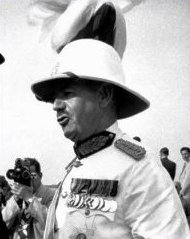
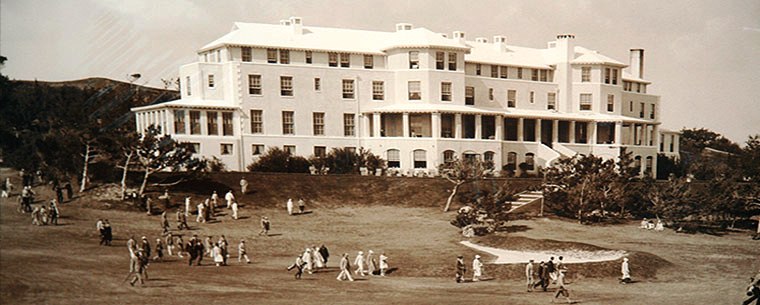
![]()
History & daily newspaper
reports
Authored,
researched, compiled and website-managed by Keith A. Forbes.
Multi-national © 2024. All Rights Reserved. Last updated 19 March 2024.